Siemens Canada Siemens Milltronics Process Instruments LR250 SITRANS LR 250 TANK LEVEL PROBING RADAR User Manual SITRANS LR250 mA HART
Siemens Canada Ltd. - Siemens Milltronics Process Instruments SITRANS LR 250 TANK LEVEL PROBING RADAR SITRANS LR250 mA HART
Contents
User Manual 2
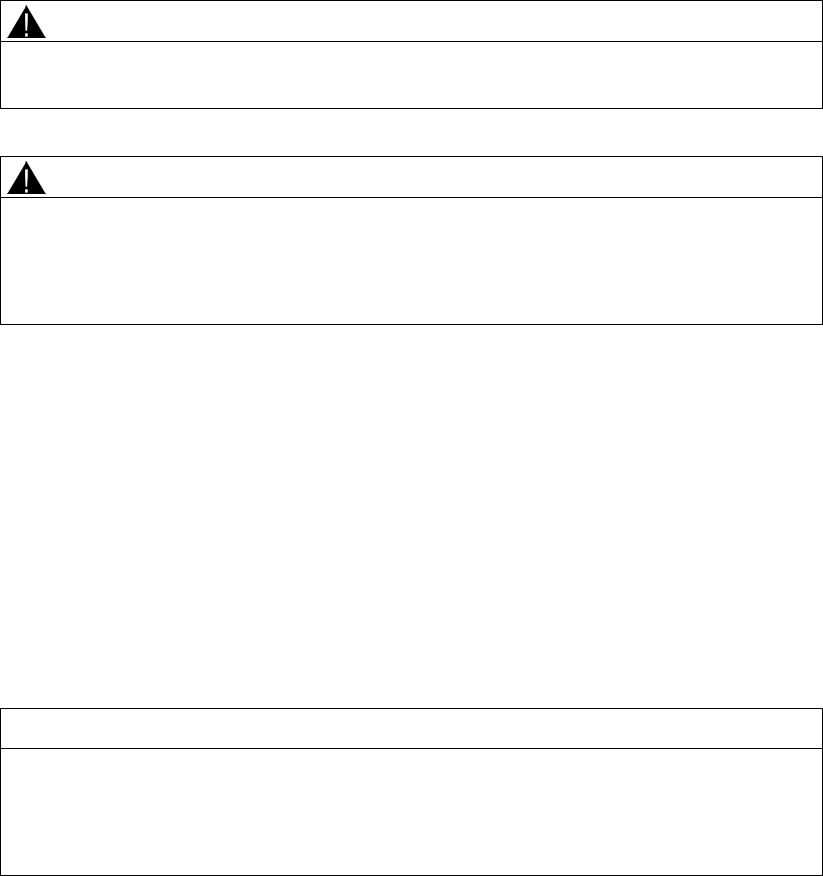
SITRANS LR250 (mA/HART)
Operating Instructions, 08/2014, A5E32220602-AC 183
Service and maintenance
9
9.1
Basic safety information
WARNING
Impermissible repair of the device
• Repair must be carried out by Siemens authorized personnel only.
CAUTION
Releasing key lock
Improper modification of parameters could influence process safety.
• Make sure that only authorized personnel may cancel the key locking of devices for
safety-related applications.
9.2
Cleaning
The radar device requires no cleaning under normal operating conditions.
Under severe operating conditions, the antenna may require periodic cleaning. If cleaning
becomes necessary:
● Note the antenna material and the process medium, and select a cleaning solution that will
not react adversely with either.
● Remove the device from service and wipe the antenna clean using a cloth and suitable
cleaning solution.
NOTICE
Penetration of moisture into the device
Device damage.
• Make sure when carrying out cleaning and maintenance work that no moisture
penetrates the inside of the device.

Service and maintenance
9.3 Maintenance and repair work
SITRANS LR250 (mA/HART)
184 Operating Instructions, 08/2014, A5E32220602-AC
WARNING
Electrostatic charge
Danger of explosion in hazardous areas if electrostatic charges develop, for example, when
cleaning plastic surfaces with a dry cloth.
• Prevent electrostatic charging in hazardous areas.
9.3
Maintenance and repair work
The device is maintenance-free. However, a periodic inspection according to pertinent directives
and regulations must be carried out.
An inspection can include check of:
● Ambient conditions
● Seal integrity of the process connections, cable entries, and cover screws
● Reliability of power supply, lightning protection, and grounds
WARNING
Maintenance during continued operation in a hazardous area
There is a danger of explosion when carrying out repairs and maintenance on the device in
a hazardous area.
• Isolate the device from power.
- or -
• Ensure that the atmosphere is explosion-free (hot work permit).
WARNING
Humid environment
Danger of electric shock.
• Avoid working on the device when it is energized.
• If working on an energized device is necessary, ensure that the environment is dry.
• Make sure when carrying out cleaning and maintenance work that no moisture
penetrates the inside of the device.

Service and maintenance
9.3 Maintenance and repair work
SITRANS LR250 (mA/HART)
Operating Instructions, 08/2014, A5E32220602-AC 185
9.3.1
Unit repair and excluded liability
All changes and repairs must be done by qualified personnel, and applicable safety regulations
must be followed. Please note the following:
● The user is responsible for all changes and repairs made to the device.
● All new components must be provided by Siemens.
● Restrict repair to faulty components only.
● Do not re-use faulty components.
9.3.2
Part replacement
If the antenna, lens, secondary O-ring, and spring washers require replacement due to damage
or failure, they may be replaced without the need for re-calibration if of the same type and size.
Replacing the antenna
Changing to a different antenna type may be performed by a Siemens authorized repair center
or personnel.
If the electronics or enclosure require replacement due to damage or failure, please ensure the
correct antenna version is used, otherwise a re-calibration will need to be performed by Siemens
authorized personnel.
Replacing the lens
1. Remove existing lens by turning it counter-clockwise until it separates from the unit.
2. Replace the O-ring between the lens and process connection with a new one.
3. Carefully thread the replacement lens, and turn it clockwise until resistance is encountered.
Do not over-tighten the lens, as this will permanently damage it.
4. For flange installation instructions, see Flanged versions (Page 35).
Note
After installation of the new lens onto the flanged enc
apsulated antenna version and before
mounting on the vessel/tank, some lenses may not appear to lie flush on the device, but this
is normal and will not impact performance.

Service and maintenance
9.3 Maintenance and repair work
SITRANS LR250 (mA/HART)
186 Operating Instructions, 08/2014, A5E32220602-AC
Raised-Face flange kits
Description
Process
connection
size
Part number
Replacement TFMTM 1600 PTFE Lens and Spring Washer
Kit for ASME B16.5 Class 150 raised faced
2"
A5E32462817
3"
A5E32462819
4"
A5E32462820
6"
A5E32462821
Replacement TFMTM 1600 PTFE Lens and Spring Washer
Kit for JIS B 2220 10K raised Face
50A
A5E32462822
80A
A5E32462823
100A
A5E32462824
150A
A5E32462825
Replacement TFMTM 1600 PTFE Lens and Spring Washer
Kit for EN 1092-1 PN10/16 type B1 raised face
DN50
A5E32462826
DN80
A5E32462827
DN100
A5E32462828
DN150
A5E32462829
Spare part kits
Description
Process
connection size
Part number
ISO2852, Hygienic encapsulated antenna Lens and silicon O-ring 2" A5E32572731
3"
A5E32572745
4"
A5E32572747
DIN11851, Hygienic encapsulated antenna Lens and silicon O-
ring
DN50
A5E32572758
DN80
A5E32572770
DN100
A5E32572772
DIN11864-1, Hygienic encapsulated antenna Lens and silicon O-
ring DN50 A5E32572773
DN80
A5E32572779
DN100
A5E32572782
DIN11864-2/3, Hygienic encapsulated antenna Lens and silicon
O-ring
DN50
A5E32572785
DN80
A5E32572790
DN100
A5E32572791
Tuchenhagen, Hygienic encapsulated antenna Lens and silicon
O-ring
Type F
A5E32572794
Type N
A5E32572795
Note
For more information about accessories such as clamps, seals and process connections,
please see the catalog on the pro
duct page (http://www.siemens.com/LR250).

Service and maintenance
9.4 Disposal
SITRANS LR250 (mA/HART)
Operating Instructions, 08/2014, A5E32220602-AC 187
9.4
Disposal
Note
Special disposal required
The device includes components that require special disposal.
•
Dispose of the device properly and environmentally through a local waste disposal
contractor.

Service and maintenance
9.4 Disposal
SITRANS LR250 (mA/HART)
188 Operating Instructions, 08/2014, A5E32220602-AC

SITRANS LR250 (mA/HART)
Operating Instructions, 08/2014, A5E32220602-AC 189
Diagnosing and troubleshooting
10
10.1
Communication troubleshooting
1. Check the following:
– There is power at the device.
– The LCD shows the relevant data.
– The device can be programmed using the handheld programmer.
– If any fault codes are being displayed see General Fault Codes (Page 192) for a detailed
list.
2. Verify that the wiring connections are correct.
3. See the table below for specific symptoms.
Symptom
Corrective action
The device cannot be programmed via the
handheld programmer. • Ensure
Write Protect (6.2.1.)
is set to the unlock
value.
You try to set a SITRANS LR250
parameter via remote communications but
the parameter remains unchanged.
• Ensure
Write Protect (6.2.1.)
is set to the unlock
value, then try setting the parameter via the handheld
programmer.
• Ensure
Access Control (6.1.1.)
is set to Read/ Write.
• Some parameters can be changed only when the
device is not scanning. Try pressing Mode to put
the device into PROGRAM mode.
If you continue to experience problems go to our website and check the FAQs for SITRANS
LR250:
Product page (http://www.siemens.com/LR250), or contact your Siemens representative.
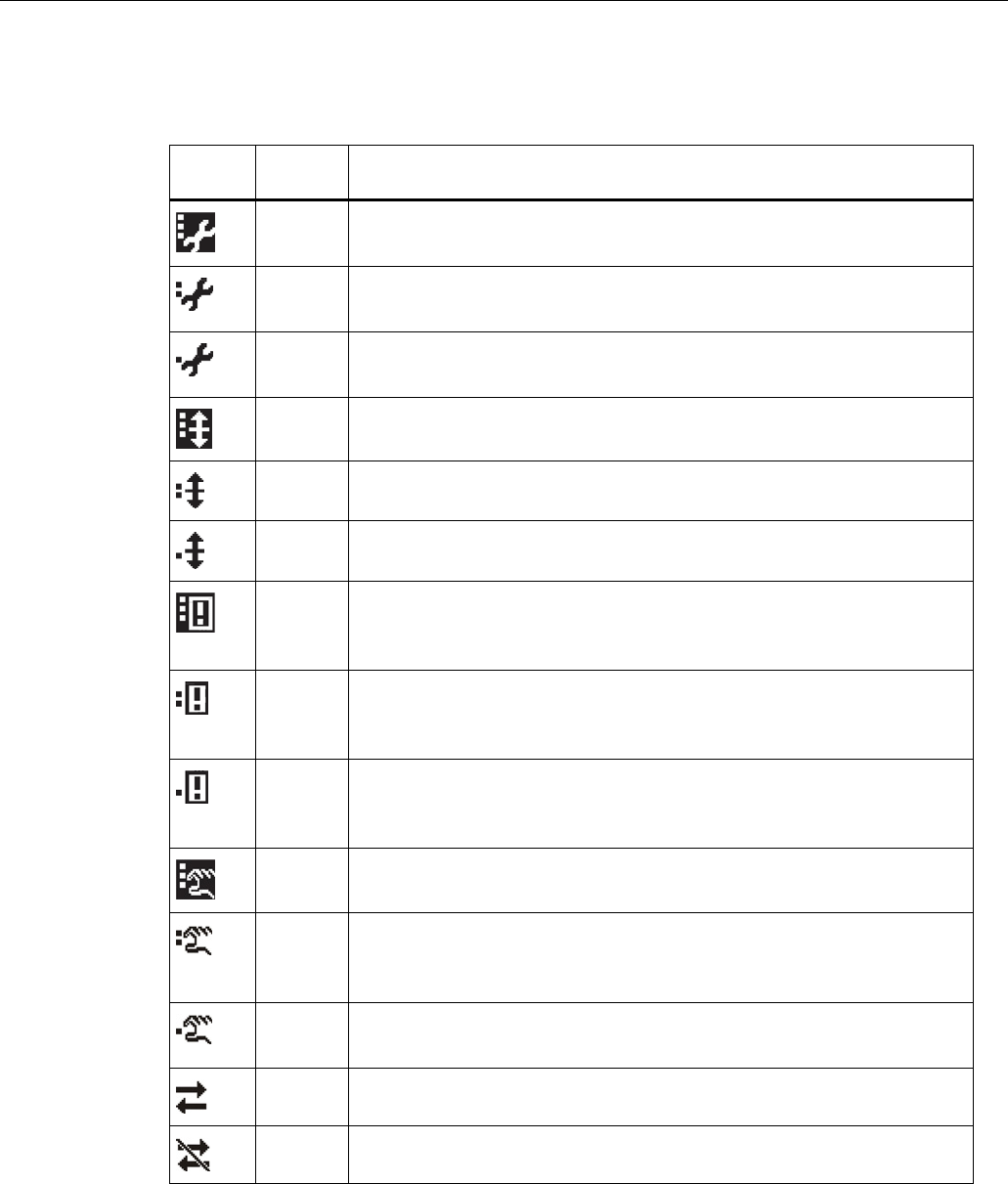
Diagnosing and troubleshooting
10.2 Device status icons
SITRANS LR250 (mA/HART)
190 Operating Instructions, 08/2014, A5E32220602-AC
10.2
Device status icons
Icon
Priority
Level
Meaning
1 • Maintenance alarm
• Measurement values are not valid
2 • Maintenance warning: maintenance demanded immediately
• Measured signal still valid
3 • Maintenance required
• Measured signal still valid
1 • Process value has reached an alarm limit
2 • Process value has reached a warning limit
3 • Process value has reached a tolerance limit
1 • Configuration error
• Device will not work because one or more parameters/components is
incorrectly configured
2 • Configuration warning
• Device can work but one or more parameters/components is incorrectly
configured
3 • Configuration changed
• Device parameterization not consistent with parameterization in project.
Look for info text.
1 • Manual operation (local override)
• Communication is good; device is in manual mode.
2 • Simulation or substitute value
• Communication is good; device is in simulation mode or works with
substitute values.
3 • Out of operation
• Communication is good; device is out of action.
• Data exchanged
• No data exchange

Diagnosing and troubleshooting
10.2 Device status icons
SITRANS LR250 (mA/HART)
Operating Instructions, 08/2014, A5E32220602-AC 191
Icon
Priority
Level
Meaning
• Write access enabled
• Write access disabled
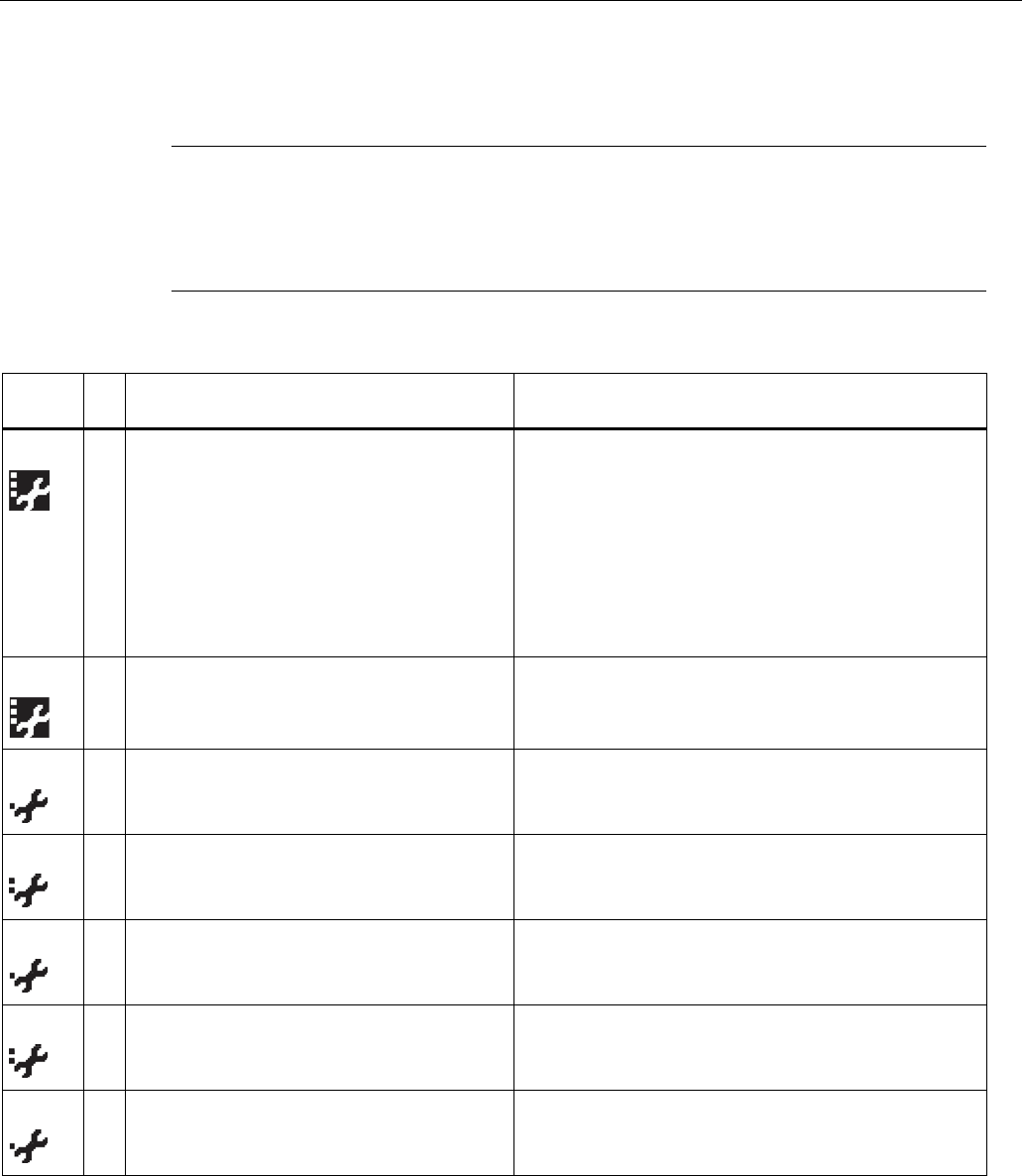
Diagnosing and troubleshooting
10.3 General fault codes
SITRANS LR250 (mA/HART)
192 Operating Instructions, 08/2014, A5E32220602-AC
10.3
General fault codes
Note
•
If more than one fault is present, the device status indicator and text for each fault
alternate at 2 second intervals.
•
Some faults cause the device to go to Fail-
safe mode (Fault 52). These are indicated with
an asterisk (*).
Code/
Icon
Meaning
Corrective Action
S: 0
* The device was unable to get a measurement
within the Fail-safe LOE Timer period. Possible
causes: faulty installation, antenna material
buildup, foaming/other adverse process
conditions, invalid configuration range.
• Ensure installation details are correct.
• Ensure no antenna material buildup. Clean if
necessary.
• Adjust process conditions to minimize foam or other
adverse conditions.
• Correct configuration range.
• If fault persists, contact your local Siemens
representative.
S: 2
* Unable to collect profile because of a power
condition that is outside the operating range of
the device.
Repair required: contact your local Siemens
representative.
S: 3
Device is nearing its lifetime limit according to
the value set in Maintenance Required Limit. Replacement is recommended
S: 4
Device is nearing its lifetime limit according to
the value set in Maintenance Demanded Limit. Replacement is recommended.
S: 6
Sensor is nearing its lifetime limit according to
the value set in Maintenance Required Limit. Replacement is recommended.
S: 7
Sensor is nearing its lifetime limit according to
the value set in Maintenance Demanded Limit. Replacement is recommended.
S: 8
Service interval as defined in Maintenance
Required Limit has expired. Perform service.

Diagnosing and troubleshooting
10.3 General fault codes
SITRANS LR250 (mA/HART)
Operating Instructions, 08/2014, A5E32220602-AC 193
Code/
Icon
Meaning
Corrective Action
S: 9
Service interval as defined in Maintenance
Demanded Limit has expired. Perform service.
S: 11
Internal temperature sensor failure. Repair required: contact your local Siemens
representative.
S: 12
Internal temperature of device has exceeded
specifications: it is operating outside its
temperature range.
• Relocate device and/or lower process temperature
enough to cool device.
• Inspect for heat-related damage and contact your
local Siemens representative if repair is required.
• Fault code will persist until a manual reset is
performed using SIMATIC PDM or the LCD interface.
S: 17
Calibration interval as defined in Maintenance
Required Limit has expired. Perform calibration.
S: 18
Calibration interval as defined in Maintenance
Demanded Limit has expired. Perform calibration.
S: 28
* Internal device failure caused by a RAM
memory error. Repair required: contact your local Siemens
representative.
S: 29
* EEPROM damaged. Repair required: contact your local Siemens
representative
S: 31
* Flash error. Repair required: contact your local Siemens
representative
S: 33
* Factory calibration for the internal temperature
sensor has been lost. Repair required: contact your local Siemens
representative
S: 34
* Factory calibration for the device has been lost. Repair required: contact your local Siemens
representative
S: 35
* Factory calibration for the device has been lost. Repair required: contact your local Siemens
representative
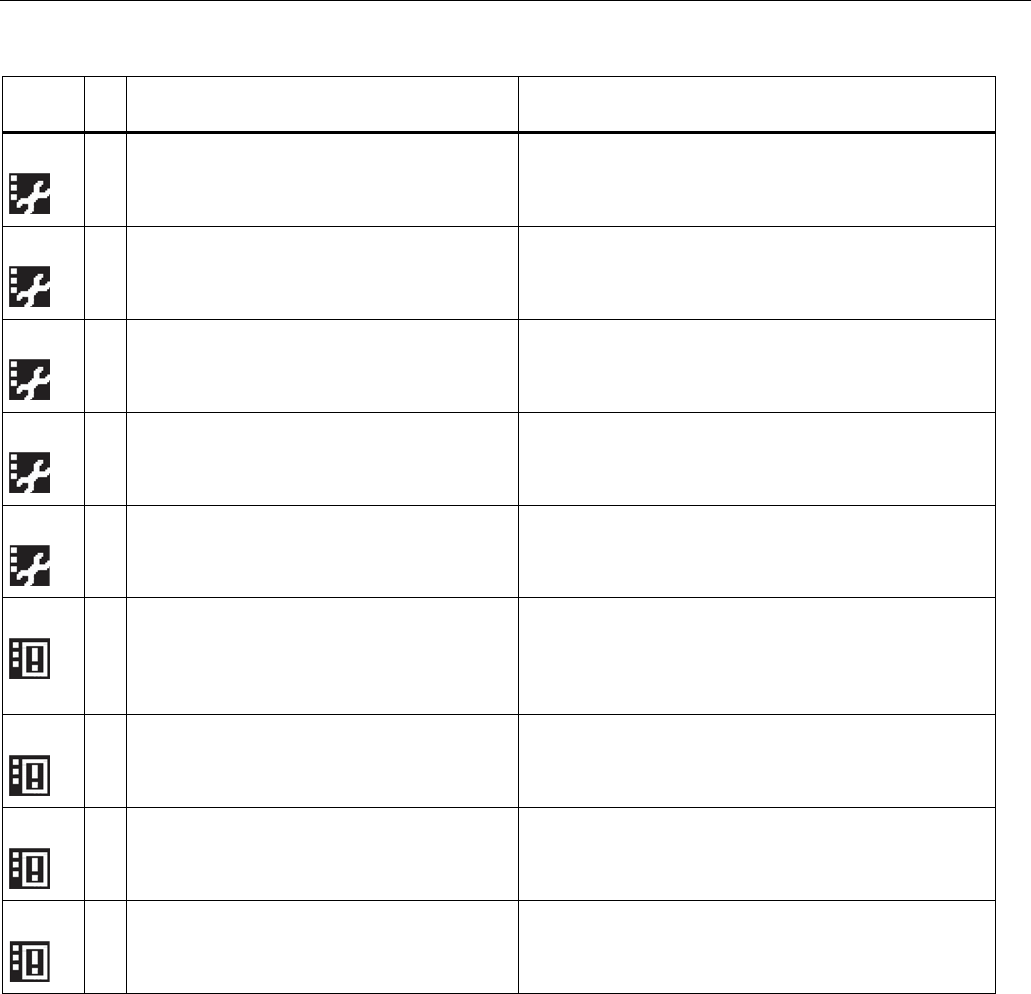
Diagnosing and troubleshooting
10.3 General fault codes
SITRANS LR250 (mA/HART)
194 Operating Instructions, 08/2014, A5E32220602-AC
Code/
Icon
Meaning
Corrective Action
S: 36
* Unable to start microwave module. Repair required: contact your local Siemens
representative
S: 37
* Measurement hardware problem. Repair required: contact your local Siemens
representative
S: 38
* Failure in the device electronics. Repair required: contact your local Siemens
representative
S: 43
* Factory calibration for the radar receiver has
been lost. Repair required: contact your local Siemens
representative.
S: 45
* No valid boot program detected: firmware
corrupt Repair required: contact your local Siemens
representative.
S: 48
* User configuration is invalid. One or more of
parameters: Low Calibration Point, High
Calibration Point, Volume breakpoints, and/or
Auto False-Echo Suppression, are set to
invalid values.
• Reconfigure the unit.
• Ensure the difference between High Calibration Point
and Low Calibration Point is not less than or equal to
zero; do a Master Reset.
S: 49
* EEPROM corrupt. Repair required: contact your local Siemens
representative.
S: 50
* EEPROM corrupt. Repair required: contact your local Siemens
representative.
S: 51
* EEPROM corrupt. Repair required: contact your local Siemens
representative.
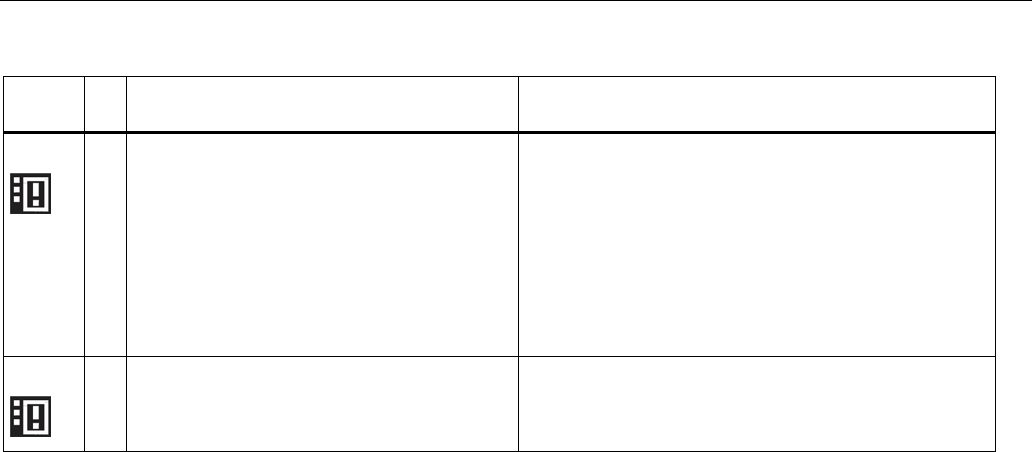
Diagnosing and troubleshooting
10.3 General fault codes
SITRANS LR250 (mA/HART)
Operating Instructions, 08/2014, A5E32220602-AC 195
Code/
Icon
Meaning
Corrective Action
S: 52
Fail-safe is activated. Possible causes:
1. hardware failure
2. memory failure
3. Fail-safe LOE timer expired– possible
causes: faulty installation, antenna material
buildup, foaming/other adverse process
conditions, invalid calibration range.
For 3:
• Correct configuration; ensure installation is correct;
• no antenna buildup;
• adjust process conditions to minimize foaming/other
adverse conditions;
• correct calibration range.
If fault persists, or for 1 and 2, contact your local Siemens
representative.
S: 53
* Configuration lost: one or more parameter
settings have been lost. This may occur after a
firmware upgrade causes user parameters to
be reset.
Restore user parameters using SIMATIC PDM.

Diagnosing and troubleshooting
10.4 Operation troubleshooting
SITRANS LR250 (mA/HART)
196 Operating Instructions, 08/2014, A5E32220602-AC
10.4
Operation troubleshooting
Operating symptoms, probable causes, and resolutions.
Symptom
Cause
Action
Display shows
level or target is out of range • check specifications
• check
Low Calibration Pt. (2.3.1.)
• increase
Confidence (2.8.6.1.)
Display shows
material build-up on antenna • clean the antenna
• re-locate SITRANS LR250
Display shows
location or aiming:
• poor installation
• flange not level
• Auto False Echo Suppression
may be incorrectly applied
• check to ensure nozzle is vertical
• ensure end of antenna protrudes from end of nozzle
• review Auto False Echo Suppression (Page 259)
.
• ensure Auto False Echo Suppression Range is set
correctly
Display shows
antenna malfunction:
• temperature too high
• physical damage
• excessive foam
• multiple echoes
• check
Current Internal Temperature (3.2.1.)
• use foam deflector or stillpipe
• relocate
• use a defoamer
• set
Algorithm (2.8.4.1.)
to
F
(First echo)
Reading does not
change, but the level
does
SITRANS LR250 processing
wrong echo, for example, vessel
wall, or structural member
• re-locate SITRANS LR250
• check nozzle for internal burrs or welds
• rotate device 90°
• use
Auto False Echo Suppression (2.8.7.1.)
• if necessary: see Auto False Echo Suppression
(Page 259).
Measurement is
consistently off by a
constant amount
• setting for
Low Calibration Pt.
(2.3.1.)
not correct
• setting for
Sensor Offset
(2.3.3.)
not correct
• check distance from sensor reference point to
Low
Calibration Pt. (2.3.1.)
• check
Sensor Offset (2.3.3.)
Screen blank power error • check nameplate rating against voltage supply
• check power wiring or source
too much load resistance • change barrier type, or
• remove something from the loop, or
• increase supply voltage
• reduce wire distance or use larger gage wire

Diagnosing and troubleshooting
10.4 Operation troubleshooting
SITRANS LR250 (mA/HART)
Operating Instructions, 08/2014, A5E32220602-AC 197
Symptom
Cause
Action
Reading erratic echo confidence weak • refer to
Confidence (2.8.6.1.)
• use
Auto False Echo Suppression (2.8.7.1.)
and
Auto
False Echo Suppression Range (2.8.7.2.)
• use foam deflector or stillpipe
liquid surface vortexed • decrease
Fill Rate per Minute (2.4.2.)
• relocate device to side pipe
• increase confidence threshold in
Echo Threshold (2.8.4.3.)
material filling • Re-locate SITRANS LR250
Reading response
slow
Fill Rate per Minute (2.4.2.)
setting incorrect
• increase measurement response if possible
Reads correctly but
occasionally reads
high when vessel is
not full
• detecting close range echo
• build up near top of vessel or
nozzle
• nozzle problem
• clean the antenna
• use
Auto False Echo Suppression (2.8.7.1.)
and
Auto
False Echo Suppression Range (2.8.7.2.)
Level reading lower
than actual material
level
• material is within Near Range
zone
• multiple echoes processed
• decrease
Near Range (2.8.1.)
(minimum value depends
on antenna type)
• raise SITRANS LR250
• ensure
Algorithm (2.8.4.1.)
is set to F (First echo)
• vessel near empty and low
dK material
• ensure
Material (2.2.3.)
selection is LIQUID LOW DK
• set
Position Detect (2.8.4.2.)
to Hybrid
• set
CLEF Range (2.8.4.4.)
to 0.5 m

Diagnosing and troubleshooting
10.4 Operation troubleshooting
SITRANS LR250 (mA/HART)
198 Operating Instructions, 08/2014, A5E32220602-AC
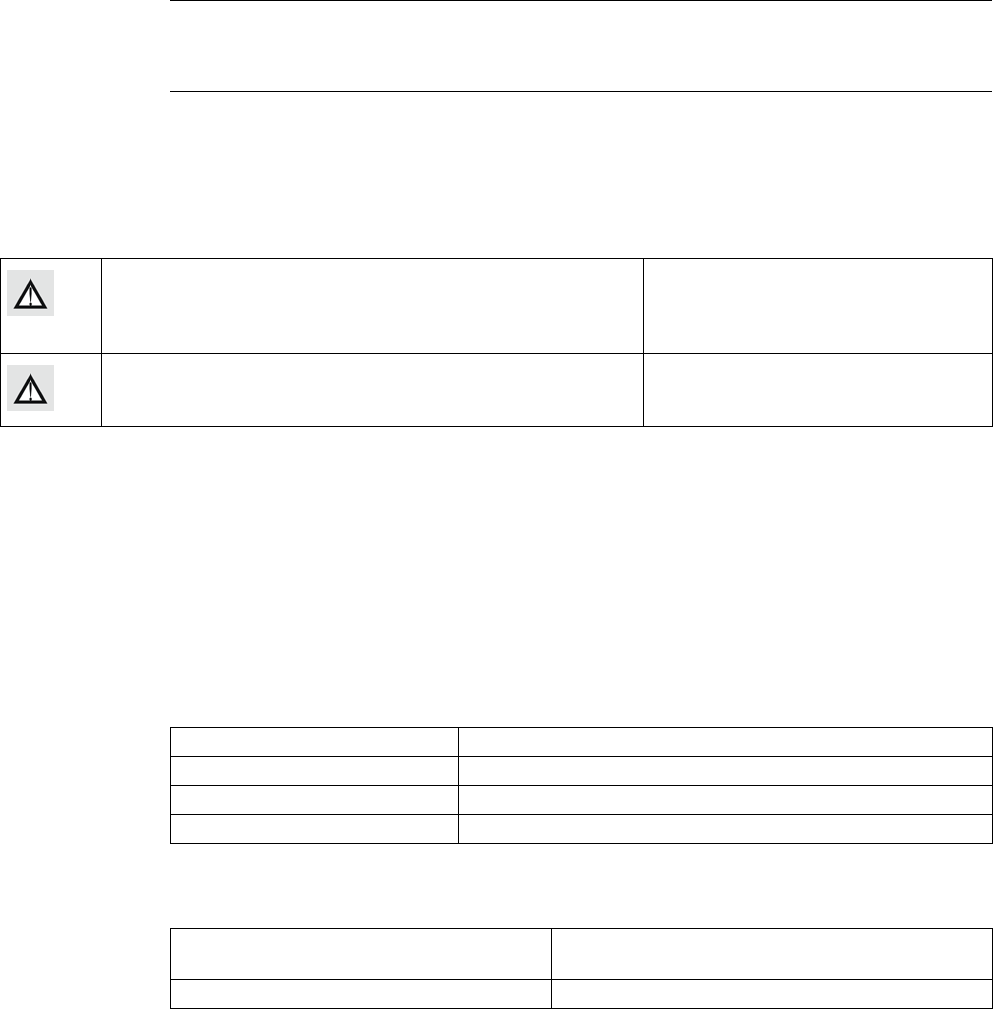
SITRANS LR250 (mA/HART)
Operating Instructions, 08/2014, A5E32220602-AC 199
Technical data
11
Note
•
Siemens makes every attempt to ensure the accuracy of these specifications but
reserves the right to change them at any time.
11.1
Power
General Purpose
Intrinsically Safe
Non-Sparking
Non-incendive (FM/CSA US/Canada only)
Nominal 24 V DC at 550 Ohm
Flameproof
Increased Safety
Explosion-proof (FM/CSA US/Canada only)
Nominal 24 V DC at 250 Ohm
● Maximum 30 V DC
● 4 to 20 mA
● Max. startup current see Startup Behaviour (Page 283).
11.2
Performance
Reference operating conditions according to IEC 60770-1
Ambient temperature
15 to 25 °C (59 to 77 °F)
Humidity
45 to 75% relative humidity
Ambient pressure
860 to 1060 mbar a (86000 to 106000 N/m
2
a)
Interference reflections
minimum 20 dB lower than the main target reflections
Measurement Accuracy (measured in accordance with IEC 60770-1)
Maximum measured error = 3 mm (0.12")1) 2) 3) including hysteresis and non-
repeatability
Frequency
K-band

Technical data
11.2 Performance
SITRANS LR250 (mA/HART)
200 Operating Instructions, 08/2014, A5E32220602-AC
Maximum measurement range4)
1.5" antenna
10 m (32.8 ft)5)
2" threaded PVDF antenna
2"/DN50/50A Flanged encapsulated
antenna (FEA)
2" ISO 2852, DN50 DIN 11864-
1/2/3, DN50 DIN11851,
Tuchenhagen Types F and N
Hygienic encapsulated antenna
(HEA)
all other versions
20 m (65.6 ft)
Minimum detectable distance
50 mm (2") from end of antenna
6)
Update time7) minimum 1 second, depending on settings for
Response Rate (2.4.1.) and LCD Fast Mode (4.9.)
Influence of ambient temperature < 0.003%/K (average over full temperature range,
referenced to maximum range)
Dielectric constant of material measured
dK > 1.6 [antenna and application dependent
8)
]
Memory
non-volatile EEPROM
no battery required
1) The statistical accuracy is typically 3 mm (0.12") 90% of the time, when tested in accordance
with IEC 60770-1.
2) Under severe EMI/EMC environments per IEC 61326-1 or NAMUR NE21, the device error
may increase to a maximum of 10 mm (0.4").
3) For 2" threaded PVDF, Flanged encapsulated antennas and Hygienic encapsulated antennas,
the maximum measured error <500 mm from the sensor reference point =25 mm (1").
4) From sensor reference point: see Dimensions (Page 209).
5) 20 m (65.6 ft) possible in a stillpipe/bypass
6) Minimum range is antenna length + 50 mm (2"). See Dimension drawings (Page 209).
7) Reference conditions:
Response Rate (2.4.1.)
set to
FAST, LCD Fast Mode (4.9.)
set to
ON
.
8) For 1.5" (40 mm) antenna, 2" (50 mm) threaded PVDF antenna, 2"/DN50/50A flanged
encapsulated antenna, and 2" ISO 2852, DN50 DIN 11864-1/2/3, DN50 DIN11851,
Tuchenhagen Types F and N hygienic encapsulated antenna the dK is limited to 3 unless a
stillpipe is used.
See Flanged horn antenna (Page 214).
See Flanged encapsulated antenna (3"/DN80/80A sizes and larger) (Page 220).
See Hygienic encapsulated antenna (2" ISO 2852 sanitary clamp) (Page 222).
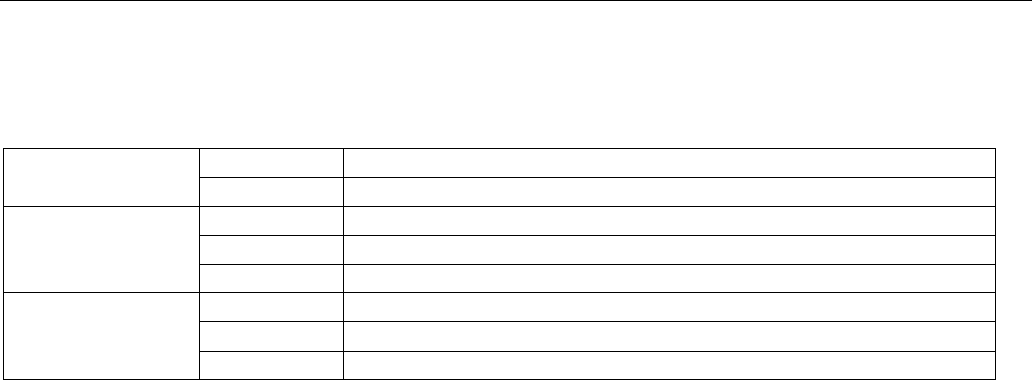
Technical data
11.3 Interface
SITRANS LR250 (mA/HART)
Operating Instructions, 08/2014, A5E32220602-AC 201
11.3
Interface
Analog output
Signal range
4 to 20 mA (± 0.02 mA accuracy) upper limit 20 to 23 mA adjustable
Fail signal
3.6 mA to 23 mA [For more details, see Fail-safe Mode] (Page 265)
Communication:
HART1)
Load
230 to 600 Ω, 230 to 500 Ω when connecting a coupling module
Max. line length
multi-wire: ≤ 1500 m (4921 ft)
Protocol
HART, Version 5.1
Configuration
Remote
Siemens SIMATIC PDM or AMS Device Manager (PC)
Local
Siemens infrared handheld programmer, or HART handheld communicator
Display (local)
2)
graphic LCD, with bar graph representing level
1)
See A.6.3 for details on version exclusions
2) Display quality will be degraded in temperatures below –25 °C (–13 °F) and above +65 °C (+149 °F).
Curve 2 (Flameproof, Increased Safety, Explosion-proof) (Page 283)

Technical data
11.4 Mechanical
SITRANS LR250 (mA/HART)
202 Operating Instructions, 08/2014, A5E32220602-AC
11.4
Mechanical
Process
connection: Threaded connection 1.5" NPT (ASME B1.20.1), R (BSPT, EN 10226-1) a) or
G (BSPP, EN ISO 228-1)
or 2" NPT (ASME B1.20.1), R (BSPT, EN 10226-1) or
G (BSPP, EN ISO 228-1)
or 3" NPT (ASME B1.20.1), R (BSPT, EN 10226-1) or
G (BSPP, EN ISO 228-1)
Flange connection (flat-face)
Materials
2, 3, 4" (ASME 150 lb, 300 lb)
DN50, DN80, DN100 (PN10/16, PN25/40)
50A, 80A, 100A (JIS 10K)
316L /1.4404 or 316L /1.4435 stainless steel
Flange connection (raised face)
Materials
DN50, DN80, DN100, DN150 (PN10/16, PN25/40)
1.4404 or 1.4435 stainless steel, optional Alloy
N06022/2.4602 (Hastelloy
®
C-22 or equivalent)
Flanged encapsulated antenna (FEA)
connection (raised face)
Materials
2, 3, 4, 6" (ASME 150 lb); DN50, DN80, DN100,
DN150 (PN10/16); 50A, 80A, 100A, 150A (JIS 10K)
316L /1.4404 or 316L /1.4435 stainless steel
Hygienic encapsulated antenna (HEA)
connection
Materials
ISO 2852 (2, 3, 4")
DIN 11851 (DN50, DN80, DN100)
DIN 11864-1/2/3 (DN50, DN80, DN100)
Tuchenhagen (Type F [50 mm] and Type N [68 mm])
316L /1.4404 or 316L /1.4435 stainless steel
ISO 2852 (2, 3, 4")
DIN 11864-3 (DN50,
DN80, DN100)
clamp: 304/1.4301 stainless
steel
Tuchenhagen (Type F
[50 mm] and Type N
[68 mm])
316L /1.4404 or 316L
/1.4435 stainless steel
clamp: 304/1.4301 stainless
steel
nut connection: 303/1.4305
stainless steel
DIN 11851/11864-1
(DN50, DN80, DN100)
captive slotted nut
connection: 304L/1.4307
DIN 11864-2 (DN50,
DN80, DN100) mounting nuts and bolts:
304/1.4301 stainless steel

Technical data
11.4 Mechanical
SITRANS LR250 (mA/HART)
Operating Instructions, 08/2014, A5E32220602-AC 203
Antenna: Horn
Materials
standard 1.5" (40 mm), 2" (50 mm), 3" (80 mm), and
4" (100 mm) horn, optional 100 mm (4") horn
extension
316L stainless steel with PTFE emitter
optional Alloy N06022/2.4602 (Hastelloy®C-22 or
equivalent) with PTFE emitter
Threaded PVDF antenna
Wetted materials
2" (50 mm)
PVDF (Polyvinylidene fluoride)
Flanged encapsulated antenna
Wetted materials
316L /1.4404 or 316L /1.4435 stainless steel
TFM
TM
1600 PTFE lens
Hygienic encapsulated antenna
Wetted material
316L/1.4404 or 316L/1.4435 stainless steel
TFM
TM
1600 PTFE (plus chosen seal)
Enclosure
Construction
aluminum, polyester powder-coated
Conduit entry
2 x M20x1.5, or 2 x ½" NPT
Ingress protection
Type 4X/NEMA 4X, Type 6/NEMA 6, IP67, IP68
Weight (excluding
extensions): 1.5" threaded connection with 1.5" horn
antenna
approximately 5.1kg (11.2 lb)
2" threaded connection with 2" horn
antenna
approximately 5.5 kg (12.1 lb)
3" threaded connection with 3" horn
antenna
approximately 7.0 kg (15.4 lb)
2" threaded PVDF antenna
approximately 3.3 kg (7.3 lb)
DN50 PN10/16 or 2" 150 lb flat-face flange
with 2" horn antenna
approximately 8 kg (17.6 lb)
DN100 PN25/40 or 4" ASME 300 lb flat-face
flange with 4" horn antenna
approximately 17.4 kg (38.3 lb)
DN50 PN10/16 raised-face flange with 2"
horn antenna
approximately 6 kg (13.2 lb)
DN100 PN25/40 raised-face flange with 4"
horn antenna approximately 11.3 kg (24.9 lb)
2" ASME 150 lb FEA
approximately 7.0 kg (15.4 lb)
3" ASME 150 lb FEA approximately 10.7 kg (23.6 lb)
4" ASME 150 lb FEA
approximately 13.1 kg (28.9 lb)
6" ASME 150 lb FEA
approximately 17.7 kg (39 lb)
DN50 PN10/16 FEA
approximately 7.1 kg (15.7 lb)
DN80 PN10/16 FEA
approximately 10.1 kg (22.3 lb)
DN100 PN10/16 FEA
approximately 11.1 kg (24.5 lb)
DN150 PN10/16 FEA
approximately 15.9 kg (35.1 lb)
50 A JIS 10K FEA
approximately 6.5 kg (14.3 lb)
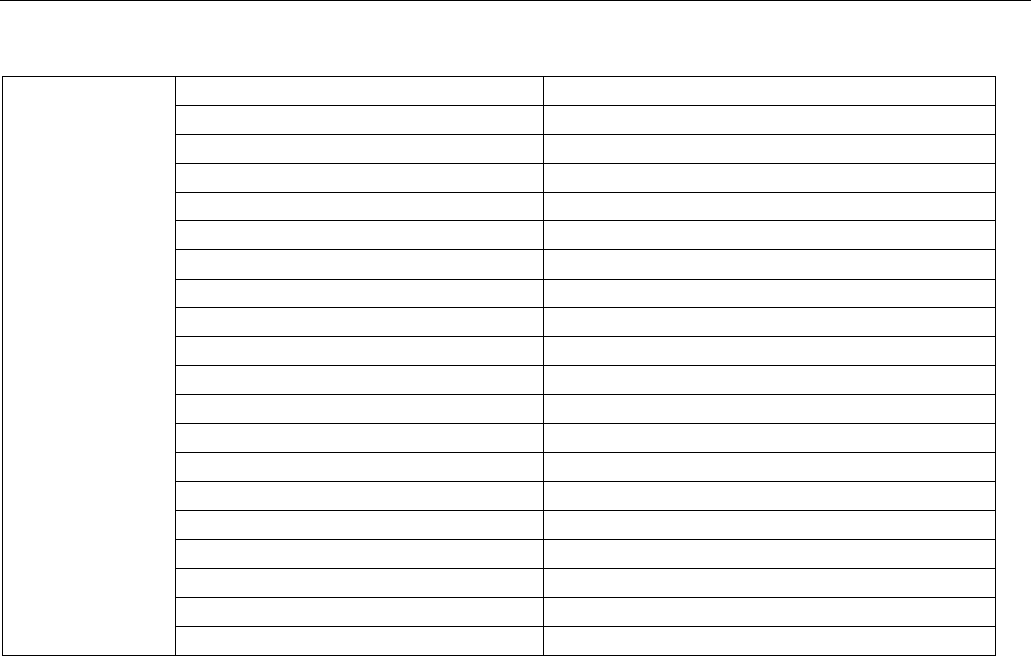
Technical data
11.4 Mechanical
SITRANS LR250 (mA/HART)
204 Operating Instructions, 08/2014, A5E32220602-AC
80 A JIS 10K FEA
approximately 9 kg (19.8 lb)
100 A JIS 10K FEA
approximately 10.1 kg (22.3 lb)
150 A JIS 10K
approximately 16.3 kg (35.9 lb)
2" ISO2852 HEA
approximately 4.7 kg (10.4 lb)
3" ISO2852 HEA
approximately 6.3 kg (13.9 lb)
4" ISO2852 HEA
approximately 6.8 kg (15 lb)
DN50 DIN 11864-1 HEA
approximately 4.8 kg (10.6 lb)
DN80 DIN 11864-1 HEA
approximately 6.7 kg (14.8 lb)
DN100 DIN 11864-1 HEA
approximately 7.1 kg (15.7 lb)
DN50 DIN 11864-2 HEA
approximately 5.0 kg (11 lb)
DN80 DIN 11864-2 HEA
approximately 7.2 kg (15.9 lb)
DN100 DIN 11864-2 HEA approximately 7.9 kg (17.4 lb)
DN50 DIN 11864-3 HEA
approximately 4.8 kg (10.6 lb)
DN80 DIN 11864-3 HEA
approximately 6.6 kg (14.6 lb)
DN100 DIN 11864-3 HEA
approximately 7.2 kg (15.9 lb)
DN50 DIN 11851 HEA
approximately 4.8 kg (10.6 lb)
DN80 DIN 11851 HEA
approximately 6.8 kg (15 lb)
DN100 DIN 11851 HEA
approximately 7.2 kg (15.9 lb)
Tuchenhagen Type F HEA
approximately 4.8 kg (10.6 lb)
Tuchenhagen Type N HEA
approximately 4.9 kg (10.8 lb)
a) For use with 1.5" (40 mm) horn antennas only.

Technical data
11.5 Environmental
SITRANS LR250 (mA/HART)
Operating Instructions, 08/2014, A5E32220602-AC 205
11.5
Environmental
Note
•
For the specific configuration you are about to use or install, check transmitter nameplate
and see Approvals (Page 206).
•
Use appropriate conduit seals to maintain IP or NEMA rating.
Location
indoor/ outdoor
Altitude
5000 m (16,404 ft) max.
Ambient temperature
−40 to +80 °C (−40 to +176 °F)
Relative humidity suitable for outdoor
Type 4X/NEMA 4X, Type 6/NEMA 6, IP67, IP68 enclosure (see note
above)
Installation category I
Pollution degree
4
11.6
Process
Note
The maximum temperature is dependent on the process
connection, antenna materials, and
vessel pressure. For more detailed information see
Maximum Process Temperature Chart
(Page
265) and Process Pressure/Temperature derating curves (Page 267).
Temperature at process
connection Standard Horn
antenna (Threaded
or Flanged):
with FKM O-
ring
−40 to +200 °C (−40 to +392 °F)
with FFKM O-
ring
−20 to +200 °C (−4 to +392 °F)
2" NPT / BSPT / G Threaded PVDF
antenna:
−40 to +80 °C (−40 to +176 °F)
Flanged encapsulated antenna (FEA)
-40 to +170 °C (−40 to +338 °F)
Hygienic encapsulated antenna (HEA)
-40 to +170 °C (−40 to +338 °F)
with FKM seals used on process connection:
-20 to +170 °C (-4 to +338 °F)
with EPDM seals used on process connection: -
40 to +120 °C (-40 to +248 °F)
Pressure (vessel) Refer to process connection tag and Process
Pressure/Temperature derating curves
(Page 270).

Technical data
11.7 Approvals
SITRANS LR250 (mA/HART)
206 Operating Instructions, 08/2014, A5E32220602-AC
11.7
Approvals
Note
Th
e device nameplate lists the approvals that apply to your device.
Application type
LR250 version
Approval rating
Valid for:
Non-hazardous
General purpose CSAUS/C, FM, CE, RCM N. America,
Europe
Radio
Europe (R&TTE), FCC, Industry Canada
Hazardous
Intrinsically safe
(Page 45) ATEX II 1G, Ex ia IIC T4 Ga
ATEX II 1D, Ex ia ta IIIC T100 °C Da
Europe
IECEx SIR 05.0031X, Ex ia IIC T4 Ga
Ex ia ta IIIC T100 °C Da International
FM/CSA
Class I, Div. 1, Groups A, B, C, D
Class II, Div. 1, Groups E, F, G
Class III T4
US/Canada
INMETRO: DNV 12.0087 X
Ex ia IIC T4 Ga
Ex ia ta IIIC T100 °C Da IP65/IP67
-40 °C ≤ Ta ≤ +80 °C
DNV #OCP 0017
ABNT NBR IEC 60079-0:2008,
ABNT NBR IEC 60079-11:2009,
ABNT NBR IEC 60079-26:2008,
ABNT NBR IEC 60079-31:2011
Brazil
NEPSI Ex ia IIC T4 Ga
Ex iaD 20 T90 IP67 DIP A20 TA 90 ºC
China
Non-Sparking
(Page 47)
ATEX II 3 G, Ex nA IIC T4 Gc
Europe
NEPSI
Ex nA IIC T4 Gc
China
Non-incendive
(Page 47)
FM/CSA
Class I, Div. 2, Groups A, B, C, D T5
US/Canada
Flameproof (Page 48)
ATEX II 1/2 GD, 1D, 2D
IECEx SIR 08.0107X
Ex d mb ia IIC T4 Ga/Gb
Ex ia ta IIIC T100 °C Da
Europe and
International

Technical data
11.7 Approvals
SITRANS LR250 (mA/HART)
Operating Instructions, 08/2014, A5E32220602-AC 207
Application type
LR250 version
Approval rating
Valid for:
INMETRO: DNV 12.0088 X
Ex d ia mb IIC T4 Ga/Gb
Ex ia ta IIIC T100 °C Da IP67
-40 °C ≤ Ta ≤ +80 °C
Um = 250 V
DNV #OCP 0017
ABNT NBR IEC 60079-0:2008,
ABNT NBR IEC 60079-1:2009,
ABNT NBR IEC 60079-11:2009,
ABNT NBR IEC 60079-18:2010,
ABNT NBR IEC 60079-26:2008,
ABNT NBR IEC 60079-31:2011
Brazil
Increased safety
(Page 49)
ATEX II 1/2 GD, 1D, 2D
IECEx SIR 08.0107X
Ex e mb ia IIC T4 Ga/Gb
Ex ia ta IIIC T100 °C Da
Europe and
International
INMETRO: DNV 12.0088 X
Ex e ia mb IIC T4 Ga/Gb
Ex ia ta IIIC T100 °C Da IP67
-40 °C ≤ Ta ≤ +80 °C
Um = 250 V
DNV #OCP 0017
ABNT NBR IEC 60079-0:2008,
ABNT NBR IEC 60079-7:2008,
ABNT NBR IEC 60079-11:2009,
ABNT NBR IEC 60079-18:2010,
ABNT NBR IEC 60079-26:2008,
ABNT NBR IEC 60079-31:2011
Brazil
Flameproof (Page 48)/
Increased safety
(Page 49)
NEPSI Ex d ia mb IIC T4 Ga/Gb /
Ex e ia mb IIC T4 Ga/Gb
Ex iaD 20 T90 IP67 DIP A20 T
A
90 ºC
China
Explosion proof
(Page 49) FM/CSA
Class I, Div. 1, Groups A, B, C, D
Class II, Div. 1, Groups E, F, G
Class III T4
US/Canada
Marine Lloyd's Register of Shipping
ABS Type Approval
BV Type Approval

Technical data
11.8 Programmer (infrared keypad)
SITRANS LR250 (mA/HART)
208 Operating Instructions, 08/2014, A5E32220602-AC
11.8
Programmer (infrared keypad)
Note
Battery is non
-replaceable with a lifetime expectancy of 10 years in normal use.
To estim
ate the lifetime expectancy, check the nameplate on the back for the serial number.
The first six numbers show the production date (mmddyy), for example, serial number
032608101V was produced on March 26, 2008.
Siemens Milltronics Infrared IS (Intrinsically Safe) Handheld Programmer for hazardous and all
other locations (battery is non-replaceable).
Approvals
CE
FM/CSA Class I, II, III, Div. 1, Gr. A to G T6
ATEX II 1GD Ex ia IIC T4 Ga
Ex iaD 20 T135 °C
IECEx Ex ia IIC T4 Ga
Ex iaD 20 T135 °C
INMETRO
Ex ia IIC T4 Ga
Ex ia IIIC T135 °C Da
Ambient temperature
−20 to +50 °C (−5 to +122 °F)
Interface
proprietary infrared pulse signal
Power
3 V non-replaceable lithium battery
Weight
150 g (0.3 lb)
Color
black
Part number
7ML1930-1BK

SITRANS LR250 (mA/HART)
Operating Instructions, 08/2014, A5E32220602-AC 209
Dimension drawings
12
12.1
Threaded horn antenna
Note
•
Process temperature and pressure capabilities are dependent upon information on the
process connection tag. Reference drawing listed on the tag is available for download
from our website under
Support/Installation drawings/Level Measurement/Continuous -
Radar/LR250
:
Product page (http://www.siemens.com/LR250)
•
Process connection drawings are also available for download from the
Installation
Drawings page
.
•
Signal amplitude increases with horn diameter, so use the largest practical size.
•
Optional extensions can be installed below the threads.
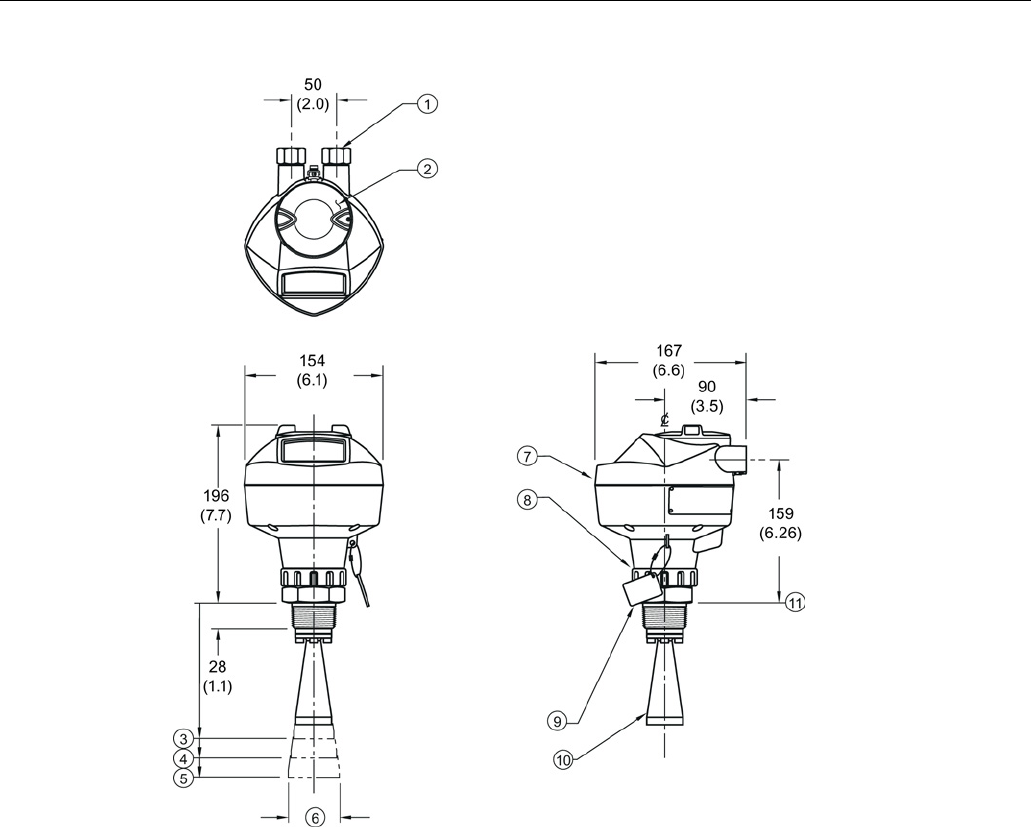
Dimension drawings
12.1 Threaded horn antenna
SITRANS LR250 (mA/HART)
210 Operating Instructions, 08/2014, A5E32220602-AC
①
½" NPT cable entry, or M20 cable gland
⑦
enclosure/electronics
②
threaded cover
⑧
retaining collar
③
2" horn
⑨
process connection tag
④
3" horn
⑩
horn
⑤
4" horn
⑪
sensor reference point
⑥
horn O.D.
Dimensions in mm (inch)

Dimension drawings
12.1 Threaded horn antenna
SITRANS LR250 (mA/HART)
Operating Instructions, 08/2014, A5E32220602-AC 211
Threaded horn dimensions
Antenna
Type
Antenna
O.D.
in mm
(inch)
Height to sensor reference point, in mm (inch) a)
Beam Angle
(°)b)
Measurement
range, in m (ft)
1-1/2" threaded
connection
2" threaded
connection
3" threaded
connection
1.5"
39.8 (1.57)
135 (5.3)
N/A
N/A
19
10 (32.8)
2"
47.8 (1.88)
N/A
166 (6.55)
180 (7.09)
15
20 (65.6)
3"
74.8 (2.94)
N/A
199 (7.85)
213 (8.39)
10
20 (65.6)
4"
94.8 (3.73)
N/A
254 (10)
268 (10.55)
8
20 (65.6)
a) Height from bottom of horn to sensor reference point as shown: see dimension drawing.
b) -3dB in the direction of the polarization axis. For an illustration, see Polarization reference point
(Page 31).
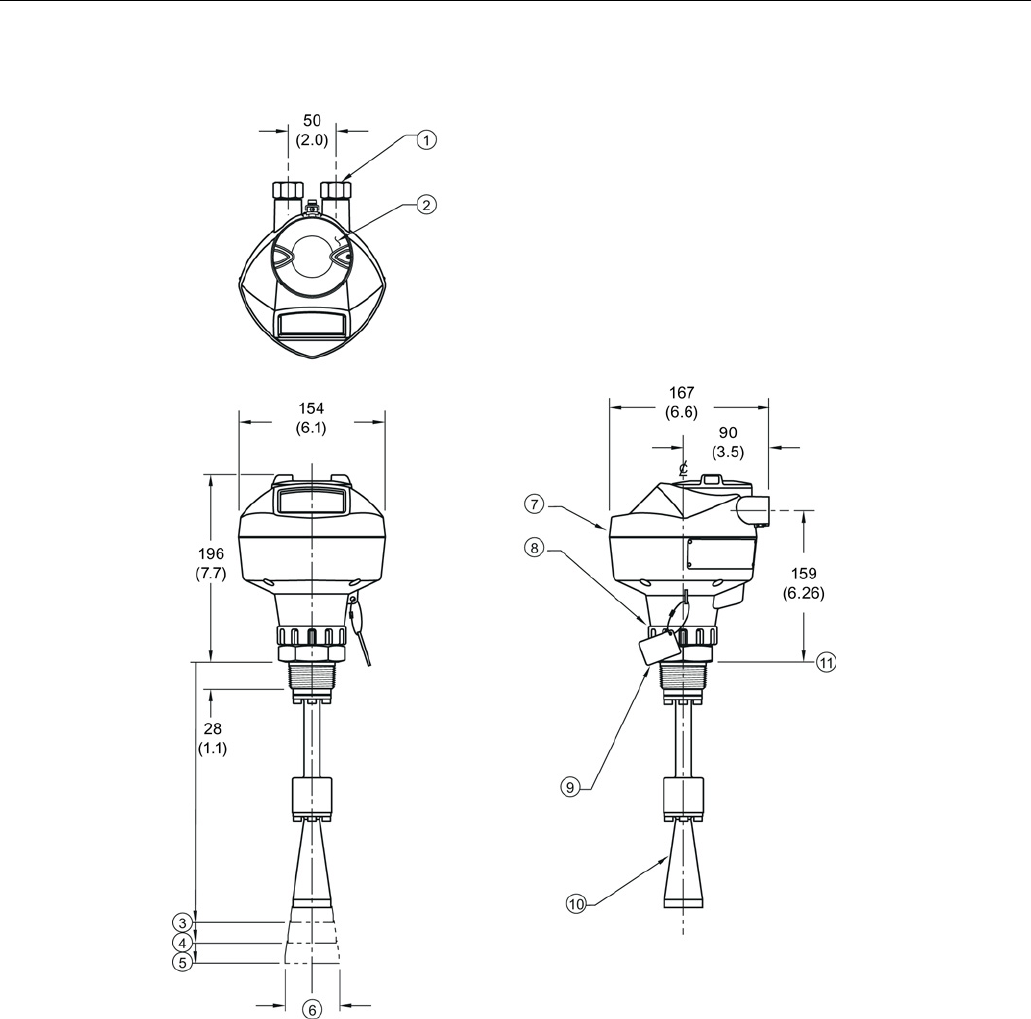
Dimension drawings
12.2 Threaded horn antenna with extension
SITRANS LR250 (mA/HART)
212 Operating Instructions, 08/2014, A5E32220602-AC
12.2
Threaded horn antenna with extension
①
½" NPT cable entry, or M20 cable gland
⑦
enclosure/electronics
②
threaded cover
⑧
retaining collar
③
2" horn
⑨
process connection tag
④
3" horn
⑩
horn
⑤
4" horn
⑪
sensor reference point
⑥
horn O.D.
Dimensions in mm (inch)

Dimension drawings
12.2 Threaded horn antenna with extension
SITRANS LR250 (mA/HART)
Operating Instructions, 08/2014, A5E32220602-AC 213
Threaded horn with extension dimensions
Antenna
Type
Antenna
O.D.
in mm
(inch)
Height to sensor reference point, in mm (inch) a)
Beam Angle
(°) b)
Measurement
range
in m (ft)
1-1/2" threaded
connection
2" threaded
connection
3" threaded
connection
1.5"
39.8 (1.57)
235 (9.25)
N/A
N/A
19
10 (32.8)
2"
47.8 (1.88)
N/A
266 (10.47)
280 (11.02)
15
20 (65.6)
3"
74.8 (2.94)
N/A
299 (11.77)
313 (12.32)
10
20 (65.6)
4"
94.8 (3.73)
N/A
354 (13.94)
368 (14.49)
8
20 (65.6)
a) Height from bottom of horn to sensor reference point as shown: see dimension drawing.
b) -3dB in the direction of the polarization axis. For an illustration, see Polarization reference point
(Page 31).
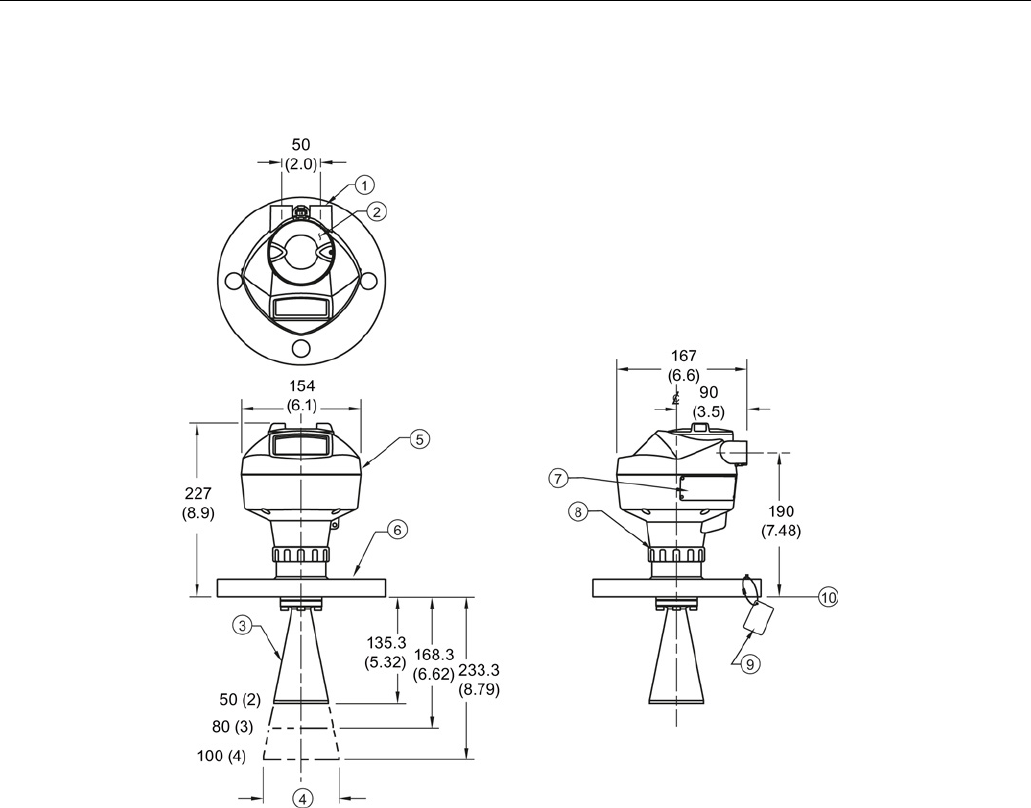
Dimension drawings
12.3 Flanged horn antenna
SITRANS LR250 (mA/HART)
214 Operating Instructions, 08/2014, A5E32220602-AC
12.3
Flanged horn antenna
①
½" NPT cable entry, or M20 cable gland
⑥
flange
②
threaded cover
⑦
name-plate
③
horn
⑧
retaining collar
④
horn O.D.
⑨
process connection tag
⑤
enclosure/electronics
⑩
sensor reference point
Dimensions in mm (inch)

Dimension drawings
12.3 Flanged horn antenna
SITRANS LR250 (mA/HART)
Operating Instructions, 08/2014, A5E32220602-AC 215
Flanged Horn dimensions
Nominal horn
size
in mm (inch)
Horn O.D.
in mm (inch)
Height to sensor reference point, in mm
(inch)a)
Beam angle
(°)b)
Measurement range,
in m (ft)
Stainless steel flange:
raised or flat-face
Optional alloy
flange c)
50 (2)
47.8 (1.88)
135.3 (5.32)
138.3 (5.44)
15
20 (65.6)
80 (3)
74.8 (2.94)
168.3 (6.62)
171.3 (6. 74)
10
100 (4)
94.8 (3.73)
223.3 (8.79)
226.3 (8.90)
8
a)Height from bottom of horn to sensor reference point as shown: see Flanged horn antenna with
extension (Page 216). See also Raised-Face flange per EN 1092-1 for flanged horn antenna
(Page 241), or Flat-Face flange (Page 246).
b) -3dB in the direction of the polarization axis (see Polarization reference point (Page 31) for an
illustration).
c) Optional alloy N06022/2.4602 (Hastelloy® C-22 or equivalent). See Raised-Face Flange
Dimensions (Page 241).
Note
Heights to sensor reference point are for stainless steel flanges. For optional alloy
N06022/2.4602 (Hastelloy
© C-22 or equivalent) see Flanged Horn dimensions above.
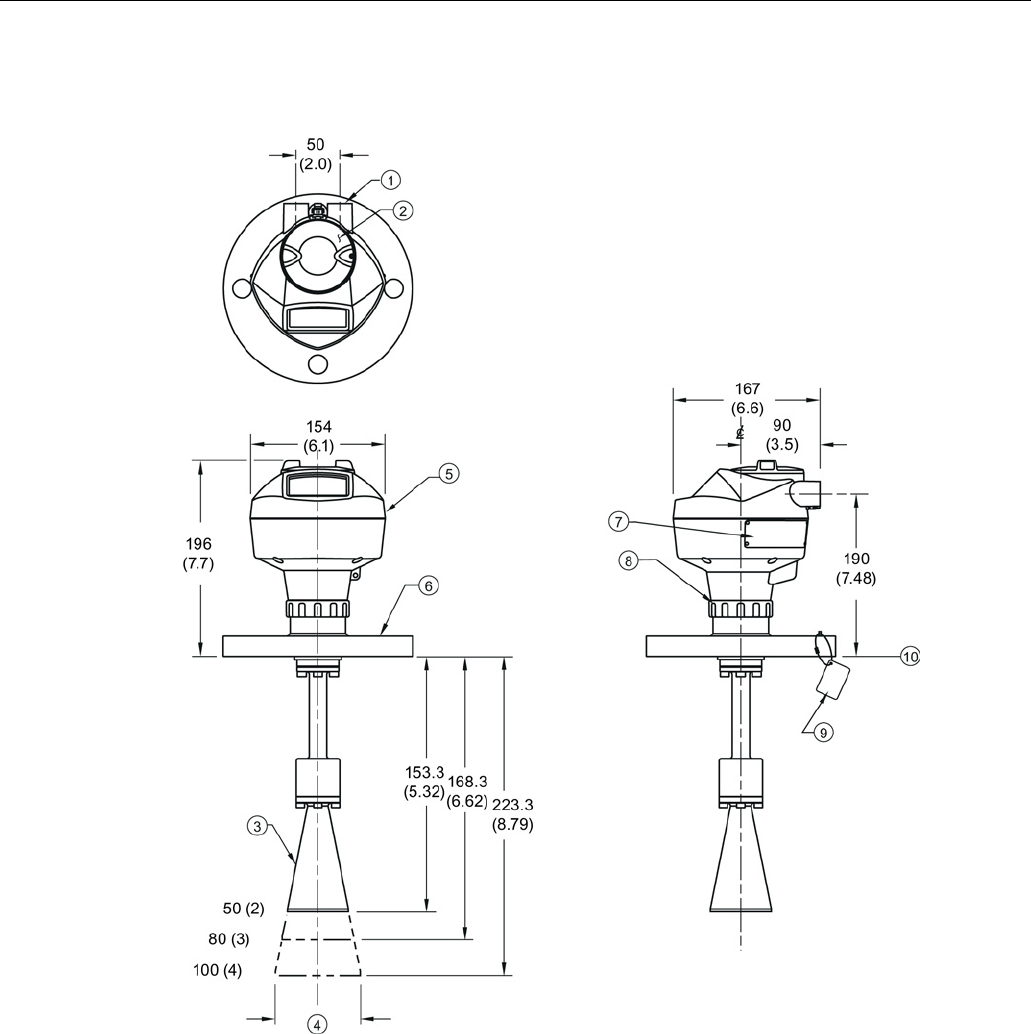
Dimension drawings
12.4 Flanged horn antenna with extension
SITRANS LR250 (mA/HART)
216 Operating Instructions, 08/2014, A5E32220602-AC
12.4
Flanged horn antenna with extension
①
½" NPT cable entry, or M20 cable gland
⑥
flange
②
threaded cover
⑦
name-plate
③
horn
⑧
retaining collar
④
horn O.D.
⑨
process connection tag
⑤
enclosure/electronics
⑩
sensor reference point
Dimensions in mm (inch)

Dimension drawings
12.4 Flanged horn antenna with extension
SITRANS LR250 (mA/HART)
Operating Instructions, 08/2014, A5E32220602-AC 217
Flanged horn with extension dimensions
Nominal horn
size
in mm (inch)
Horn O.D. in mm
(inch)
Height to sensor reference point,, in mm
(inch) a)
Beam angle
(°)b)
Measurement range,
in m (ft)
Stainless steel flange:
raised or flat-face
Optional alloy
flange c)
50 (2)
47.8 (1.88)
235.3 (9.26)
238.3 (9.38)
15
20 (65.6)
80 (3)
74.8 (2.94)
268.3 (10.56)
271.3 (10.68)
10
100 (4)
94.8 (3.73)
323.3 (12.73)
326.3 (12.85)
8
a)Height from bottom of horn to sensor reference point as shown: See also Raised-Face flange
per EN 1092-1 for flanged horn antenna (Page 241) or Flat-Face Flange. (Page 246)
b) -3dB in the direction of the polarization axis (see Polarization reference point (Page 31) for an
illustration).
c) Optional alloy N06022/2.4602 (Hastelloy® C-22 or equivalent). See Raised-Face flange per EN
1092-1 for flanged horn antenna (Page 241).
Note
Heights to sensor reference point are for st
ainless steel flanges. For optional alloy
N06022/2.4602 (Hastelloy
© C-22 or equivalent) see Flanged Horn dimensions above.
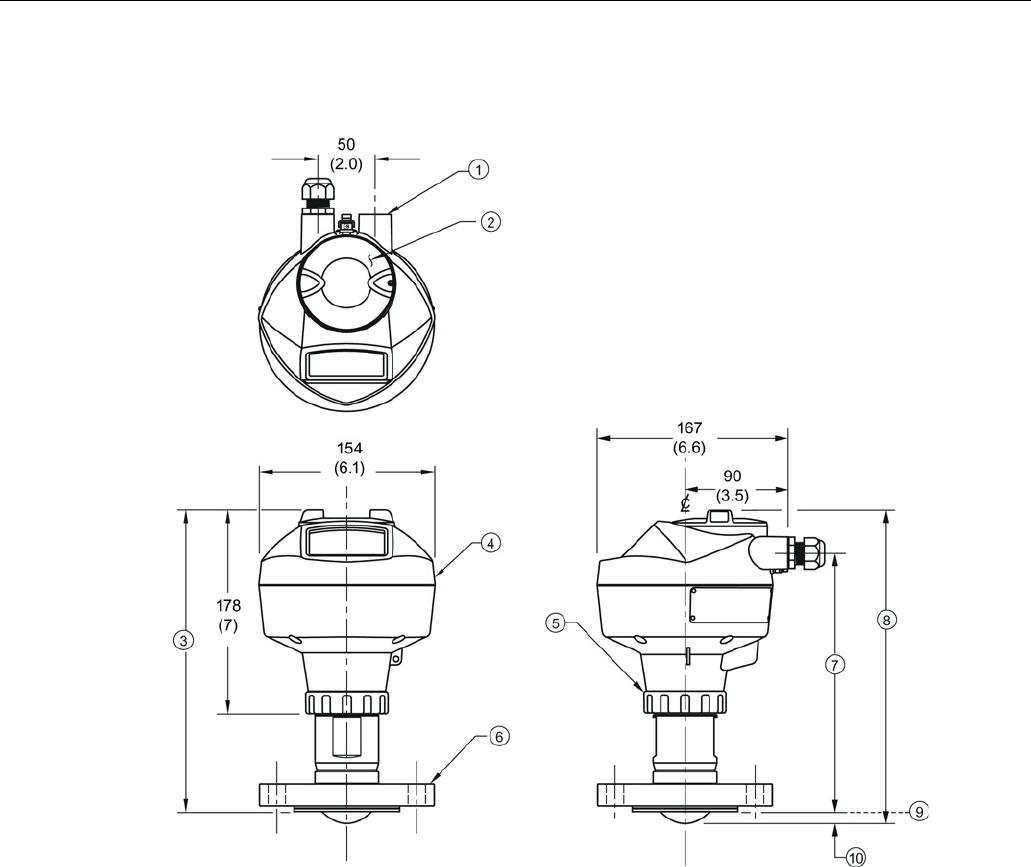
Dimension drawings
12.5 Flanged encapsulated antenna (2"/DN50/50A sizes only)
SITRANS LR250 (mA/HART)
218 Operating Instructions, 08/2014, A5E32220602-AC
12.5
Flanged encapsulated antenna (2"/DN50/50A sizes only)
①
½" NPT cable entry, or M20 cable gland
⑥
flange
②
threaded cover
⑦
see table below
③
see table below
⑧
see table below
④
enclosure
⑨
sensor reference point
⑤
retaining collar
⑩
see table below
Dimensions in mm (inch)

Dimension drawings
12.5 Flanged encapsulated antenna (2"/DN50/50A sizes only)
SITRANS LR250 (mA/HART)
Operating Instructions, 08/2014, A5E32220602-AC 219
Flanged encapsulated antenna (2"/DN50/50A) dimensions
Flange size
③ mm (inch)
⑦ mm (inch)
⑧ mm (inch)
⑩ mm (inch)1)
2"/DN50/50A
263 (10.35)
223 (8.78)
274 (10.79)
11 (0.43)
1) Height from tip of lens to sensor reference point as shown.
Flange size
Flange class
Flange O.D.
[mm (inch)]
Antenna
aperture size
[mm (inch)]
Beam angle
(°)1)
Measurement
range
[m (ft)]
2"
150 LB
152 (5.98)
50 (1.97) 12.8 10 (32.8)2)
DN50
PN10/16
165 (6.50)
50A
10K
155 (6.10)
1)
-3 dB in the direction of the polarization axis.
2) 20m if installed in stillpipe
See Raised-Face Flange per EN 1092-1, (Page 243)and Polarization reference point (Page 31).
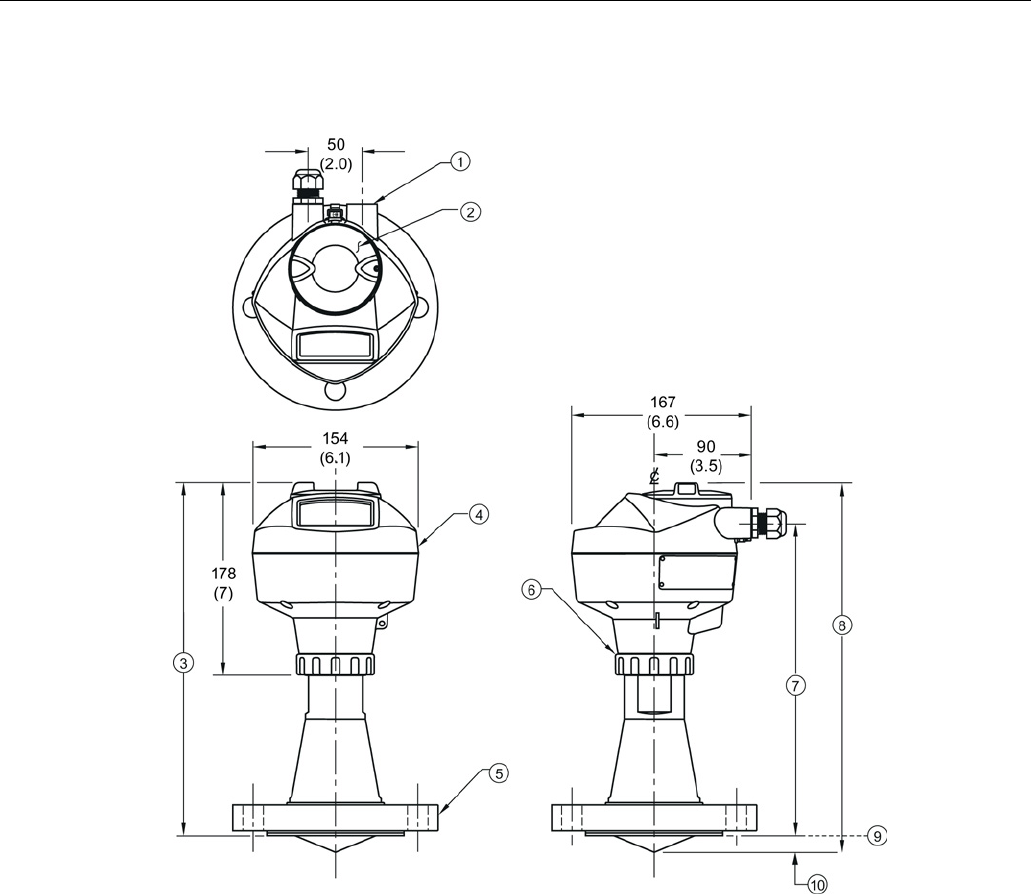
Dimension drawings
12.6 Flanged encapsulated antenna (3"/DN80/80A sizes and larger)
SITRANS LR250 (mA/HART)
220 Operating Instructions, 08/2014, A5E32220602-AC
12.6
Flanged encapsulated antenna (3"/DN80/80A sizes and larger)
①
½" NPT cable entry, or M20 cable gland
⑥
retaining collar
②
threaded cover
⑦
see table below
③
see table below
⑧
see table below
④
enclosure
⑨
sensor reference point
⑤
flange
⑩
see table below
Dimensions in mm (inch)
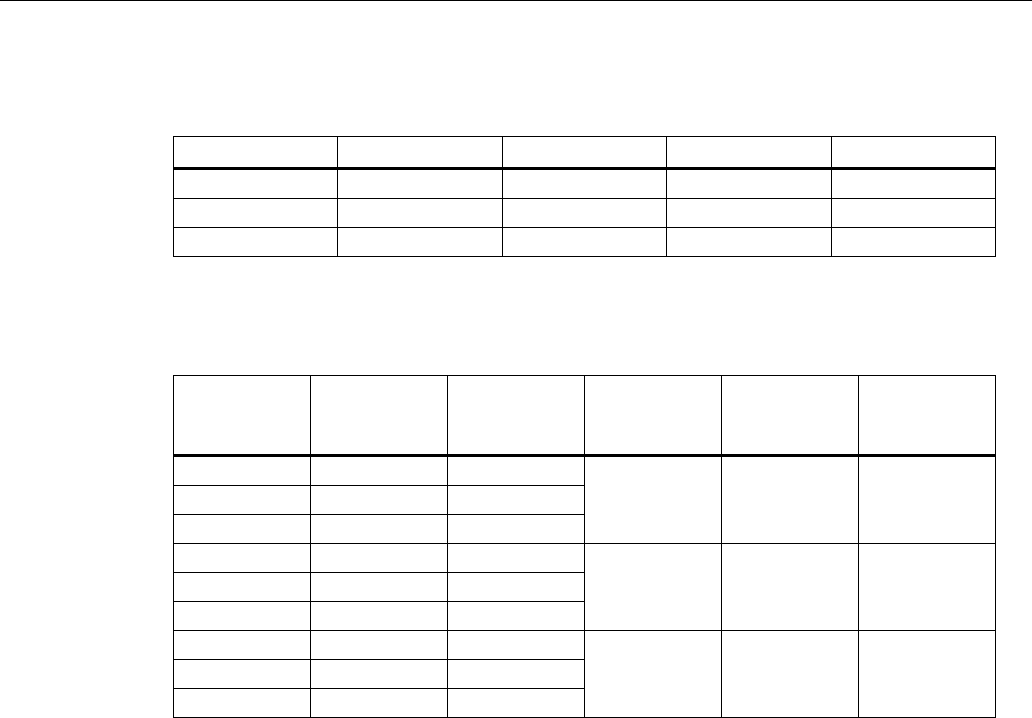
Dimension drawings
12.6 Flanged encapsulated antenna (3"/DN80/80A sizes and larger)
SITRANS LR250 (mA/HART)
Operating Instructions, 08/2014, A5E32220602-AC 221
Flanged encapsulated antenna (3"/DN80/80A and larger) dimensions
Flange size
③ mm (inch)
⑦ mm (inch)
⑧ mm (inch)
⑩ mm (inch)1)
3"/DN80/80A
328 (12.91)
288 (11.34)
343 (13.50)
15 (0.59)
4"/DN100/100A
328 (12.91)
288 (11.34)
343 (13.50)
13 (0.51)
6"/DN150/150A
333 (13.11)
293 (11.54)
348 (13.70)
15 (0.59)
1)
Height from tip of lens to sensor reference point as shown. See also Raised-Face Flange per EN
1092-1.
Flange size
Flange class
Flange O.D.
[mm (inch)]
Antenna
aperture size
[mm (inch)]
Beam angle
(°)1)
Measurement
range
[m (ft)]
3"
150 LB
190 (7.48)
75 (2.95) 9.6 20 (65.6)
DN80
PN10/16
200 (7.87)
80A
10K
185 (7.28)
4"
150 LB
230 (9.06)
75 (2.95) 9.6 20 (65.6)
DN100
PN10/16
220 (8.66)
100A
10K
210 (8.27)
6"
150 LB
280 (11.02)
75 (2.95) 9.6 20 (65.6)
DN150
PN10/16
285 (11.22)
150A
10K
280 (11.02)
1) -3 dB in the direction of the polarization axis.
See Raised-Face Flange per EN 1092-1 (Page 243), and Polarization reference point (Page 31).
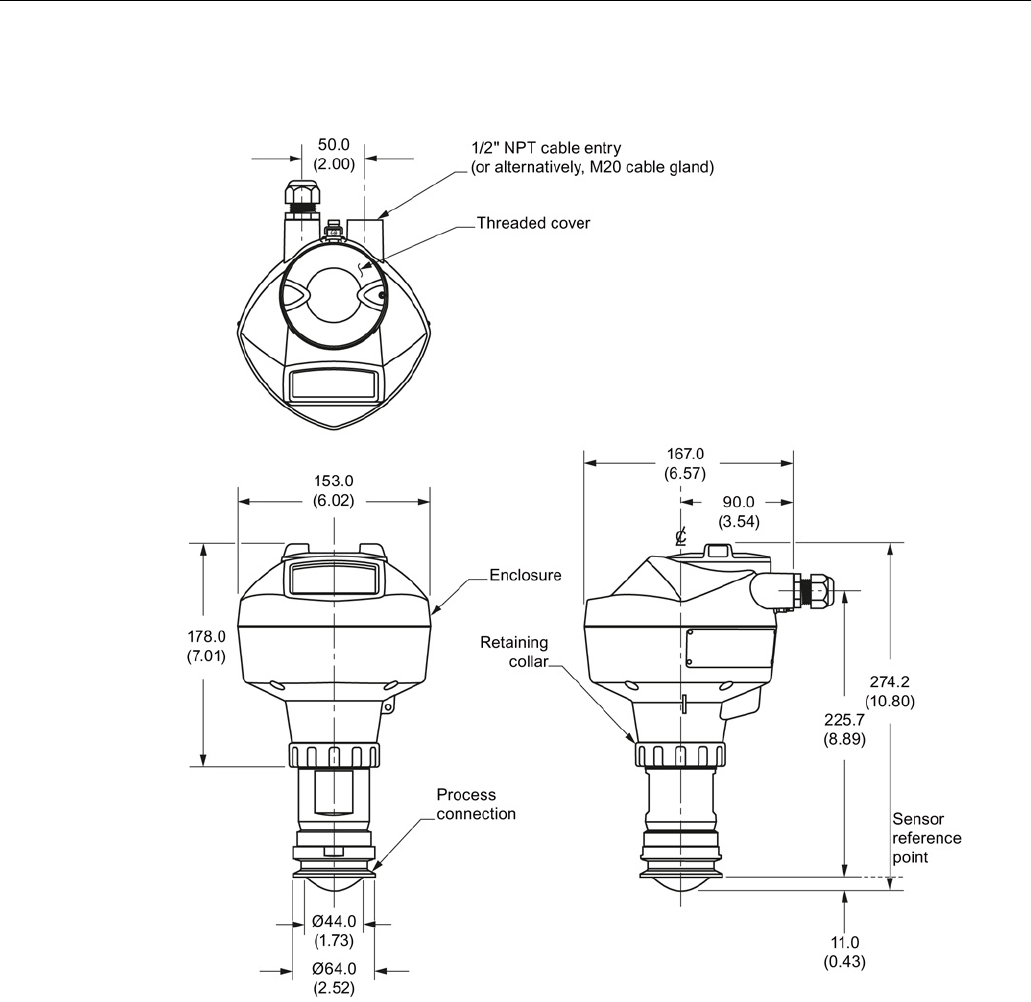
Dimension drawings
12.7 Hygienic encapsulated antenna (2" ISO 2852 sanitary clamp)
SITRANS LR250 (mA/HART)
222 Operating Instructions, 08/2014, A5E32220602-AC
12.7
Hygienic encapsulated antenna (2" ISO 2852 sanitary clamp)
Dimensions in mm (inch)
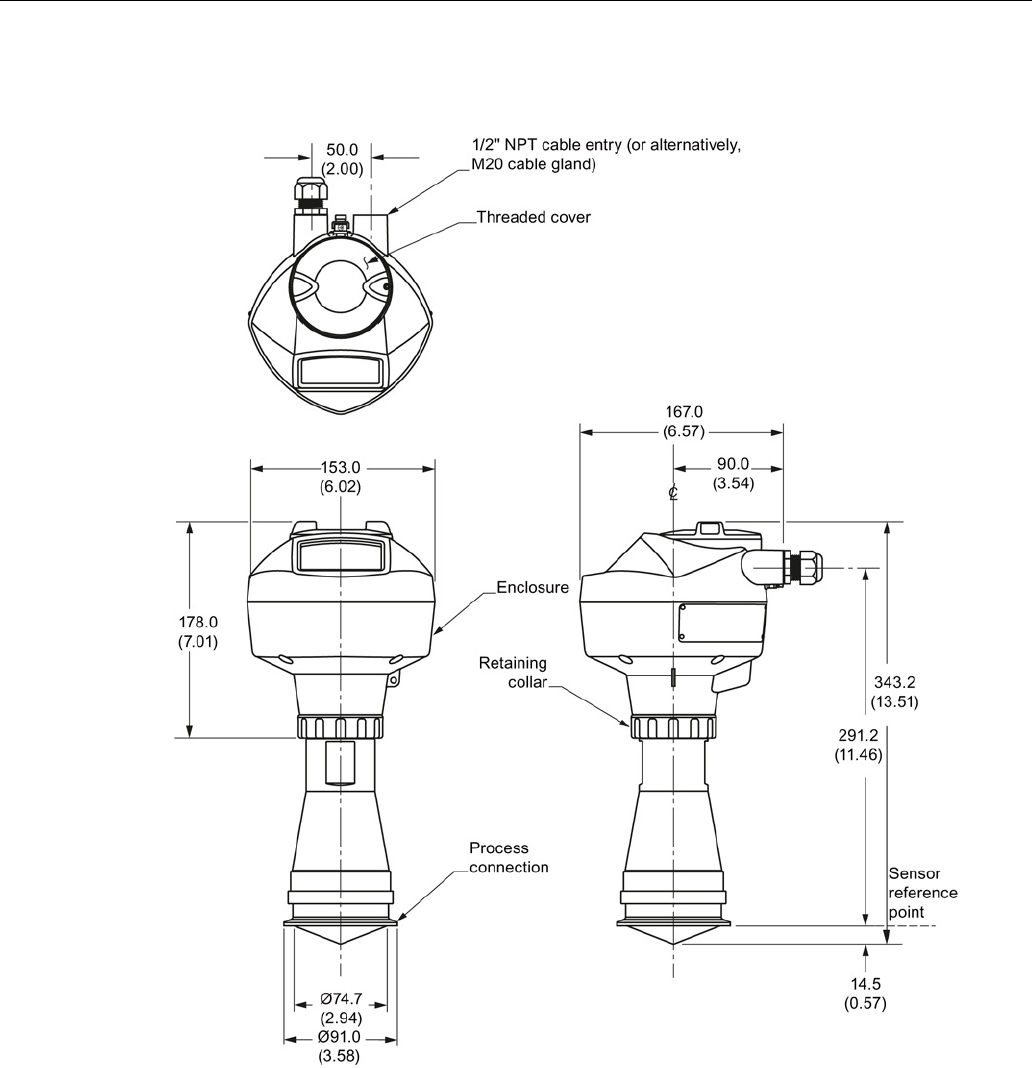
Dimension drawings
12.8 Hygienic encapsulated antenna (3" ISO 2852 sanitary clamp)
SITRANS LR250 (mA/HART)
Operating Instructions, 08/2014, A5E32220602-AC 223
12.8
Hygienic encapsulated antenna (3" ISO 2852 sanitary clamp)
Dimensions in mm (inch)
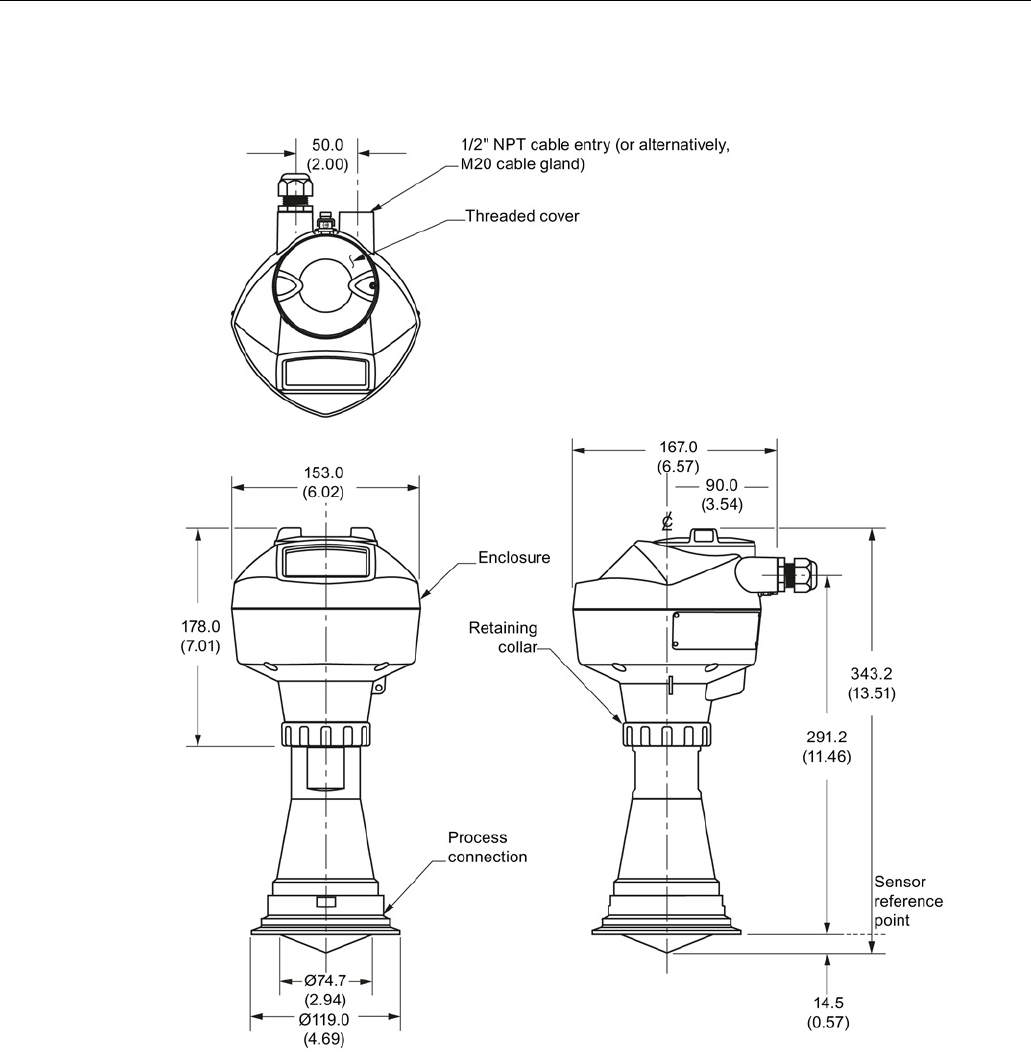
Dimension drawings
12.9 Hygienic encapsulated antenna (4" ISO 2852 sanitary clamp)
SITRANS LR250 (mA/HART)
224 Operating Instructions, 08/2014, A5E32220602-AC
12.9
Hygienic encapsulated antenna (4" ISO 2852 sanitary clamp)
Dimensions in mm (inch)
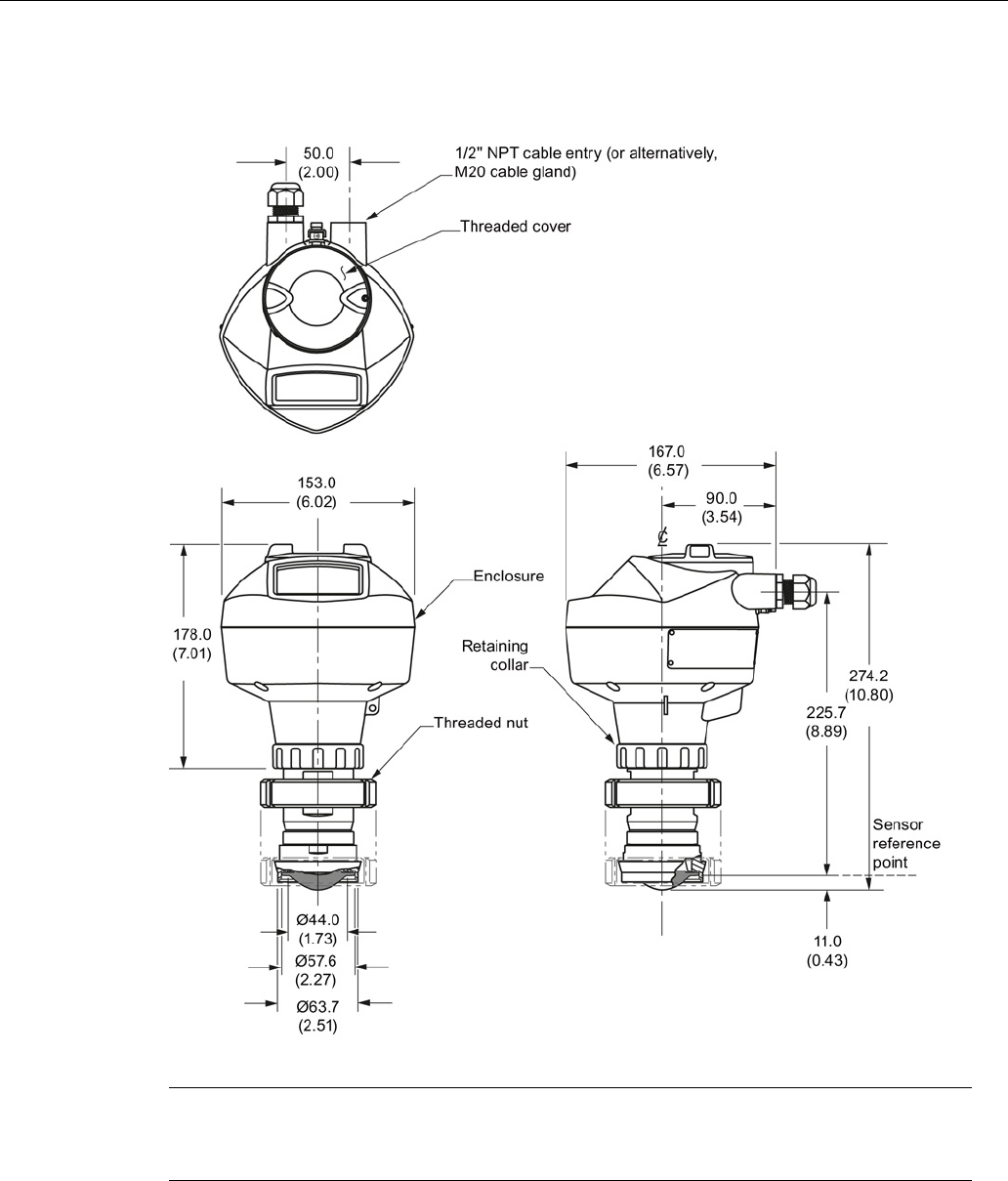
Dimension drawings
12.10 Hygienic encapsulated antenna (DN 50 nozzle/slotted nut to DIN 11851)
SITRANS LR250 (mA/HART)
Operating Instructions, 08/2014, A5E32220602-AC 225
12.10
Hygienic encapsulated antenna (DN 50 nozzle/slotted nut to DIN
11851)
Dimensions in mm (inch)
Note
Cut out of process connection and placement of threaded nut are shown for illustration
purposes only.
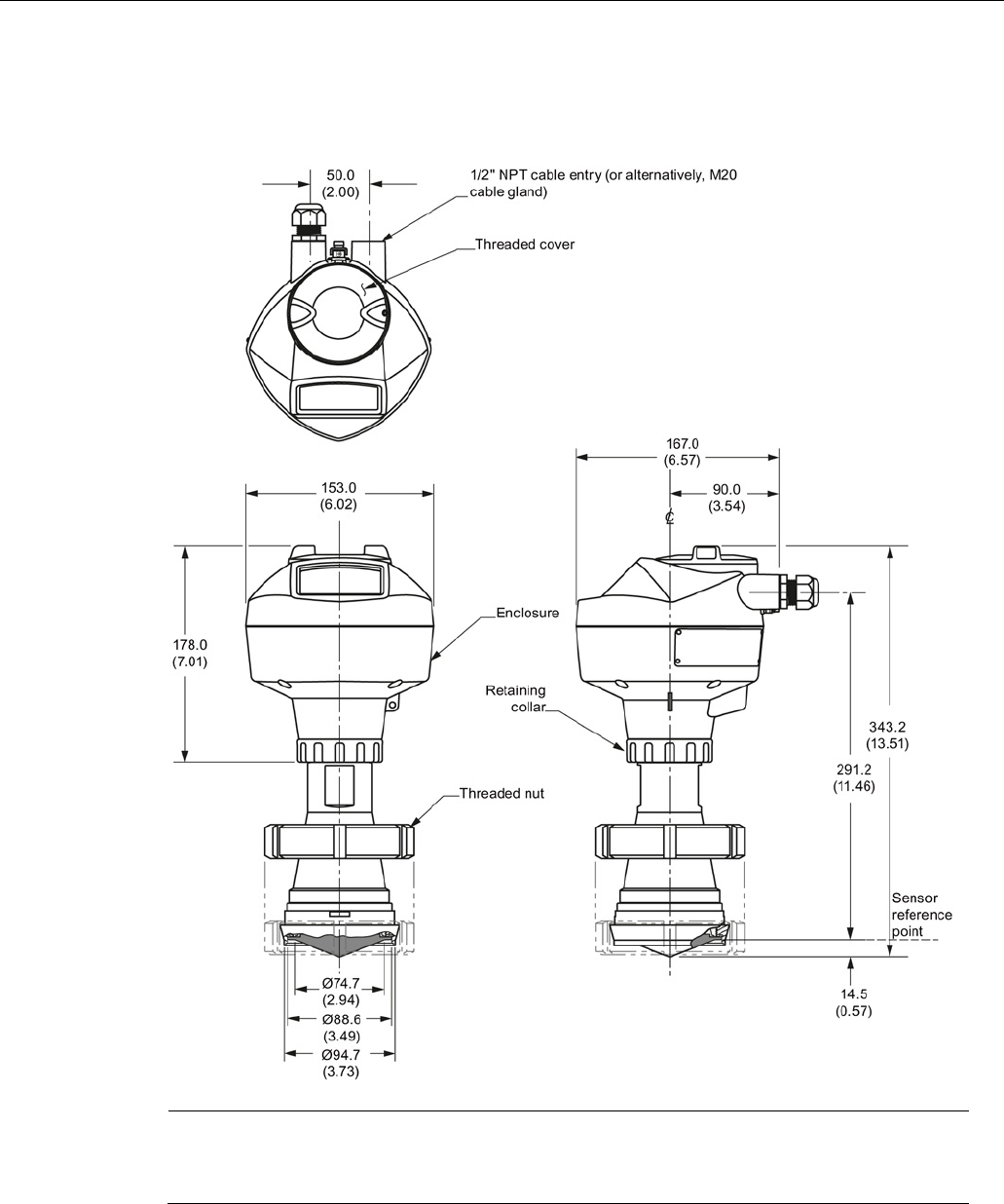
Dimension drawings
12.11 Hygienic encapsulated antenna (DN 80 nozzle/slotted nut to DIN 11851)
SITRANS LR250 (mA/HART)
226 Operating Instructions, 08/2014, A5E32220602-AC
12.11
Hygienic encapsulated antenna (DN 80 nozzle/slotted nut to DIN
11851)
Dimensions in mm (inch)
Note
Cut out of process connection and placement of threaded nut are shown for illustration
purposes only.
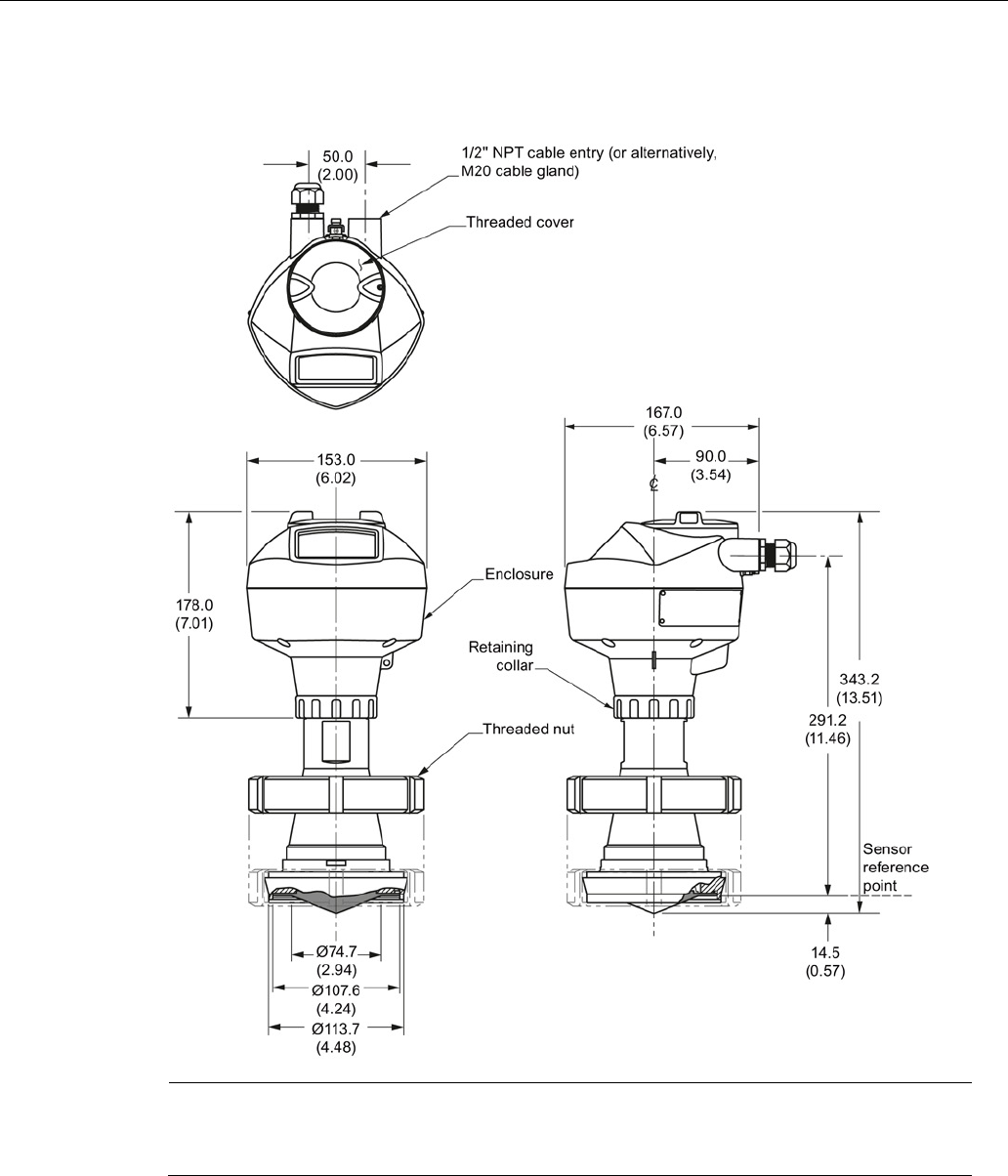
Dimension drawings
12.12 Hygienic encapsulated antenna (DN 100 nozzle/slotted nut to DIN 11851)
SITRANS LR250 (mA/HART)
Operating Instructions, 08/2014, A5E32220602-AC 227
12.12
Hygienic encapsulated antenna (DN 100 nozzle/slotted nut to DIN
11851)
Dimensions in mm (inch)
Note
Cut out of process connect
ion and placement of threaded nut are shown for illustration
purposes only.
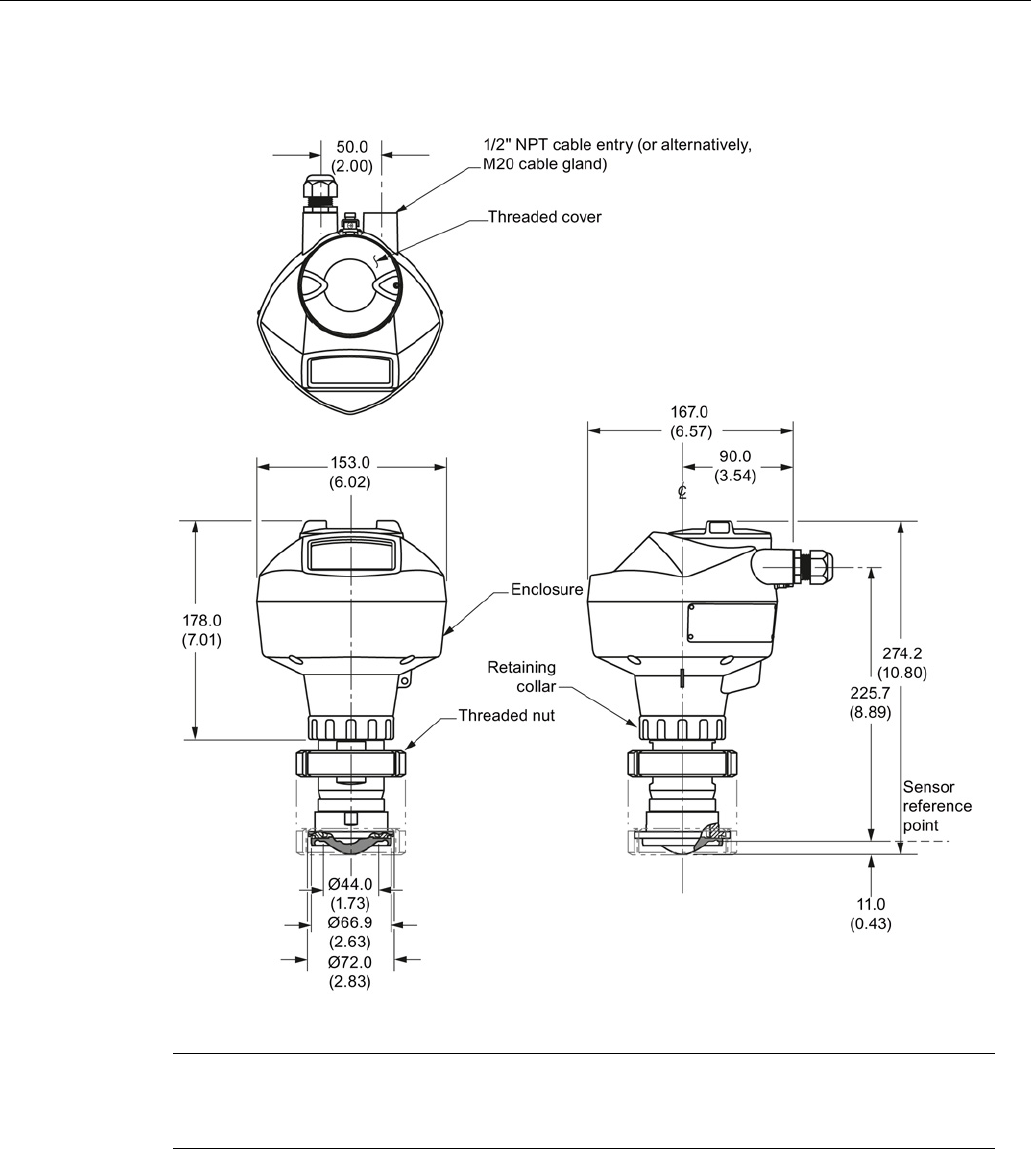
Dimension drawings
12.13 Hygienic encapsulated antenna (DN 50 aseptic clamp to DIN 11864-1)
SITRANS LR250 (mA/HART)
228 Operating Instructions, 08/2014, A5E32220602-AC
12.13
Hygienic encapsulated antenna (DN 50 aseptic clamp to DIN 11864-1)
Dimensions in mm (inch)
Note
Cut out of process connection and placement of threaded nut are shown for illustration
purposes only.
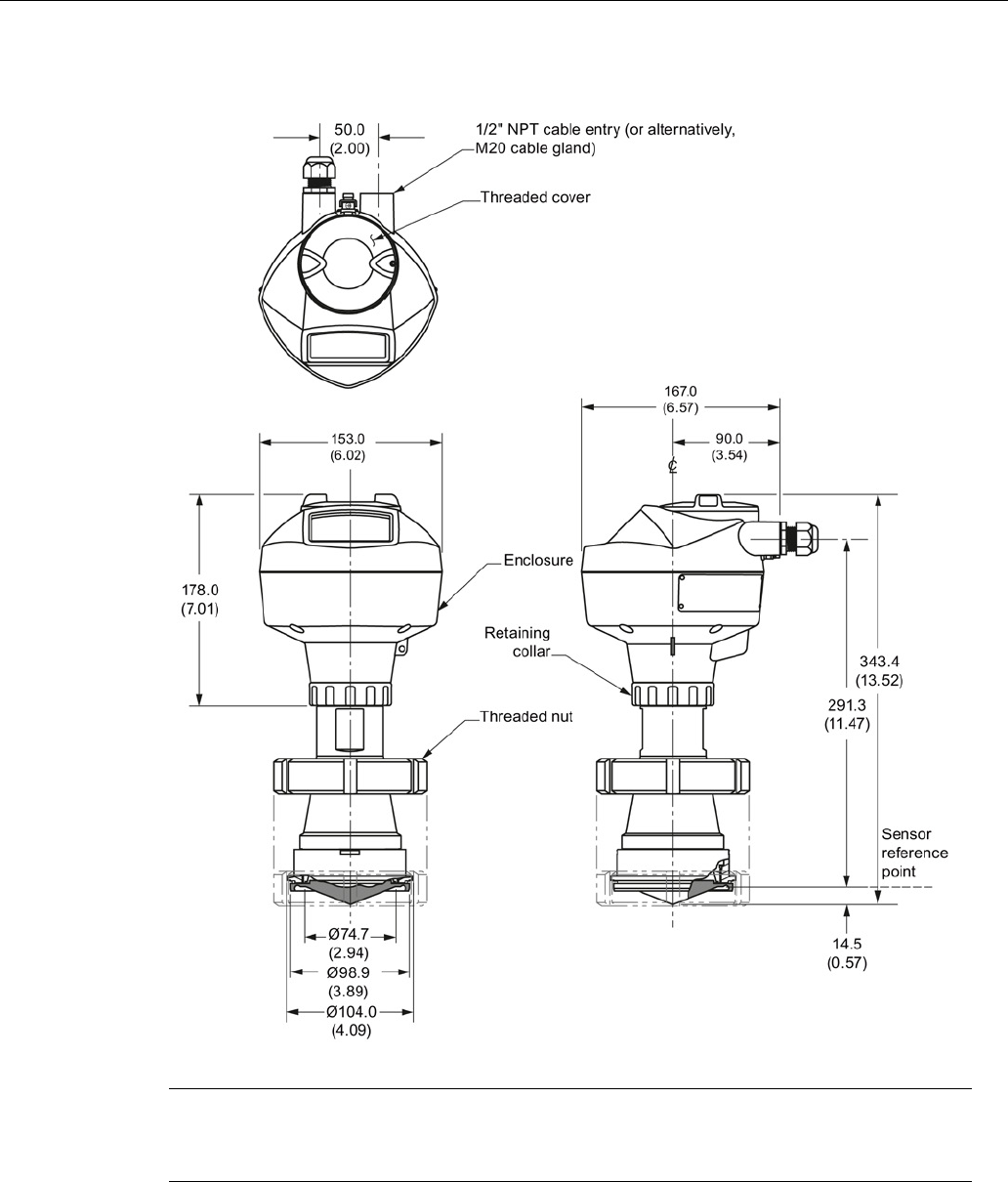
Dimension drawings
12.14 Hygienic encapsulated antenna (DN 80 aseptic clamp to DIN 11864-1)
SITRANS LR250 (mA/HART)
Operating Instructions, 08/2014, A5E32220602-AC 229
12.14
Hygienic encapsulated antenna (DN 80 aseptic clamp to DIN 11864-1)
Dimensions in mm (inch)
Note
Cut out of process connection and placement of threaded nut are shown for illustration
purposes only.
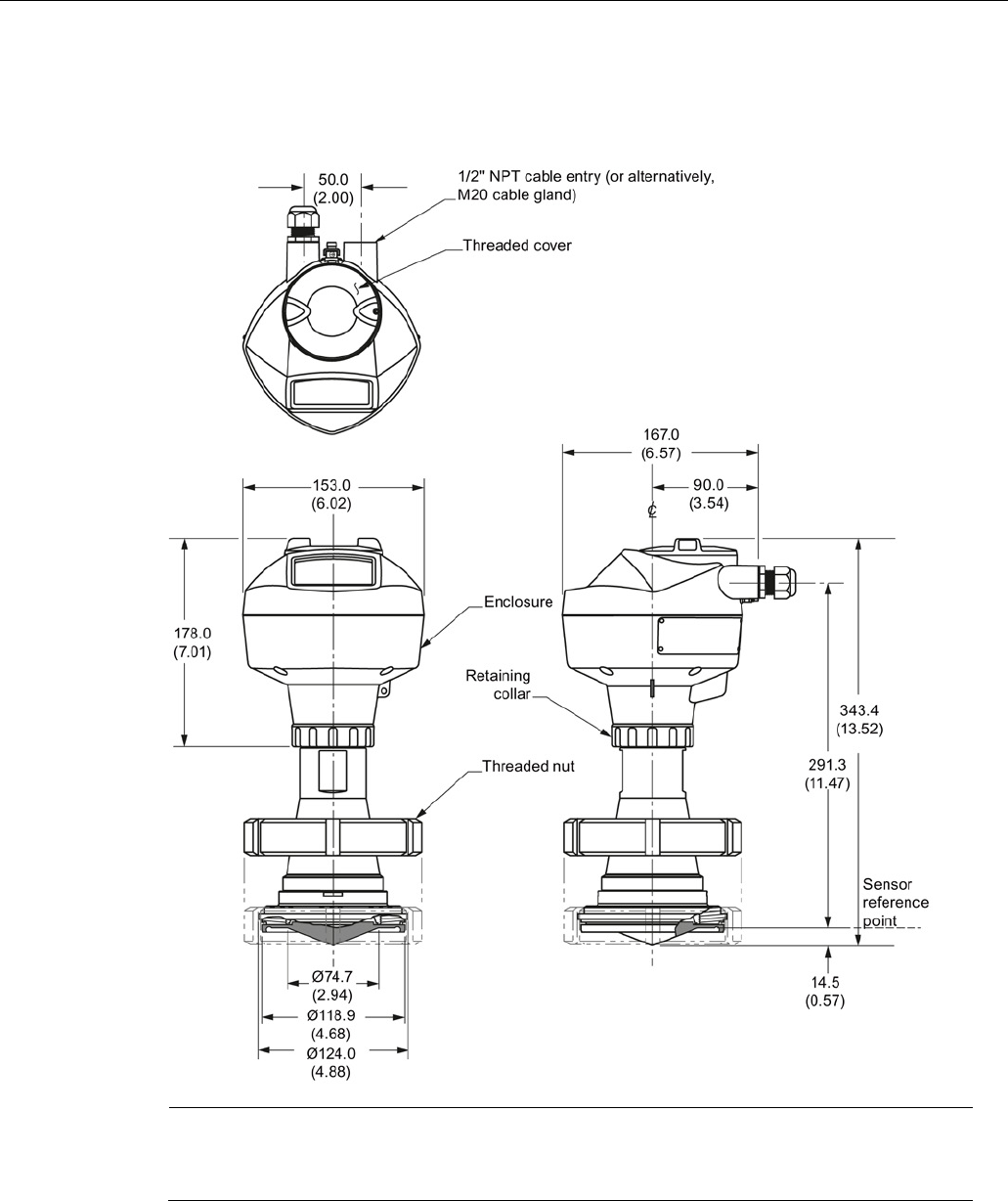
Dimension drawings
12.15 Hygienic encapsulated antenna (DN 100 aseptic clamp to DIN 11864-1)
SITRANS LR250 (mA/HART)
230 Operating Instructions, 08/2014, A5E32220602-AC
12.15
Hygienic encapsulated antenna (DN 100 aseptic clamp to DIN 11864-
1)
Dimensions in mm (inch)
Note
Cut out of process connection and placement of threaded nut are shown for illustration
purposes only.
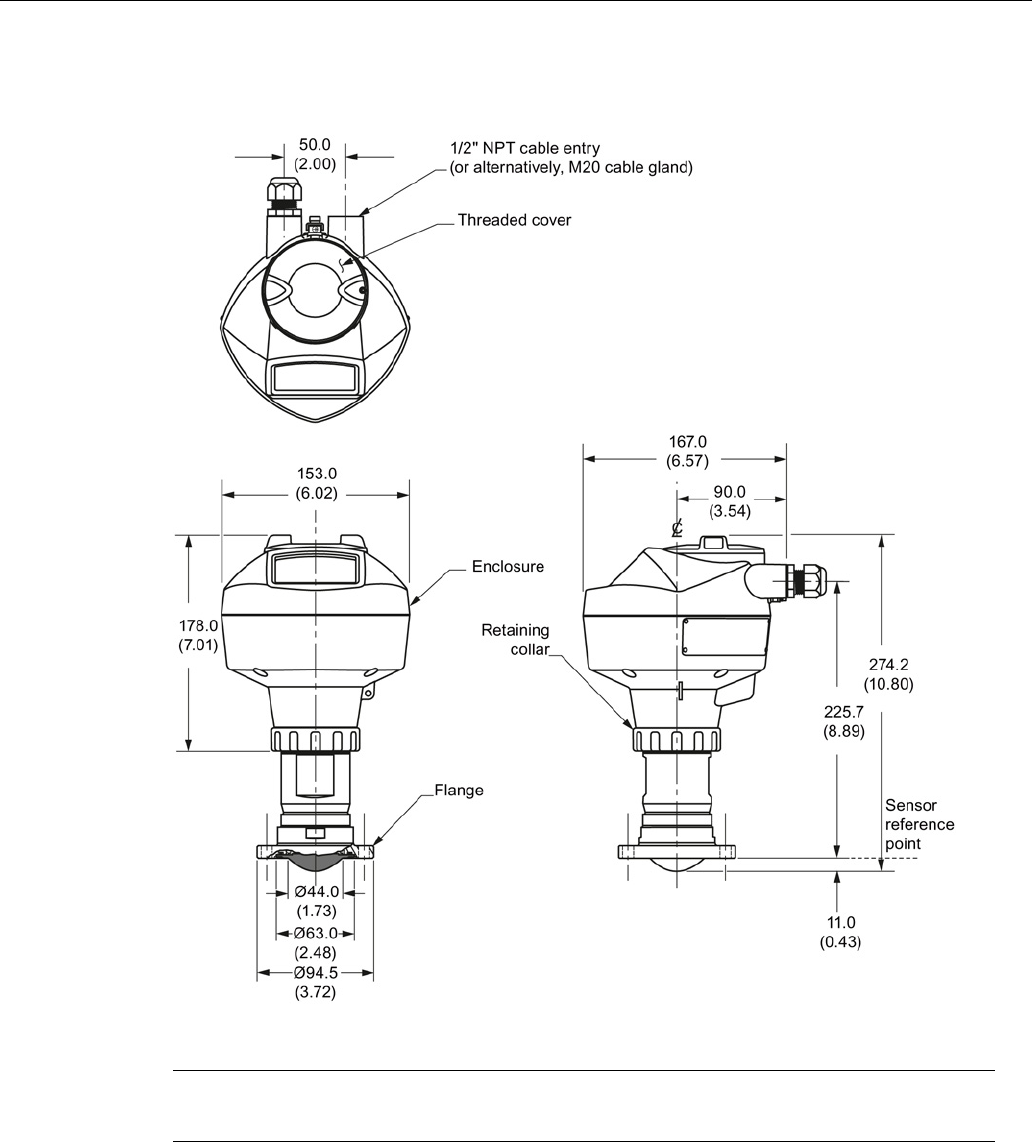
Dimension drawings
12.16 Hygienic encapsulated antenna (DN 50 aseptic flange to DIN 11864-2)
SITRANS LR250 (mA/HART)
Operating Instructions, 08/2014, A5E32220602-AC 231
12.16
Hygienic encapsulated antenna (DN 50 aseptic flange to DIN 11864-2)
Dimensions in mm (inch)
Note
Cut out of process connection and flange are shown for illustration
purposes only.
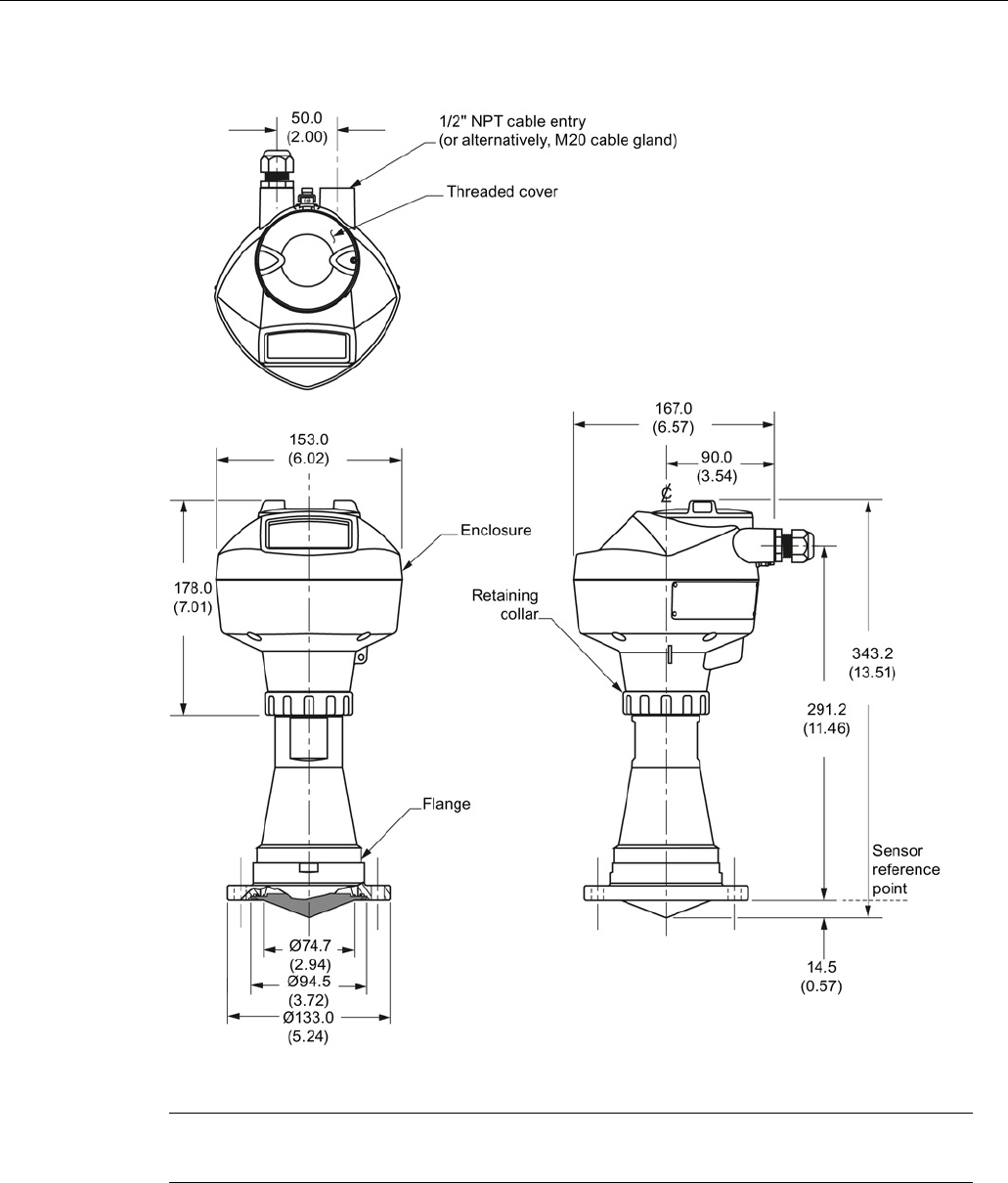
Dimension drawings
12.17 Hygienic encapsulated antenna (DN 80 aseptic flange to DIN 11864-2)
SITRANS LR250 (mA/HART)
232 Operating Instructions, 08/2014, A5E32220602-AC
12.17
Hygienic encapsulated antenna (DN 80 aseptic flange to DIN 11864-2)
Dimensions in mm (inch)
Note
Cut out of process connection and flange are shown for illustration purposes only.
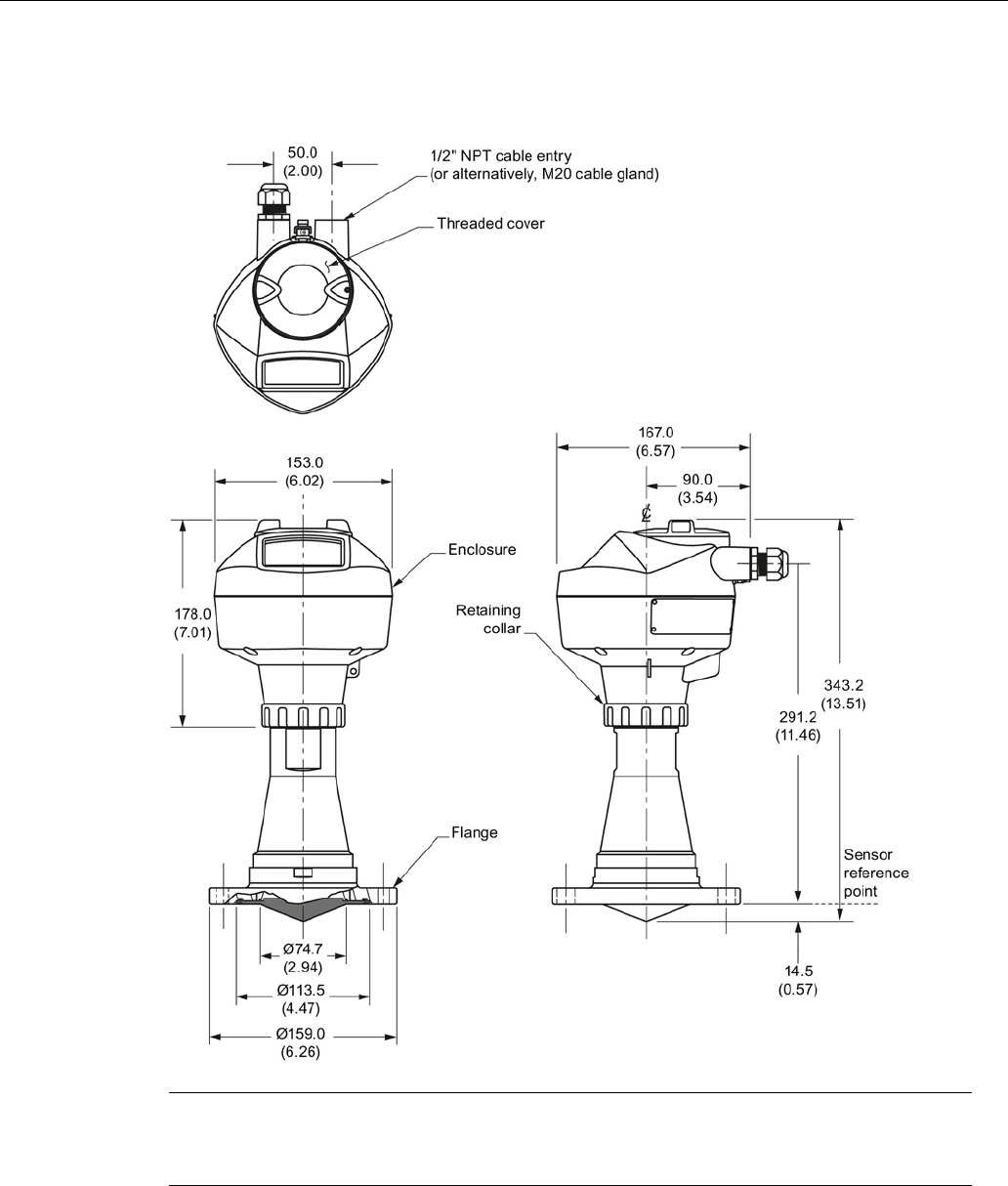
Dimension drawings
12.18 Hygienic encapsulated antenna (DN 100 aseptic flange to DIN 11864-2)
SITRANS LR250 (mA/HART)
Operating Instructions, 08/2014, A5E32220602-AC 233
12.18
Hygienic encapsulated antenna (DN 100 aseptic flange to DIN 11864-
2)
Dimensions in mm (inch)
Note
The cut out of the process connection and the flange are shown for illustration purposes
only.
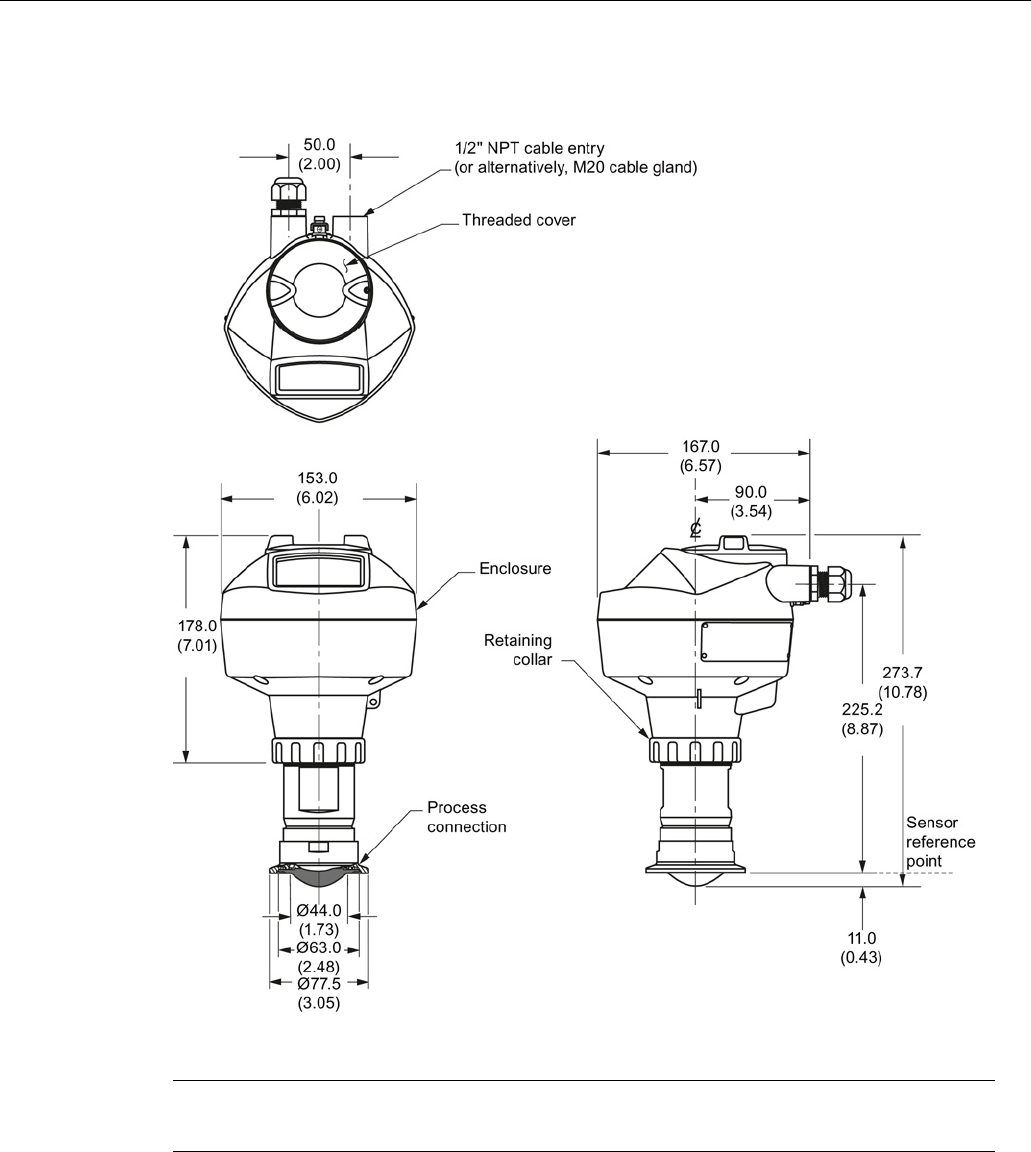
Dimension drawings
12.19 Hygienic encapsulated antenna (DN 50 aseptic clamp to DIN 11864-3)
SITRANS LR250 (mA/HART)
234 Operating Instructions, 08/2014, A5E32220602-AC
12.19
Hygienic encapsulated antenna (DN 50 aseptic clamp to DIN 11864-3)
Dimensions in mm (inch)
Note
Cut out of process connection is shown for illustration purposes only.
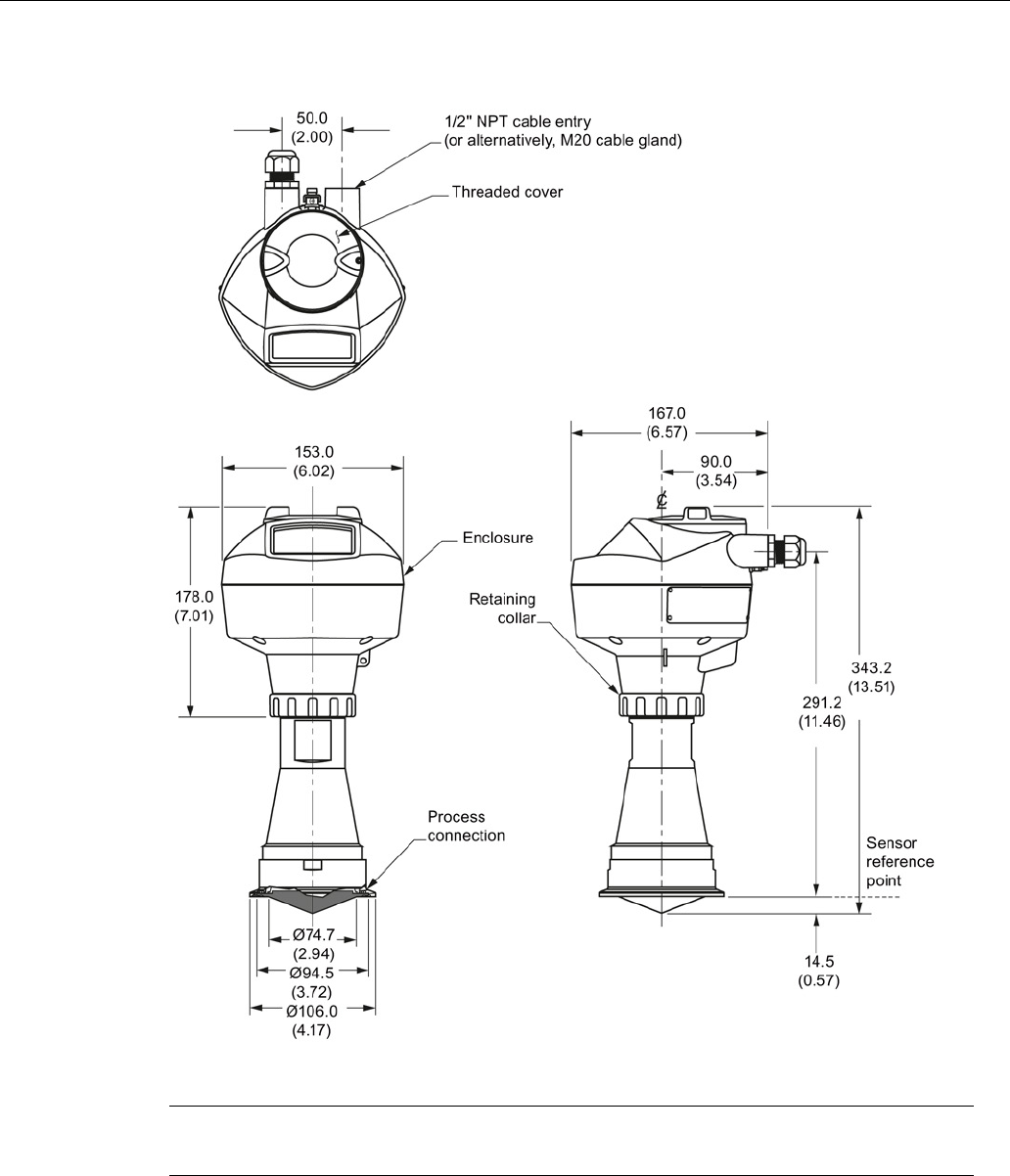
Dimension drawings
12.20 Hygienic encapsulated antenna (DN 80 aseptic clamp to DIN 11864-3)
SITRANS LR250 (mA/HART)
Operating Instructions, 08/2014, A5E32220602-AC 235
12.20
Hygienic encapsulated antenna (DN 80 aseptic clamp to DIN 11864-3)
Dimensions in mm (inch)
Note
Cut out of process connection is shown for illustration purposes only.
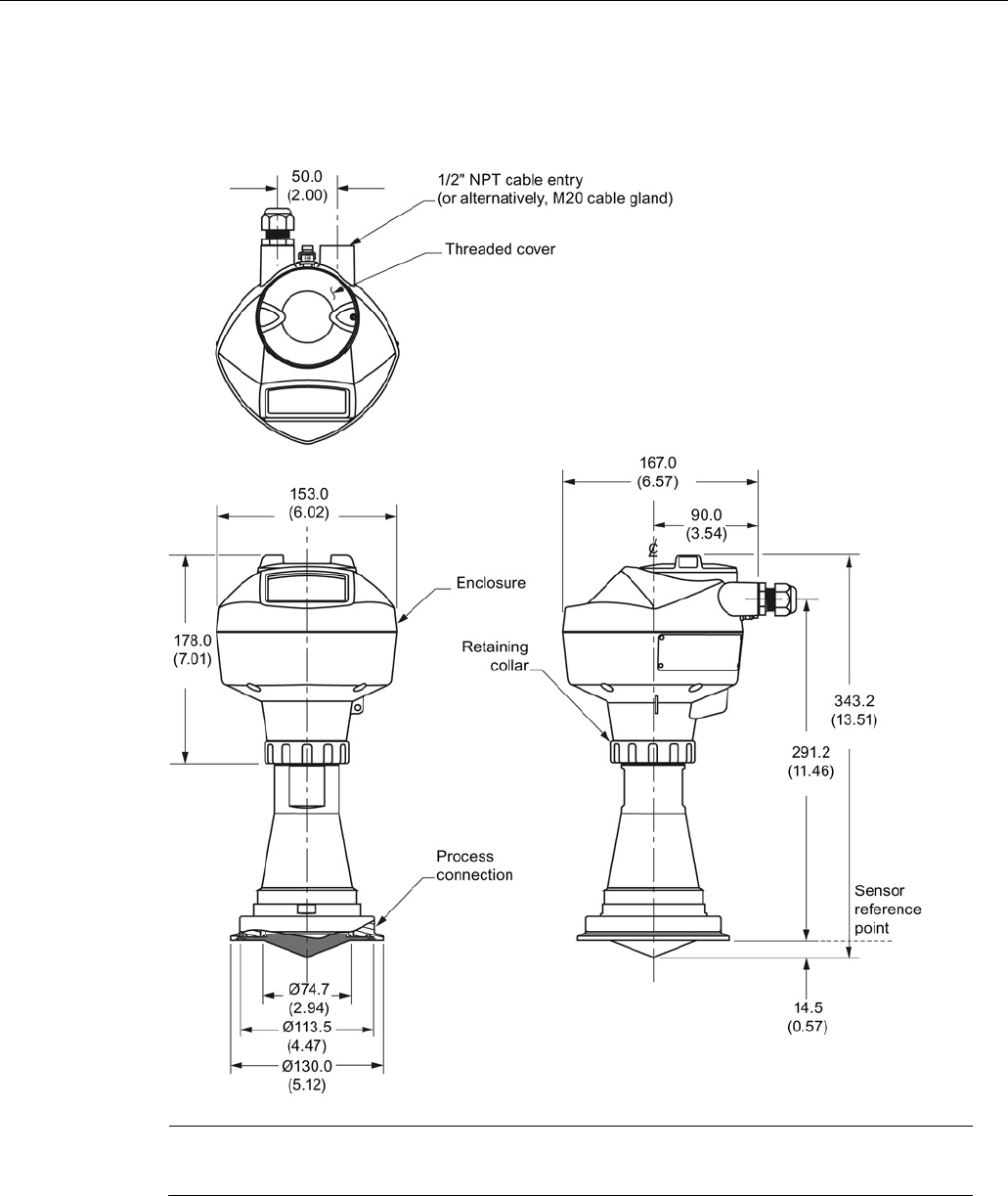
Dimension drawings
12.21 Hygienic encapsulated antenna (DN 100 aseptic clamp to DIN 11864-3)
SITRANS LR250 (mA/HART)
236 Operating Instructions, 08/2014, A5E32220602-AC
12.21
Hygienic encapsulated antenna (DN 100 aseptic clamp to DIN 11864-
3)
Dimensions in mm (inch)
Note
Cut out of process connection
is shown for illustration purposes only.
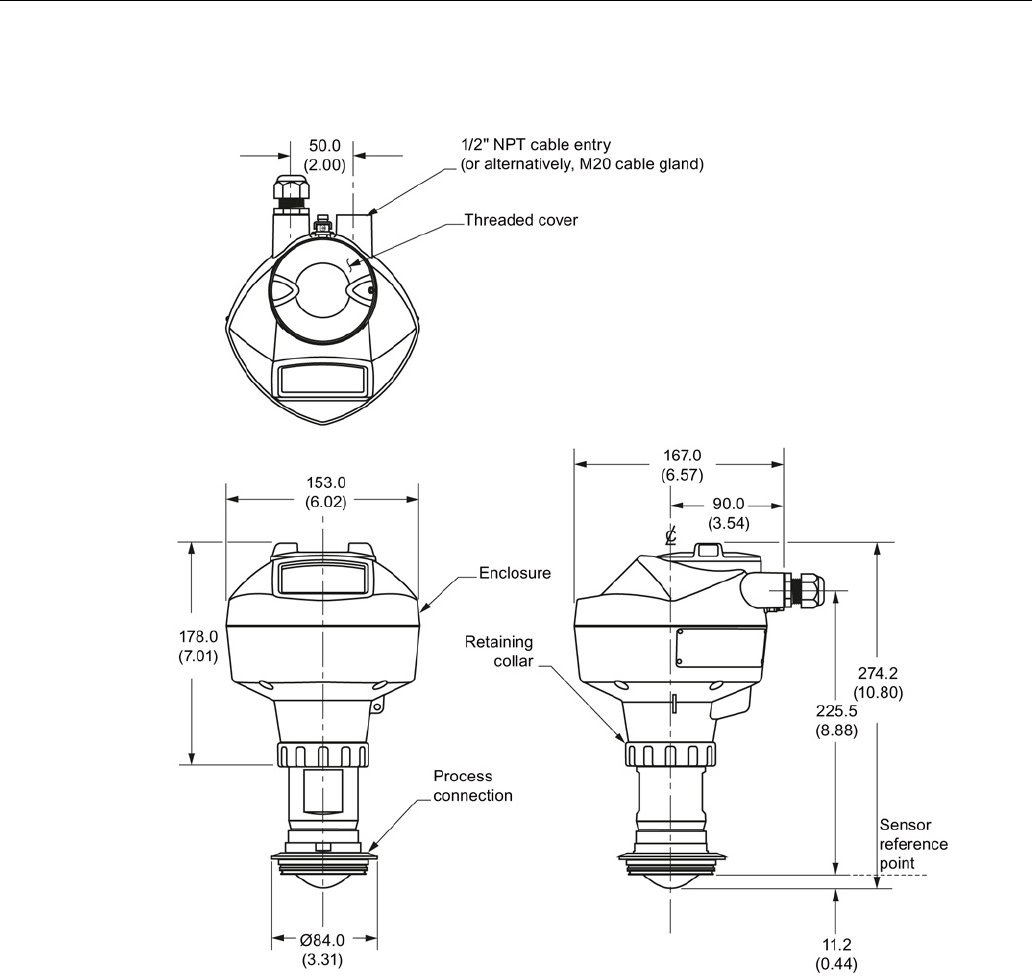
Dimension drawings
12.22 Hygienic encapsulated antenna (Tuchenhagen Type N)
SITRANS LR250 (mA/HART)
Operating Instructions, 08/2014, A5E32220602-AC 237
12.22
Hygienic encapsulated antenna (Tuchenhagen Type N)
Dimensions in mm (inch)
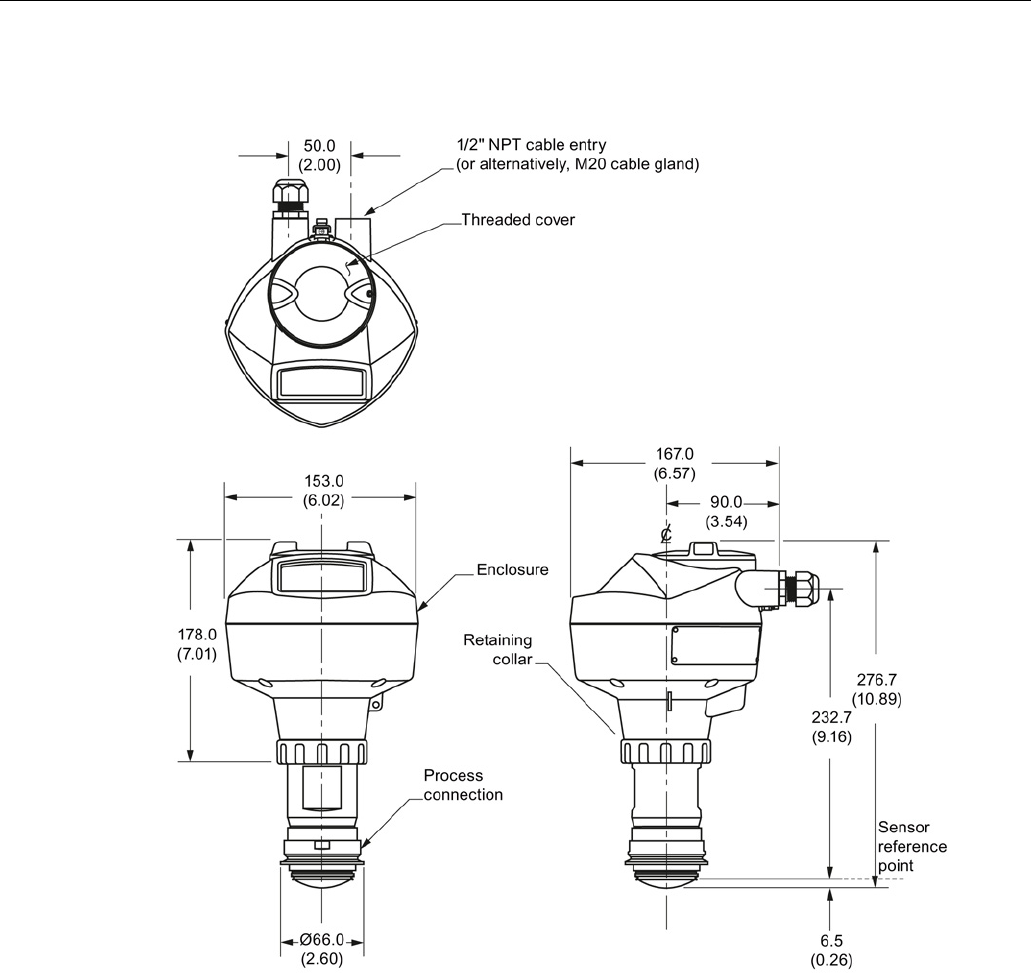
Dimension drawings
12.23 Hygienic encapsulated antenna (Tuchenhagen Type F)
SITRANS LR250 (mA/HART)
238 Operating Instructions, 08/2014, A5E32220602-AC
12.23
Hygienic encapsulated antenna (Tuchenhagen Type F)
Dimensions in mm (inch)

Dimension drawings
12.24 Threaded PVDF antenna
SITRANS LR250 (mA/HART)
Operating Instructions, 08/2014, A5E32220602-AC 239
12.24
Threaded PVDF antenna

Dimension drawings
12.25 Threaded connection markings
SITRANS LR250 (mA/HART)
240 Operating Instructions, 08/2014, A5E32220602-AC
Threaded PVDF antenna dimensions
Nominal antenna
size
Antenna O.D.
Height to sensor
reference point a)
Beam angle b)
Measurement
range
50 mm (2")
49.5 mm (1.94")
121 mm (4.76")
19 degrees
10 m (32.8 ft)
c)
a) Height from bottom of antenna to sensor reference point as shown: see dimension drawing.
b) -3dB in the direction of the polarization axis. See Polarization reference point (Page 31) for an
illustration.
c) 20m when installed in stillpipe.
12.25
Threaded connection markings
With the exception of the threaded PVDF antenna, threaded connection markings are found on
the flat face/faces of the process connection.
Serial number: a unique number allotted to each process connection, including the date of
manufacture (MMDDYY) followed by a number from 001 to 999, (indicating the sequential unit
produced).
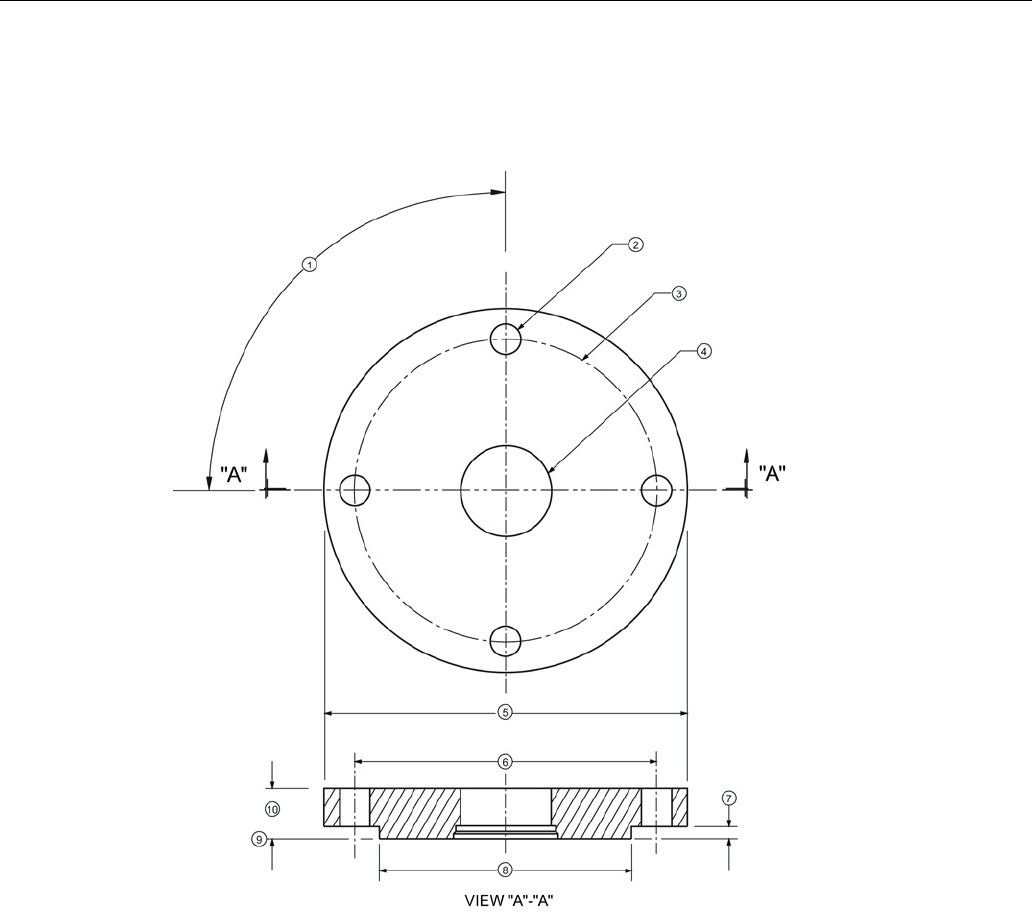
Dimension drawings
12.26 Raised-Face flange per EN 1092-1 for flanged horn antenna
SITRANS LR250 (mA/HART)
Operating Instructions, 08/2014, A5E32220602-AC 241
12.26
Raised-Face flange per EN 1092-1 for flanged horn antenna
Stainless steel or optional alloy N06022/2.4602 (Hastelloy® C-22)
①
angle of adjacent bolt holes
⑥
bolt hole circle diameter
②
bolt hole diameter
⑦
facing height
③
bolt hole circle diameter
⑧
facing diameter
④
waveguide mounting hole
⑨
sensor reference point
⑤
Flange O.D.
⑩
thickness

Dimension drawings
12.26 Raised-Face flange per EN 1092-1 for flanged horn antenna
SITRANS LR250 (mA/HART)
242 Operating Instructions, 08/2014, A5E32220602-AC
Raised-Face flange dimensions
Pipe size
Flange bolt
hole pattern
⑤
Flange
O.D.
(mm)
③
Bolt hole
circle Ø
(mm)
②
Bolt hole Ø
(mm)
No. of bolts
①
Angle of
adjacent
bolt holes
⑧
Facing Ø
(mm)
⑩
Thickness
(mm)
DN50
PN10/PN16
165
125
18
4
90
102
18
DN80
PN10/PN16
200
160
18
8
45
138
20
DN100
PN10/PN16
220
180
18
8
45
158
20
DN150
PN10/PN16
285
240
22
8
45
212
22
DN50
PN25/PN40
165
160
18
4
90
138
20
DN80
PN25/PN40
200
160
18
8
45
138
24
DN100
PN25/PN40
235
190
22
8
45
162
24
DN150
PN25/PN40
300
250
26
8
45
218
28
Raised-Face flange markings
Blind Flange Markings (Optional
Manufacturer’s Logo [optional]; Flange
Standard; Nominal Size; Material; Heat
Code)
Machining Identification
Welded Assembly Identification a)
Serial no.
Logo
Flange series
Flange
series
Heat Code
no.
Facing
Manufacturer’s logo; EN 1092-1 05 ‘B1’;
‘DN50’ ‘PN16’ ‘1.4404 or 1.4435’
A1B2C3
mmddyyx
xx xxxxx xxxxx A1B2C3 RF
a) When flange material is alloy N06022/2.4602, additional material and heat code identification
is provided.
The flange markings are located around the outside edge of the flange.
Serial number:
a unique number allotted to each flange, including the date of manufacture
(MMDDYY) followed by a number
from 001 to 999 (indicating the sequential
unit produced).
Flange series:
the Siemens Milltronics drawing identification.
Heat code:
a flange material batch code identification.
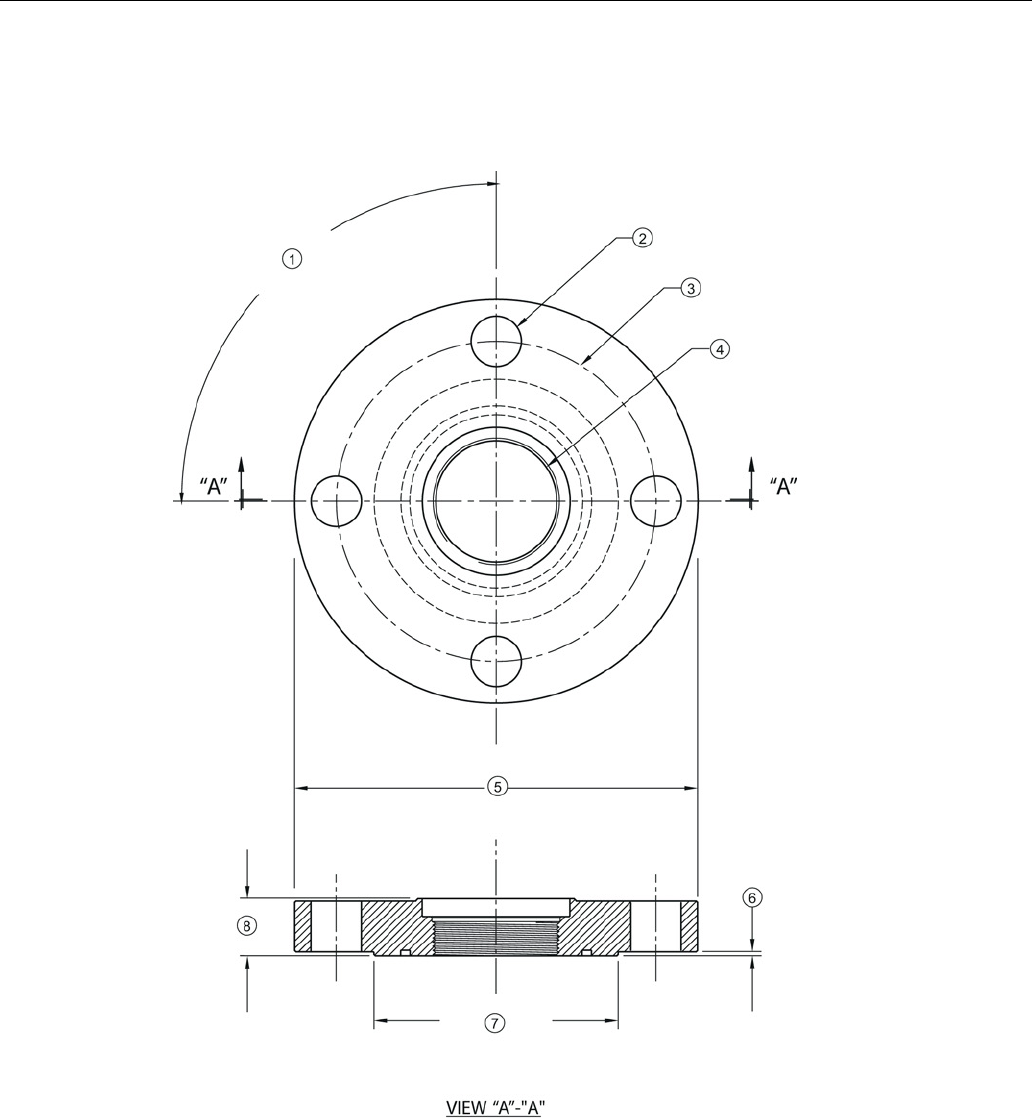
Dimension drawings
12.27 Raised-Face flange per EN 1092-1 for flanged encapsulated antenna
SITRANS LR250 (mA/HART)
Operating Instructions, 08/2014, A5E32220602-AC 243
12.27
Raised-Face flange per EN 1092-1 for flanged encapsulated antenna
Stainless steel
①
angle of adjacent bolt holes
⑤
flange O.D.
②
bolt hole diameter
⑥
facing height
③
bolt hole circle diameter
⑦
facing diameter
④
antenna
⑧
flange thickness

Dimension drawings
12.27 Raised-Face flange per EN 1092-1 for flanged encapsulated antenna
SITRANS LR250 (mA/HART)
244 Operating Instructions, 08/2014, A5E32220602-AC
Raised-Face flange dimensions
Pipe size
Flange class
⑤
Flange
O.D.
[mm
(inch)]
③
Bolt hole
circle Ø
[mm
(inch)]
②
Bolt hole
Ø [mm
(inch)]
No. of bolt
holes
①
Angle of
adjacent
bolt holes
⑦
Facing Ø
[mm
(inch)]
⑨
Flange
thickness
[mm
(inch)]
⑥
Flange
facing
thickness
[mm
(inch)]
2" 150 LB 152
(5.98)
120.7
(4.75)
19 (0.75) 4 90 92.1
(3.63)
20.6
(0.81)
1.5 (0.06)
3" 190
(7.48)
152.4
(6.00)
127 (5.00) 25.9
(1.02) 2 (0.08)
4" 230
(9.06)
190.5
(7.50)
8 45 157.2
(6.19)
2 (0.08)
6" 280
(11.02)
241.3
(9.50)
22.2
(0.87)
215.9
(8.50)
26.9
(1.06)
1.5 (0.06)
DN50 PN10/16 155
(6.10)
125 (4.92)
18 (0.71) 4 90 102 (4.02) 18 (0.71) 2 (0.08)
DN80 200
(7.87)
160 (6.30)
8 45 138 (5.43) 20 (0.79)
2 (0.08)
DN100 220
(8.66)
180 (7.09)
158 (6.22) 2 (0.08)
DN150 285
(11.22)
240 (9.45) 22 (0.87) 212 (8.35) 22 (0.87) 2 (0.08)
50A 10K 155
(6.10)
120 (4.72)
19 (0.75) 4 90 96 (3.78) 16 (0.63) 2 (0.08)
80A 185
(7.28)
150 (5.91)
8 45 126 (4.96) 18 (0.71)
2 (0.08)
100A 210
(8.27)
175 (6.89) 151 (5.94) 2 (0.08)
150A 280
(11.02)
240 (9.45) 23 (0.91) 212 (8.35) 22 (0.87) 2 (0.08)

Dimension drawings
12.27 Raised-Face flange per EN 1092-1 for flanged encapsulated antenna
SITRANS LR250 (mA/HART)
Operating Instructions, 08/2014, A5E32220602-AC 245
Raised-Face flange markings
Blind Flange Markings (Optional
Manufacturer’s Logo [optional]; Flange
Standard; Nominal Size; Material; Heat
Code)
Machining Identification
Welded Assembly Identification
Serial no.
Logo
Flange series
Flange
series
Heat Code
no.
Facing
Manufacturer’s logo; EN 1092-1 05 ‘B1’;
‘DN50’ ‘PN16’ ‘1.4404 or 1.4435’
A1B2C3
mmddyyx
xx xxxxx xxxxx A1B2C3 RF
The flange markings are located around the outside edge of the flange.
Serial number:
a unique number allotted to each flange, including the date of manufacture
(MMDDYY) followed by a number from 001 to 999 (indicating the sequential
unit produced).
Flange series:
the Siemens Milltronics drawing identification.
Heat code:
a flange material batch code identification.
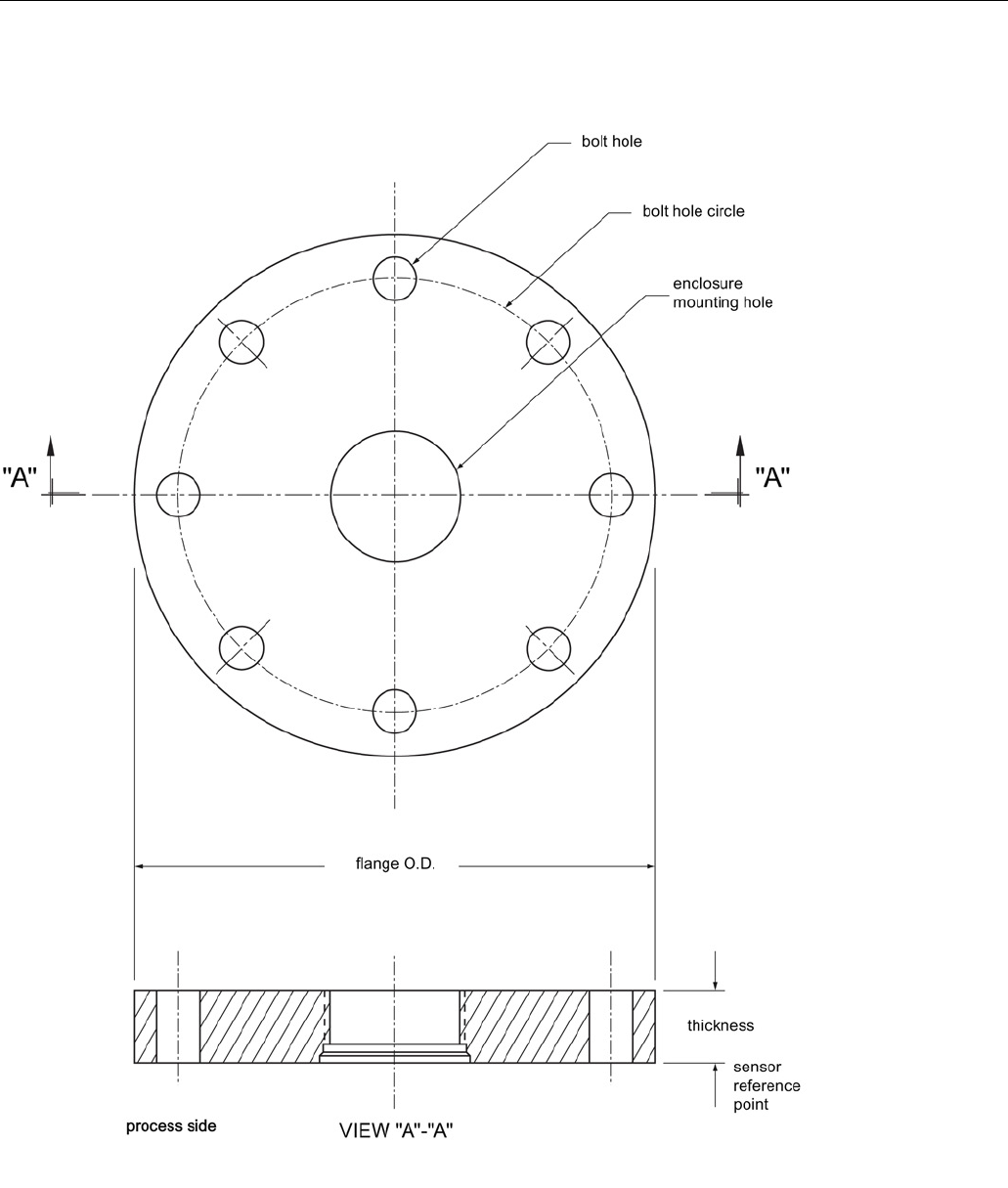
Dimension drawings
12.28 Flat-Face flange
SITRANS LR250 (mA/HART)
246 Operating Instructions, 08/2014, A5E32220602-AC
12.28
Flat-Face flange

Dimension drawings
12.28 Flat-Face flange
SITRANS LR250 (mA/HART)
Operating Instructions, 08/2014, A5E32220602-AC 247
Flat-Face flange dimensions
Flange size a)
Flange class
Flange O.D.
Bolt hole circle
Ø
Bolt hole Ø
No. of bolt
holes
Thickness
2"
ASME 150 lb
6.0"
4.75"
0.75"
4
0.88"
3"
ASME 150 lb
7.5"
6.0"
0.75"
4
0.96"
4"
ASME 150 lb
9.0"
7.50"
0.75"
8
1.25"
2"
ASME 300 lb
6.50"
5.00"
0.75"
8
1.12"
3"
ASME 300 lb
8.25"
6.62"
0.88"
8
1.38"
4"
ASME 300 lb
10.00"
7.88"
0.88"
8
1.50"
DN50
EN PN16
165 mm
125 mm
18 mm
4
24.4 mm
DN80
EN PN16
200 mm
160 mm
18 mm
8
31.8 mm
DN100
EN PN16
220 mm
180 mm
18 mm
8
31.8 mm
DN50
EN PN40
165 mm
125 mm
18 mm
4
25.4 mm
DN80
EN PN40
200 mm
160 mm
18 mm
8
31.8 mm
DN100
EN PN40
235 mm
190 mm
22 mm
8
38.1 mm
50A
JIS 10K
155 mm
120 mm
19 mm
4
23.8 mm
80A
JIS 10K
185 mm
150 mm
19 mm
8
24.4 mm
100A
JIS 10K
210 mm
175 mm
19 mm
8
28.5 mm
a) A 2" flange is designed to fit a 2" pipe: for actual flange dimensions see Flange O.D. Flange
markings located around the outside edge of the flat faced flange identify the flange assembly on
which the device is mounted.

Dimension drawings
12.28 Flat-Face flange
SITRANS LR250 (mA/HART)
248 Operating Instructions, 08/2014, A5E32220602-AC
Flat-Face flange markings
Flat Face Flange Identification
Welded Assembly
Identification
Serial No. Logo
Flange series
Material Heat
code Flange
series Heat code
no.
Series
Nominal size
MMDDYYXXX 25556
2
150
316L/ 1.4404 or
316L/ 1.4435 A1B2C3 25546 A1B2C3
DN80
PN16
Serial number:
A
unique number allotted to each flange, including the date of manufacture
(MMDDYY) followed by a number from 001 to 999 (indicating the sequential
unit produced).
Flange series:
The Siemens Milltronics drawing identification.
Nominal size:
The flange s
ize followed by the hole pattern for a particular flange class. For
example:
•
A 2 inch ASME B16.5 150 lb class flange (North America)
•
A DN80 EN 1092-1 PN16 class flange (Europe)
Material:
The basic flange material (AISI or EU material designation). North
American
material codes are followed by European ones. For example, material
designation 316L/1.4404.
Heat code:
A flange material batch code identification.
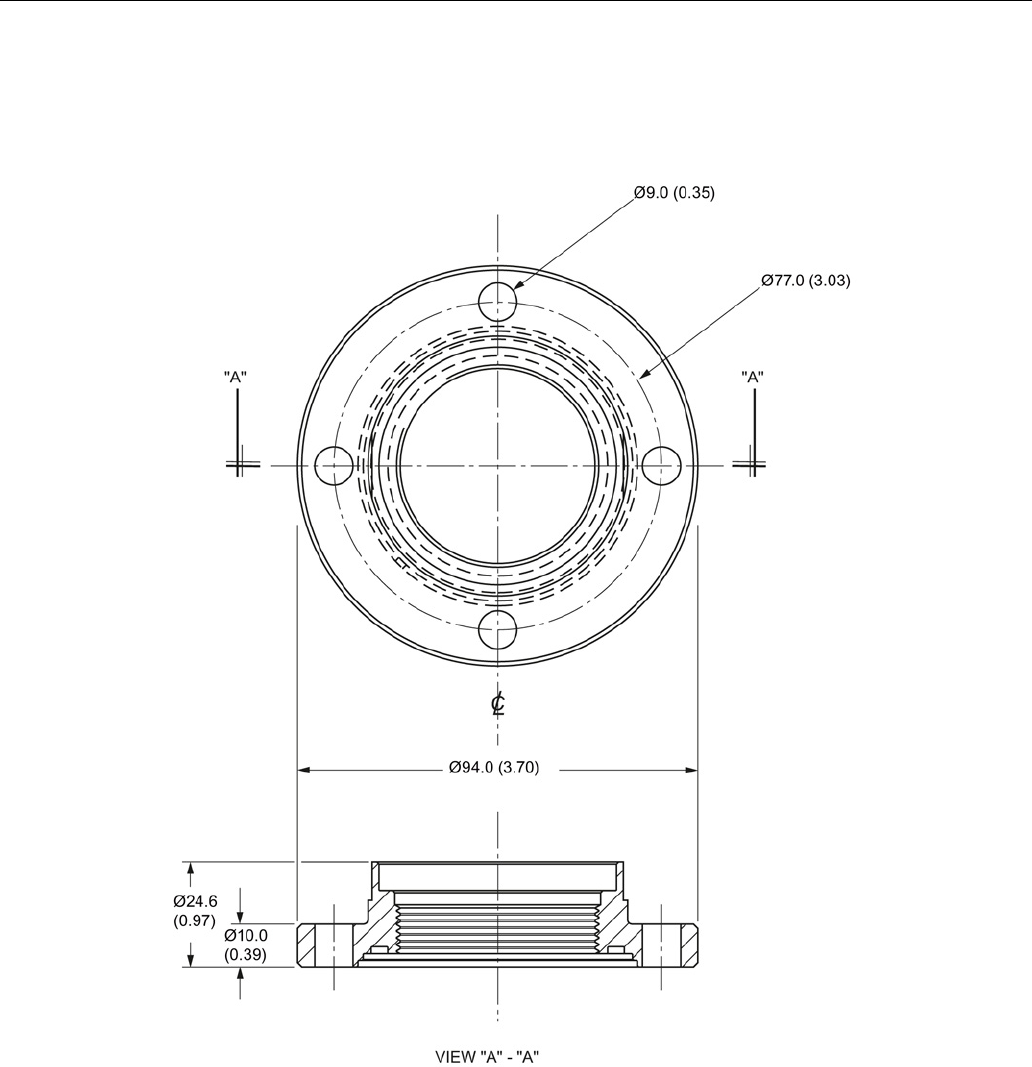
Dimension drawings
12.29 Aseptic/hygienic flange DN50, DN80, DN100 for DIN 11864-2
SITRANS LR250 (mA/HART)
Operating Instructions, 08/2014, A5E32220602-AC 249
12.29
Aseptic/hygienic flange DN50, DN80, DN100 for DIN 11864-2
Aseptic/hygienic flange DN50
Dimensions in mm (inch)
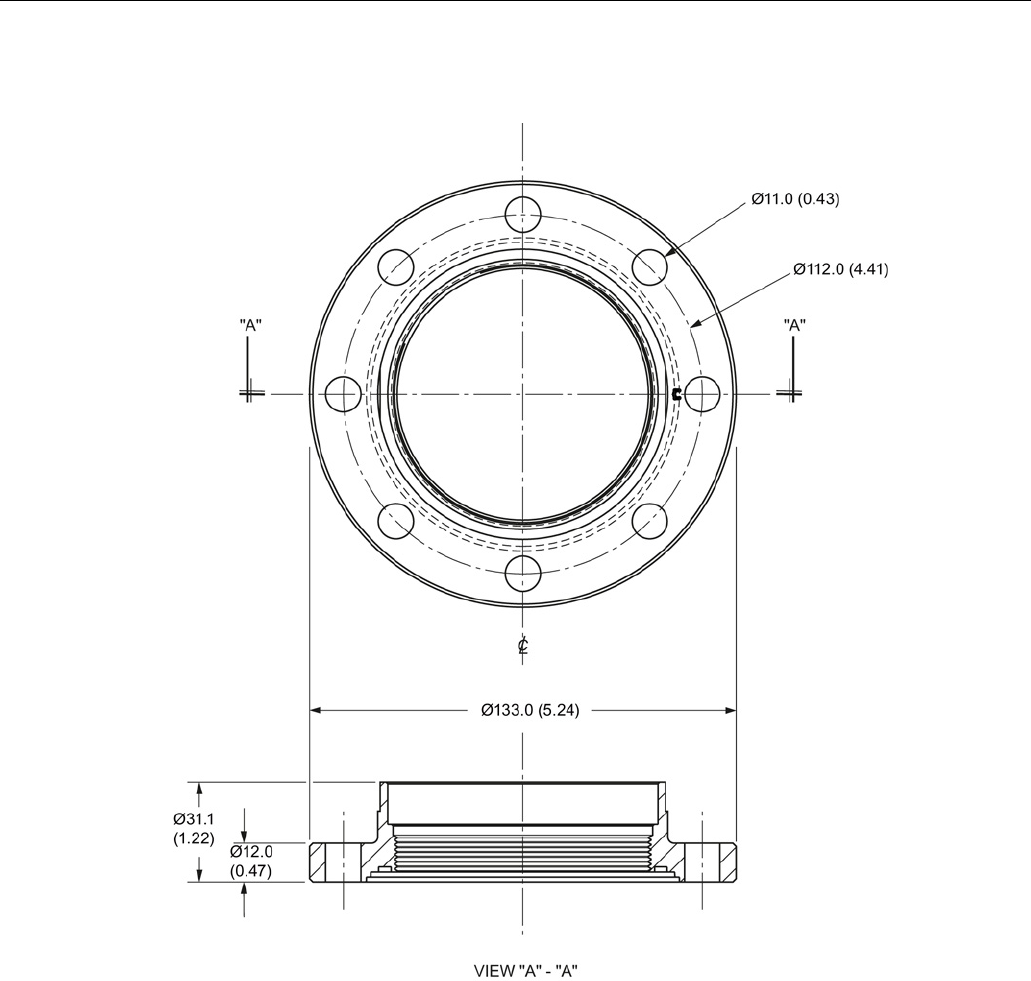
Dimension drawings
12.29 Aseptic/hygienic flange DN50, DN80, DN100 for DIN 11864-2
SITRANS LR250 (mA/HART)
250 Operating Instructions, 08/2014, A5E32220602-AC
Aseptic/hygienic flange DN80
Dimensions in mm (inch)
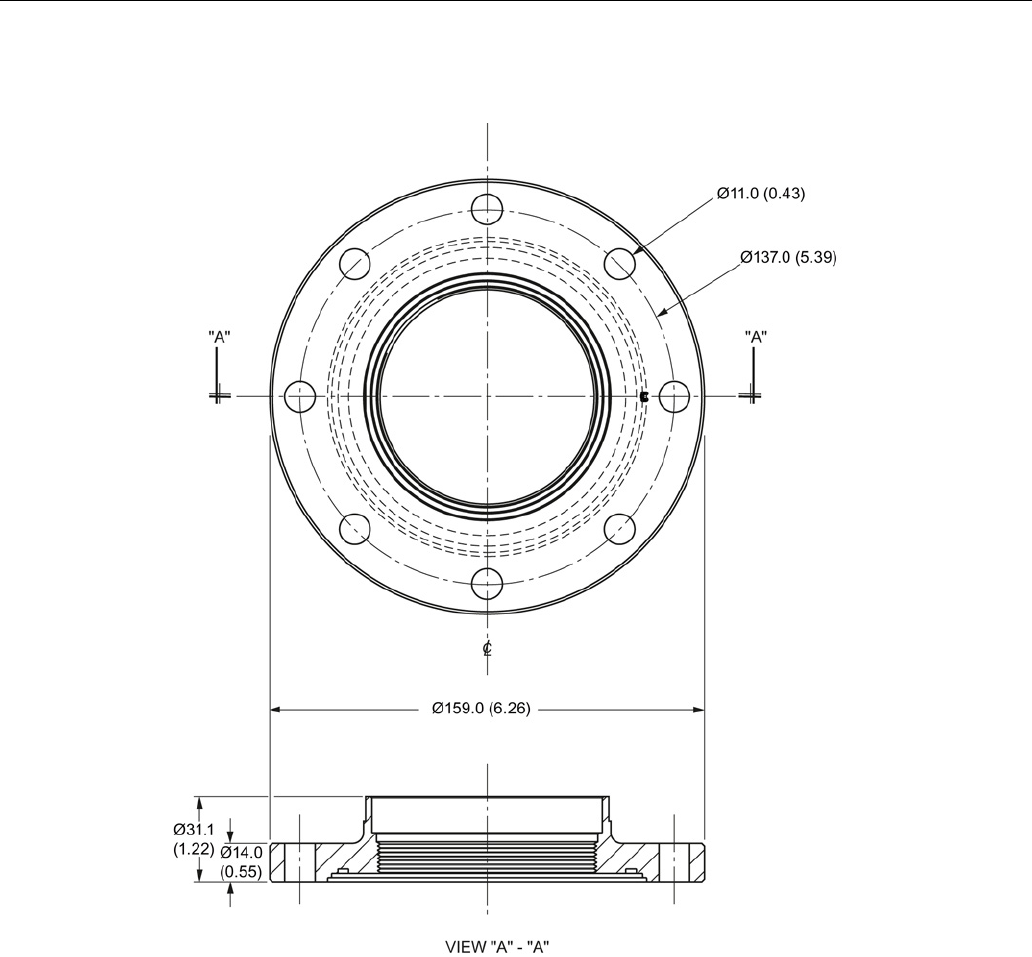
Dimension drawings
12.29 Aseptic/hygienic flange DN50, DN80, DN100 for DIN 11864-2
SITRANS LR250 (mA/HART)
Operating Instructions, 08/2014, A5E32220602-AC 251
Aseptic/hygienic flange DN100
Dimensions in mm (inch)
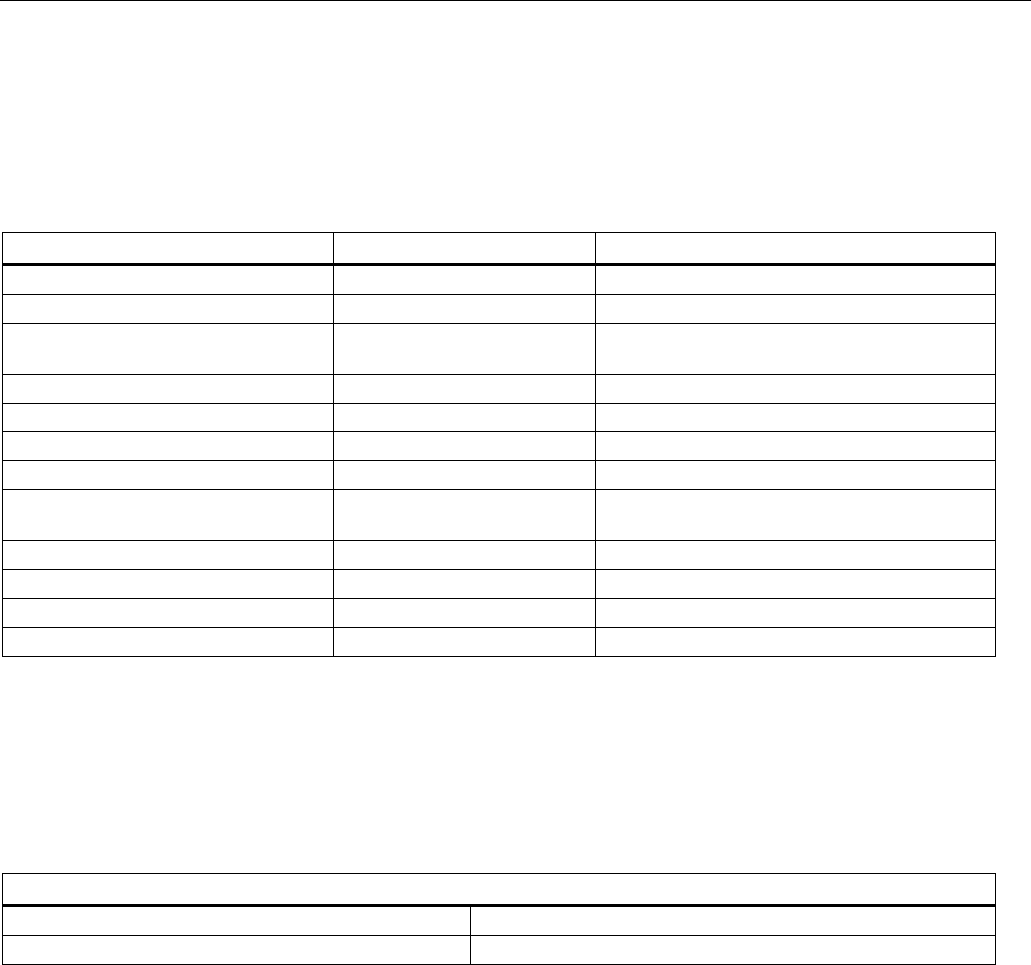
Dimension drawings
12.30 Process connection tag (pressure rated versions)
SITRANS LR250 (mA/HART)
252 Operating Instructions, 08/2014, A5E32220602-AC
12.30
Process connection tag (pressure rated versions)
For pressure-rated versions only, the process connection label lists the following information:
Process connection tag (pressure rated versions)
Item
Sample Text
Comments/Explanation
SERIAL #
GYZ / 00000000
Pressure Boundary Assembly
NOMINAL PIPE SIZE (DN)
4 INCH / 100mm
Nominal Pipe Size
INSTRUMENT MAWP (PS)
11.0
BAR
Maximum Allowable Working Pressure at
Design Temperature for the device
DESIGN TEMP. (TS)
200 ºC
Maximum Allowable Working Temperature
MINIMUM PROCESS
15.9 BAR AT 40 ºC
Minimum Wetted Process Conditions
TEST PRESSURE (PT)
22.7 BAR
Production Test Pressure
TEST DATE
10/11/11
Date of Pressure Test (Year/Month/Day)
CONNECTION SERIES
ASME B16.5 Flange Series: dimensional pattern based on
ASME B16.5 flange standards
PROCESS SERIES
25546
Pressure Tag Family Series
WETTED NON-METALLICS
TFM
Antenna Emitter
WETTED METALLICS
316L Process Connection Material(s)
WETTED SEALS
FKM
Seal Material(s)
● Minimum Wetted Process Conditions: the minimum pressure and temperature to which the
device assembly may be exposed in the process, and continue to provide a pressure-
retaining function.
● Pressure Tag Family Series: the identification number used to indicate specific process
connection information relating to operating conditions.
● For Flanged encapsulated antenna: this information is laser-etched on antenna body
BACK FACE
Sample Text
Comments/Explanation
CRN 0Fxxxxx.5
Canadian Registration Number (CRN)

SITRANS LR250 (mA/HART)
Operating Instructions, 08/2014, A5E32220602-AC 253
Appendix A: Technical reference
A
Note
Where a number follows the parameter name [for example, Master Reset (4.1.)
] this is the
parameter access number via the handheld programmer.
See Parameter Reference
(Page
127) for a complete list of parameters.
A.1
Principles of operation
SITRANS LR250 is a 2-wire 25 GHz pulse radar level transmitter for continuous monitoring of
liquids and slurries. (The microwave output level is significantly less than that emitted from
cellular phones.) Radar level measurement uses the time of flight principle to determine distance
to a material surface. The device transmits a signal and waits for the return echo. The transit
time is directly proportional to the distance from the material.
Pulse radar uses polarized electromagnetic waves. Microwave pulses are emitted from the
antenna at a fixed repetition rate, and reflect off the interface between two materials with
different dielectric constants (the atmosphere and the material being monitored).
Electromagnetic wave propagation is virtually unaffected by temperature or pressure changes,
or by changes in the vapor levels inside a vessel. Electromagnetic waves are not attenuated by
dust.
SITRANS LR250 consists of an enclosed electronic circuit coupled to an antenna and process
connection. The electronic circuit generates a radar signal (25 GHz) that is directed to the
antenna.
The signal is emitted from the antenna, and the reflected echoes are digitally converted to an
echo profile. The profile is analyzed to determine the distance from the material surface to the
sensor reference point. See Dimension drawings (Page 209). This distance is used as a basis
for the display of material level and mA output.

Appendix A: Technical reference
A.2 Echo Processing
SITRANS LR250 (mA/HART)
254 Operating Instructions, 08/2014, A5E32220602-AC
A.2
Echo Processing
A.2.1
Process Intelligence
The signal processing technology embedded in Siemens radar level devices is known as
Process Intelligence
.
Process intelligence provides high measurement reliability regardless of the dynamically
changing conditions within the vessel being monitored. The embedded Process Intelligence
dynamically adjusts to the constantly changing material surfaces within these vessels.
Process Intelligence is able to differentiate between the true microwave reflections from the
surface of the material and unwanted reflections being returned from obstructions such as seam
welds or supports within a vessel. The result is repeatable, fast and reliable measurement. This
technology was developed as result of field data gained over some twenty years from more than
1,000,000 installations in many industries around the world.
Higher order mathematical techniques and algorithms are used to provide intelligent processing
of microwave reflection profiles. This "knowledge based" technique produces superior
performance and reliability.
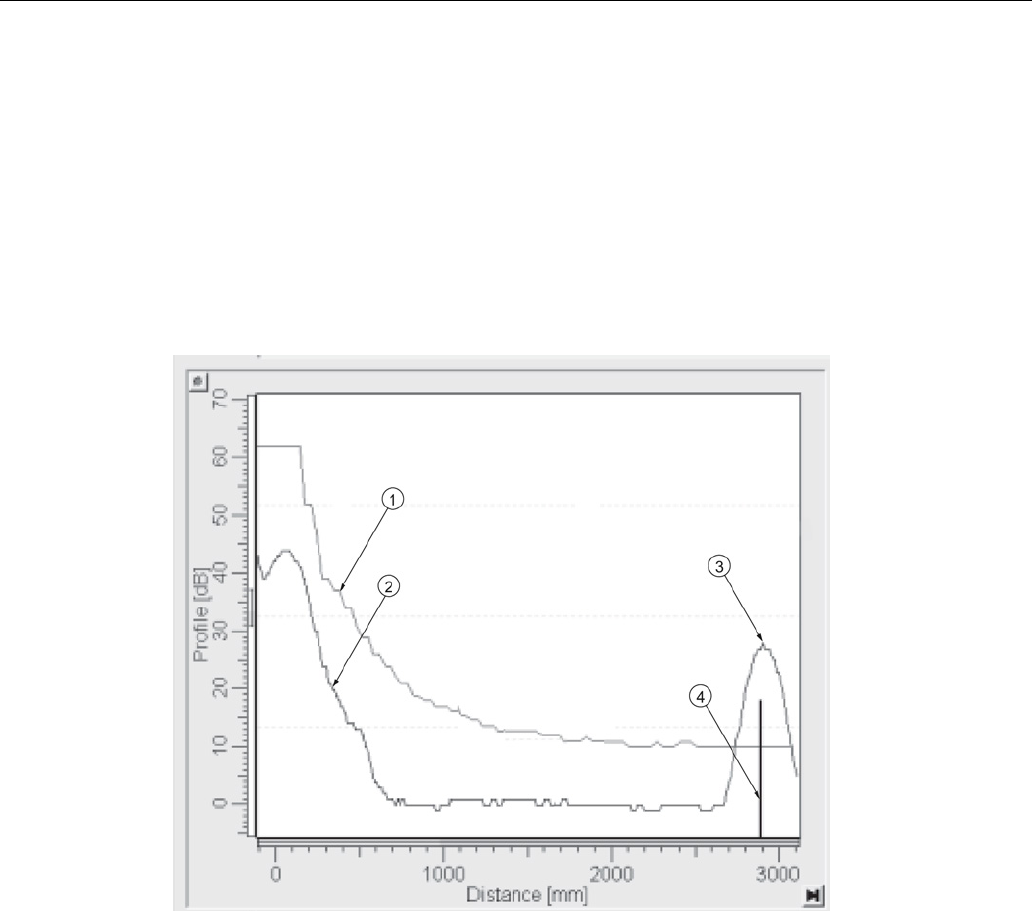
Appendix A: Technical reference
A.2 Echo Processing
SITRANS LR250 (mA/HART)
Operating Instructions, 08/2014, A5E32220602-AC 255
A.2.2
Echo Selection
Time Varying Threshold (TVT)
A Time Varying Threshold (TVT) hovers above the echo profile to screen out unwanted
reflections (false echoes).
In most cases the material echo is the only one which rises above the default TVT.
In a vessel with obstructions, a false echo may occur. See Auto False Echo Suppression
(Page 259) for more details.
①
default TVT
②
echo profile
③
material level
④
echo marker
The device characterizes all echoes that rise above the TVT as potential good echoes. Each
peak is assigned a rating based on its strength, area, height above the TVT, and reliability,
amongst other characteristics.
Algorithm (2.8.4.1.)
The true echo is selected based on the setting for the Echo selection algorithm. Options are
t
rue
F
irst Echo,
L
argest Echo, or
b
est of
F
irst and
L
argest.

Appendix A: Technical reference
A.2 Echo Processing
SITRANS LR250 (mA/HART)
256 Operating Instructions, 08/2014, A5E32220602-AC
Position Detect (2.8.4.2.)
The echo position detection algorithm determines which point on the echo will be used to
calculate the precise time of flight, and calculates the range using the calibrated propagation
velocity (see
Propagation Factor (2.8.3.)
for values). There are three options:
●
Center
●
Hybrid
●
CLEF
(Constrained Leading Edge Fit)
Center
Uses center of the echo.
Hybrid
Uses the Center algorithm for the top part of the vessel, and the CLEF algorithm for the part
nearest the vessel bottom, according to the setting for
CLEF range
.
CLEF (Constrained Leading Edge Fit)
● Uses the leading edge of the echo.
● Is used mainly to process the echo from materials with a low dK value.
In an almost empty flat-bottomed vessel, a low dK material may reflect an echo weaker than the
echo from the vessel bottom. The echo profile shows these echoes merging. The device may
then report a material level equal to or lower than empty.
The CLEF algorithm enables the device to report the level correctly.
Example: CLEF off: Position set to Hybrid
Vessel height: 1.5 m; CLEF range set to 0 (Center algorithm gives the same result.)
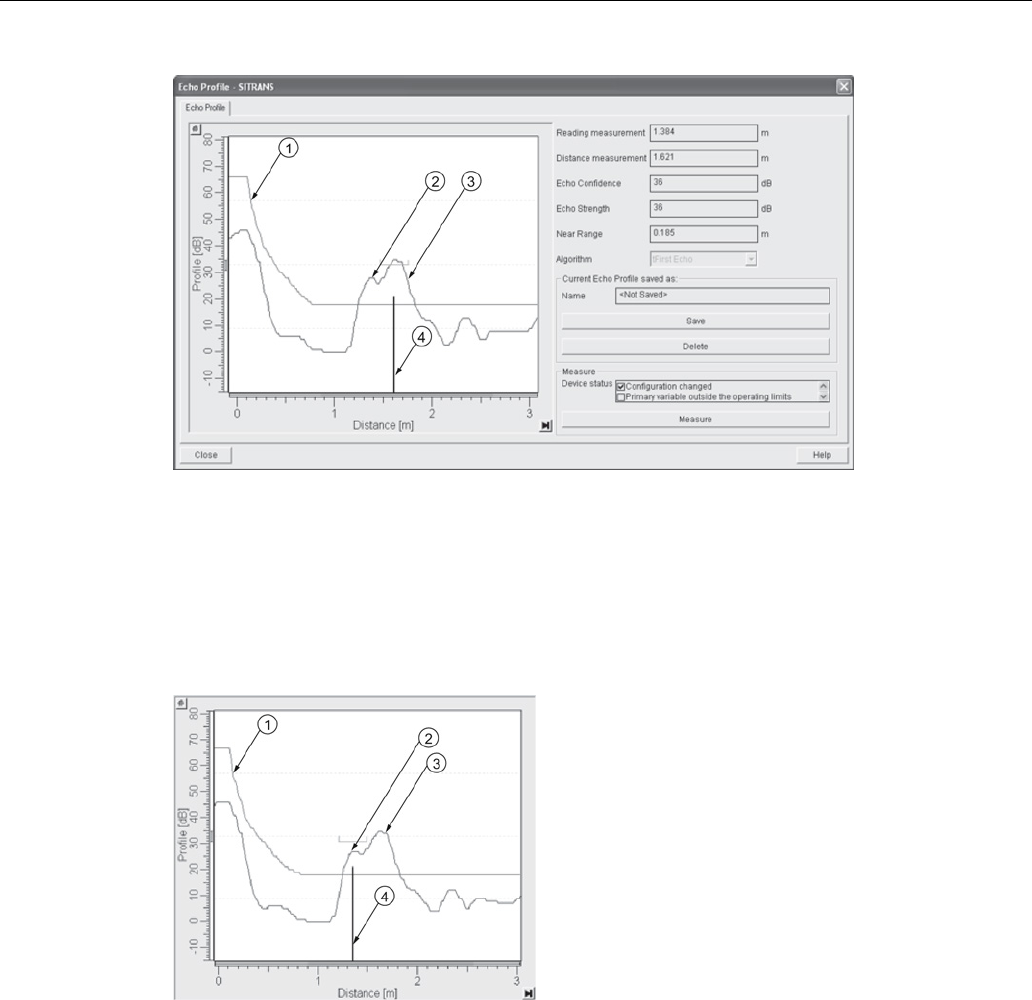
Appendix A: Technical reference
A.2 Echo Processing
SITRANS LR250 (mA/HART)
Operating Instructions, 08/2014, A5E32220602-AC 257
①
default TVT
②
material echo
③
vessel bottom echo selected
④
echo marker
Example: CLEF enabled
Vessel height: 1.5 m; CLEF range set to 0.5 m
①
default TVT
②
material echo selected
③
vessel bottom echo
④
echo marker
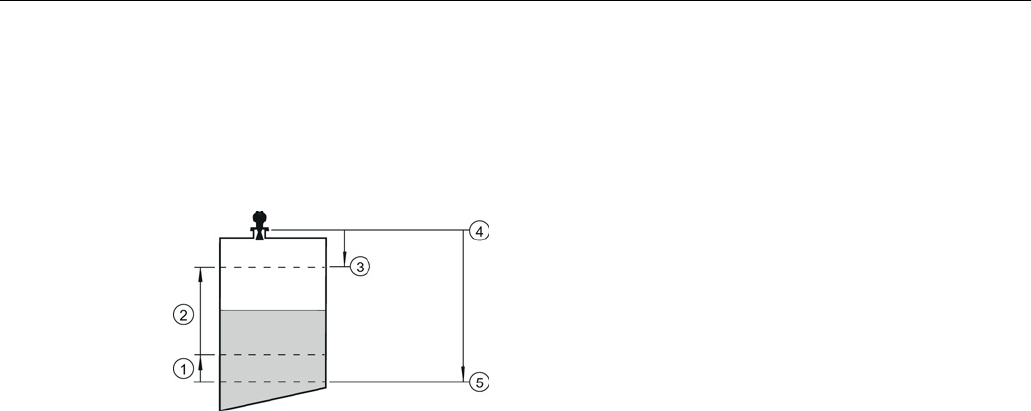
Appendix A: Technical reference
A.2 Echo Processing
SITRANS LR250 (mA/HART)
258 Operating Instructions, 08/2014, A5E32220602-AC
A.2.3
CLEF Range
CLEF Range (2.8.4.4.)
is referenced from Low Calibration Point (process empty level ). When
the
Hybrid
algorithm is selected in
Position Detect (2.8.4.2.)
, the CLEF algorithm will be applied
up to the limit of CLEF Range. Above this limit the Center algorithm will be applied.
①
CLEF Range
②
(Center algorithm applied)
③
High Calibration Point (process full level)
④
Sensor reference point
⑤
Low Calibration Point (process empty level )
A.2.4
Echo Threshold
Confidence (2.8.6.1.)
describes the quality of an echo. Higher values represent higher quality.
Echo Threshold (2.8.4.3.)
defines the minimum confidence value required for an echo to be
accepted as valid and evaluated.
A.2.5
Echo Lock
If the echo selected by
Algorithm
is within the Echo Lock window, the window is centered about
the echo, which is used to derive the measurement. In radar applications, two measurement
verification options are used with
Echo Lock (2.8.5.1.)
:
Lock Off
SITRANS LR250 responds immediately to a new selected echo (within the restrictions set by the
Maximum Fill / Empty Rate), but measurement reliability is affected.
Material Agitator
A new measurement outside the Echo Lock Window must meet the sampling criteria before the
window will move to include it.
The other available options,
Maximum Verification
and
Total Lock
are not recommended for
radar.

Appendix A: Technical reference
A.2 Echo Processing
SITRANS LR250 (mA/HART)
Operating Instructions, 08/2014, A5E32220602-AC 259
A.2.6
Auto False Echo Suppression
Note
•
For detailed instructions on using this feature via PDM see Auto False Echo Suppression
(Page 92).
•
For detailed instructions on using this feature via the handheld programmer see
Auto
False Echo Suppression (2.8.7.1.).
Auto False Echo Suppression is designed to learn a specific environment (for example, a
particular vessel with known obstructions), and in conjunction with Auto False Echo Suppression
Range to remove false echoes appearing in front of the material echo.
The material level should be below all known obstructions at the moment when Auto False Echo
Suppression learns the echo profile. Ideally the vessel should be empty or almost empty, and if
an agitator is present, it should be running.
The device learns the echo profile over the whole measurement range and the TVT is shaped
around all echoes present at that moment.
Auto False Echo Suppression Range (2.8.7.2.)
Auto False Echo Suppression Range specifies the range within which the learned TVT is
applied. Default TVT is applied over the remainder of the range.
The learned TVT screens out the false echoes caused by obstructions. The default TVT allows
the material echo to rise above it.
Auto False Echo Suppression Range must be set to a distance shorter than the distance to the
material level when the environment was learned, to avoid the material echo being screened out.
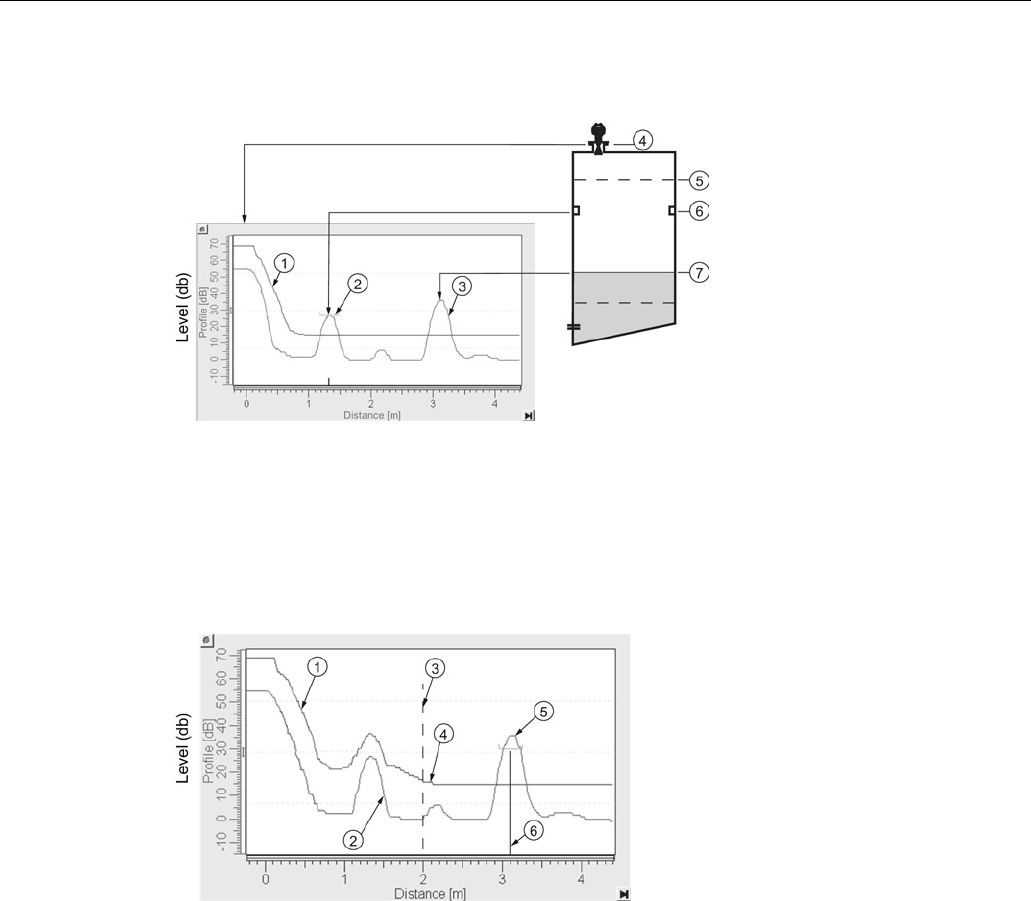
Appendix A: Technical reference
A.2 Echo Processing
SITRANS LR250 (mA/HART)
260 Operating Instructions, 08/2014, A5E32220602-AC
Example before Auto False Echo Suppression
①
default TVT
⑤
high calibration point = 0
②
false echo
⑥
obstruction at 1.3. m
③
material echo
⑦
material level at 3.2 m
④
sensor reference point
Example after Auto False Echo Suppression
Auto False Echo
Suppression
Range set to 2 m
①
learned TVT
④
default TVT
②
false echo
⑤
material echo
③
Auto False Echo Suppression Range
⑥
echo marker

Appendix A: Technical reference
A.2 Echo Processing
SITRANS LR250 (mA/HART)
Operating Instructions, 08/2014, A5E32220602-AC 261
A.2.7
Measurement Range
Near Range (2.8.1.)
Near Range programs SITRANS LR250 to ignore the zone in front of the antenna. The default
blanking distance is 50 mm (1.97") from the end of the antenna.
Near Range allows you to increase the blanking value from its factory default. But
Auto False
Echo Suppression (2.8.7.1.)
is generally recommended in preference to extending the blanking
distance from factory values.
Far Range (2.8.2.)
Far Range can be used in applications where the base of the vessel is conical or parabolic. A
reliable echo may be available below the vessel empty distance, due to an indirect reflection
path.
Increasing Far Range to 30% or 40% can provide stable empty vessel readings.
A.2.8
Measurement Response
Note
U
nits are defined in
Units (2.2.1.)
and are in meters by default.
Response Rate (2.4.1.)
limits the maximum rate at which the display and output respond to
changes in the measurement. There are three preset options: slow, medium, and fast.
Once the real process fill/empty rate (m/s by default) is established, a response rate can be
selected that is slightly higher than the application rate. Response Rate automatically adjusts the
filters that affect the output response rate.
Response Rate (2.4.1.)
Fill Rate per Minute (2.4.2.)/Empty Rate per
Minute (2.4.3.)
Damping Filter (2.2.4.)
*
Slow
0.1 m/min (0.32 ft/min)
10 s
Medium
1.0 m/min (3.28 ft.min)
10 s
Fast
10.0 m/min (32.8 ft/min)
0 s
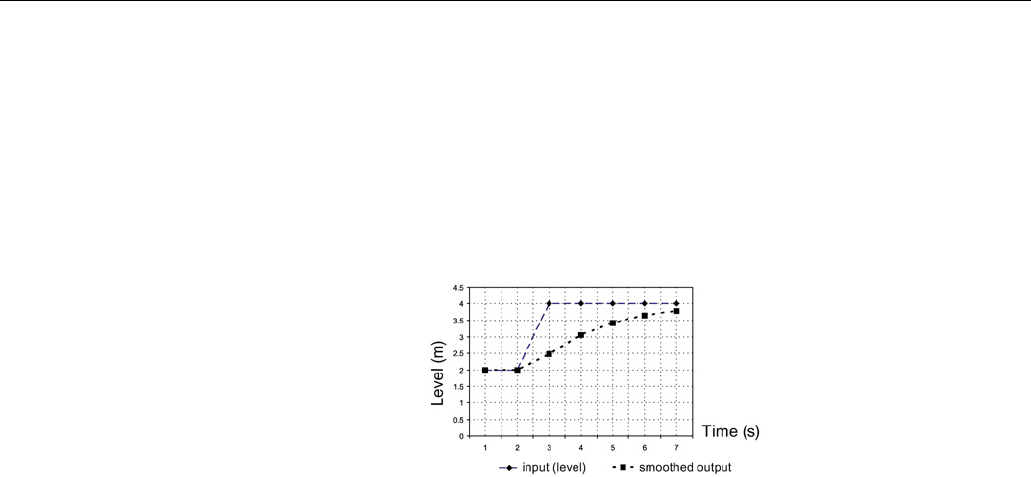
Appendix A: Technical reference
A.3 Analog Output
SITRANS LR250 (mA/HART)
262 Operating Instructions, 08/2014, A5E32220602-AC
A.2.9
Damping
Damping Filter (2.2.4.)
smooths out the response to a sudden change in level. This is an
exponential filter and the engineering unit is always in seconds.
In 5 time constants the output rises exponentially: from 63.2% of the change in the first time
constant, to almost 100% of the change by the end of the 5th time constant.
Damping example
time constant = 2 seconds
input (level) change = 2 m
A.3
Analog Output
The mA Output (current output) is proportional to material level in the range 4 to 20 mA. 0% and
100% are percentages of the full-scale reading (m, cm, mm, ft, in). Typically mA output is set so
that 4 mA equals 0% and 20 mA equals 100%.
When SITRANS LR250 is put into
PROGRAM
mode (for example, by navigating through the
menu) it stops updating the output of the device (local user interface and mA Output). It stores
the most recent measurement, and holds the associated readings and mA signal output. The
device reverts to the parameter last addressed during the previous program session.
When the device is returned to
Measurement
mode, the transceiver resumes operation. The
reading and mA output default to the last measurement taken. The reading and associated
outputs migrate to the current process level at a rate controlled by
Response Rate
(2.4.1.)
.
If the device is left in
PROGRAM
mode for 10 minutes without input, it automatically reverts to
Measurement
mode.
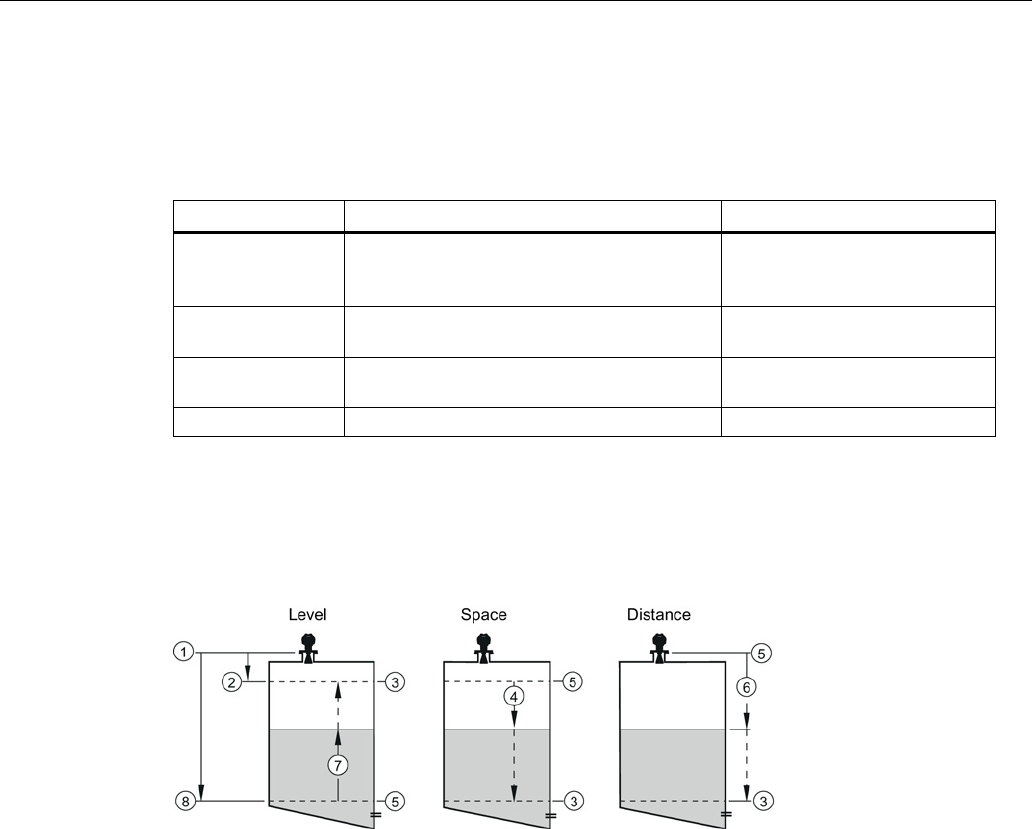
Appendix A: Technical reference
A.3 Analog Output
SITRANS LR250 (mA/HART)
Operating Instructions, 08/2014, A5E32220602-AC 263
A.3.1
Sensor Mode
This parameter controls the input. Depending on the reference point used, the measurement
reports either Level, Space, or Distance. By default Sensor Mode is set to
Level
.
Operation
Description
Reference point
NO SERVICE Measurement and associated loop current
not being updated. Device defaults to Fail-
safe mode
a)
.
LEVEL Distance to material surface Low Calibration Point (process
empty level)
SPACE Distance to material surface High Calibration Point (process
full level)
DISTANCE
Distance to material surface
Sensor reference point
a) See Fail-safe Mode (Page 265).
You also have the option to put the device out of service, in which case the device defaults to
Fail-safe mode, and the reported level depends on the device type. A standard device reports
the last valid reading, and a NAMUR NE 43-compliant device reports the user-defined value for
Material Level (3.58 mA by default).
①
Sensor reference point
⑤
4 mA 0%
②
High calibration point
⑥
Distance
③
20 mA 100%
⑦
Level
④
Space
⑧
Low calibration point

Appendix A: Technical reference
A.3 Analog Output
SITRANS LR250 (mA/HART)
264 Operating Instructions, 08/2014, A5E32220602-AC
A.3.2
Current Output Function
Current Output Function (2.6.1.)
controls the mA output and applies any relevant scaling. By
default it is set to
Level
. Other options are Space, Distance, and Volume. (The device can carry
out a volume calculation only after a vessel shape has been specified.)
When a volume application type is chosen, Sensor Mode remains as
Level
and the mA Output is
automatically converted to
Volume
.
To view the mA reading in the secondary region of the LCD, press on the handheld
programmer.
A.3.3
Loss of Echo (LOE)
A loss of echo (LOE) occurs when the calculated measurement is judged to be unreliable
because the echo confidence value has dropped below the echo confidence threshold.
Confidence (2.8.6.1.)
describes the quality of an echo. Higher values represent higher quality.
Echo Threshold (2.8.4.3.)
defines the minimum confidence value required for an echo to be
accepted as valid and evaluated.
If the LOE condition persists beyond the time limit set in
LOE Timer (2.5.2.)
the LCD displays the
Service Required icon, and the text region displays the fault code
S: 0
and the text LOE.
If two faults are present at the same time, the fault code, error text, and error icon for each fault
are displayed alternately. For example, Loss of Echo and Fail-safe.
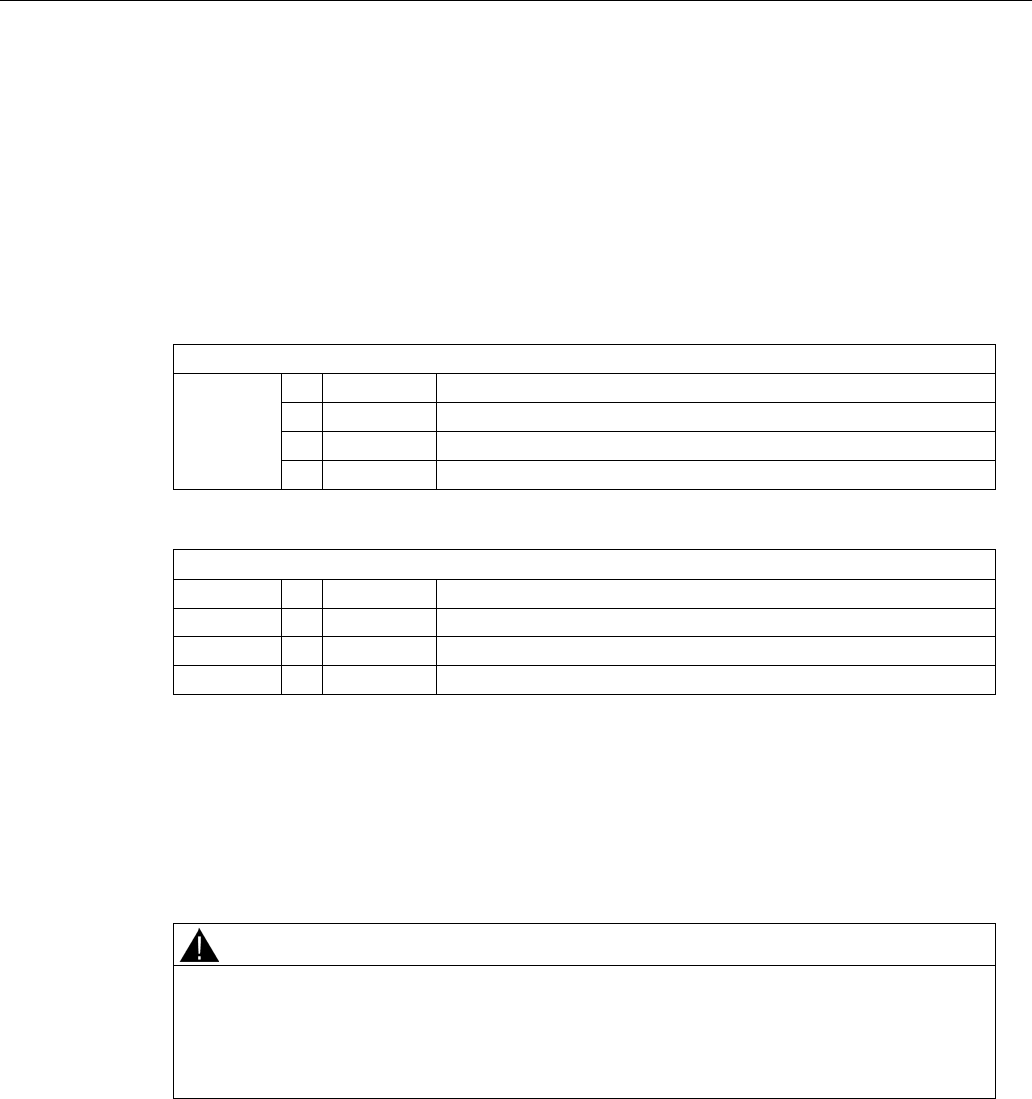
Appendix A: Technical reference
A.4 Maximum Process Temperature Chart
SITRANS LR250 (mA/HART)
Operating Instructions, 08/2014, A5E32220602-AC 265
A.3.4
Fail-safe Mode
The purpose of the Fail-safe setting is to put the process into a safe mode of operation in the
event of a fault or failure. The value to be reported in the event of a fault is selected so that a
loss of power or loss of signal triggers the same response as an unsafe level.
LOE Timer (2.5.2.)
determines the length of time a
Loss of Echo (LOE)
condition will persist
before a Fail-safe state is activated. The default setting is 100 seconds.
Material Level (2.5.1.)
determines the material level to be reported when
LOE Timer (2.5.2.)
expires, depending on the device type (standard or NAMUR NE 43-compliant.)
STANDARD DEVICE
Options
HI
20.5 mA (max. mA Limit)
LO
3.8 mA (min. mA Limit)
*
HOLD
Last valid reading
VALUE
User-selected value defined in Fail-Safe mA Value (2.5.3.)
NAMUR NE 43-COMPLIANT DEVICE
Options
HI
20.5 mA (max. mA Limit)
LO
3.8 mA (min. mA Limit)
HOLD
Last valid reading
*
VALUE
User-selected value Fail-Safe mA Value (2.5.3.), default 3.58 mA
Upon receiving a reliable echo, the loss of echo condition is aborted, the Service Required icon
and error message are cleared, and the reading and mA output return to the current material
level.
A.4
Maximum Process Temperature Chart
WARNING
Exceeded maximum internal and process temperatures
Danger of device malfunction
• Internal temperature must not exceed +80 ° C (+176 °F).
• Process temperature must not exceed limits specified by the antenna type.
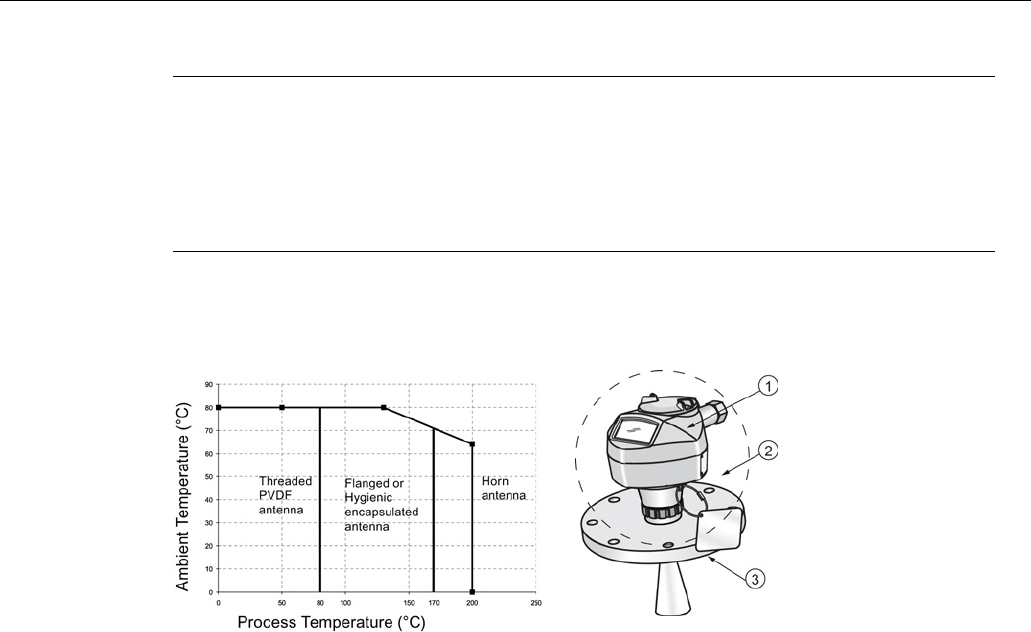
Appendix A: Technical reference
A.4 Maximum Process Temperature Chart
SITRANS LR250 (mA/HART)
266 Operating Instructions, 08/2014, A5E32220602-AC
Note
•
The chart below is for guidance only.
•
The chart does not represent every possible process connection arrangement. For
example, it will NOT apply if you are mounting SITRANS LR250 directly on a metallic
vessel surface.
•
The chart does not take into consideration heating from direct sunlight exposure.
Maximum Process Temperatures versus allowable ambient
①
Internal enclosure temperature
②
Ambient temperature
③
Process temperature (at process
connection)
Where the chart does not apply, please use your own judgement regarding the use of SITRANS
LR250.
If the internal temperature exceeds the maximum allowable limit, a sun shield or a longer nozzle
may be required.
See
Current Internal Temperature (3.2.1.)
to monitor the Internal Temperature.
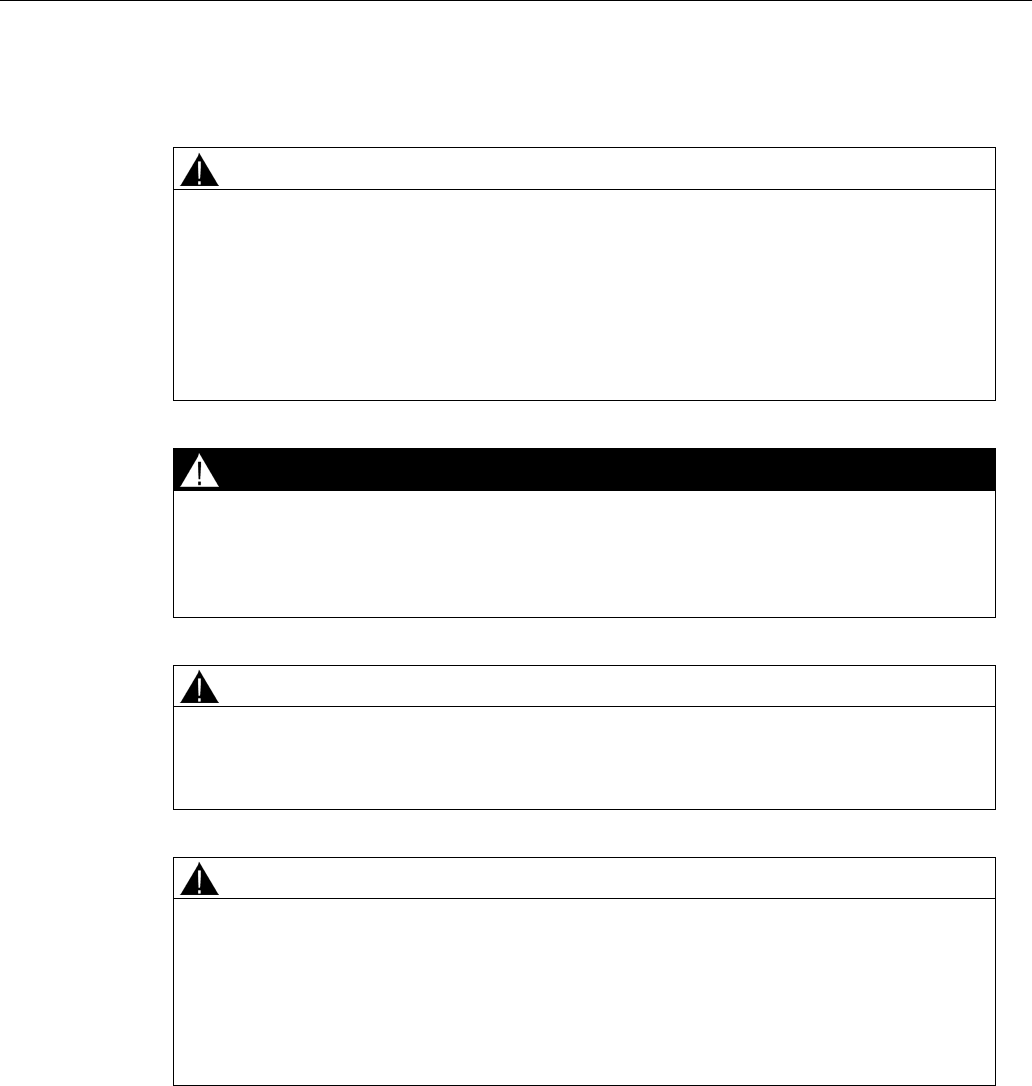
Appendix A: Technical reference
A.5 Process Pressure/Temperature derating curves
SITRANS LR250 (mA/HART)
Operating Instructions, 08/2014, A5E32220602-AC 267
A.5
Process Pressure/Temperature derating curves
WARNING
Exceeded maximum permissible operating pressure
Danger of injury or poisoning.
The maximum permissible operating pressure depends on the device version. The device
can be damaged if the operating pressure is exceeded. Hot, toxic and corrosive process
media could be released.
• Make sure that the device is suitable for the maximum permissible operating pressure of
your system.
DANGER
Pressure applications
Danger to personnel, system and environment will result from improper disassembly.
• Never attempt to loosen, remove, or disassemble process connection while vessel
contents are under pressure.
WARNING
Pressure applications
Danger to personnel, system and environment can result from improper installation.
• Improper installation may result in loss of process pressure.
WARNING
Unsuitable connecting parts
Danger of injury or poisoning.
In case of improper mounting hot, toxic and corrosive process media could be released at
the connections.
• Ensure that connecting parts (such as flange gaskets and bolts) are suitable for
connection and process media.

Appendix A: Technical reference
A.5 Process Pressure/Temperature derating curves
SITRANS LR250 (mA/HART)
268 Operating Instructions, 08/2014, A5E32220602-AC
Note
Material compatibility
Siemens can provide you with support concerning selection of sensor components wetted by
process media. However, you are responsible for the selection of components. Siemens
accepts no liability for faults or failures resulting from incompatible materials.
A.5.1
Pressure Equipment Directive, PED, 97/23/EC
Siemens Level Transmitters with flanged, threaded, or sanitary clamp type process mounts have
no pressure-bearing housing of their own and, therefore, do not come under the Pressure
Equipment Directive as pressure or safety accessories (see EU Commission Guideline 1/8 and
1/20).
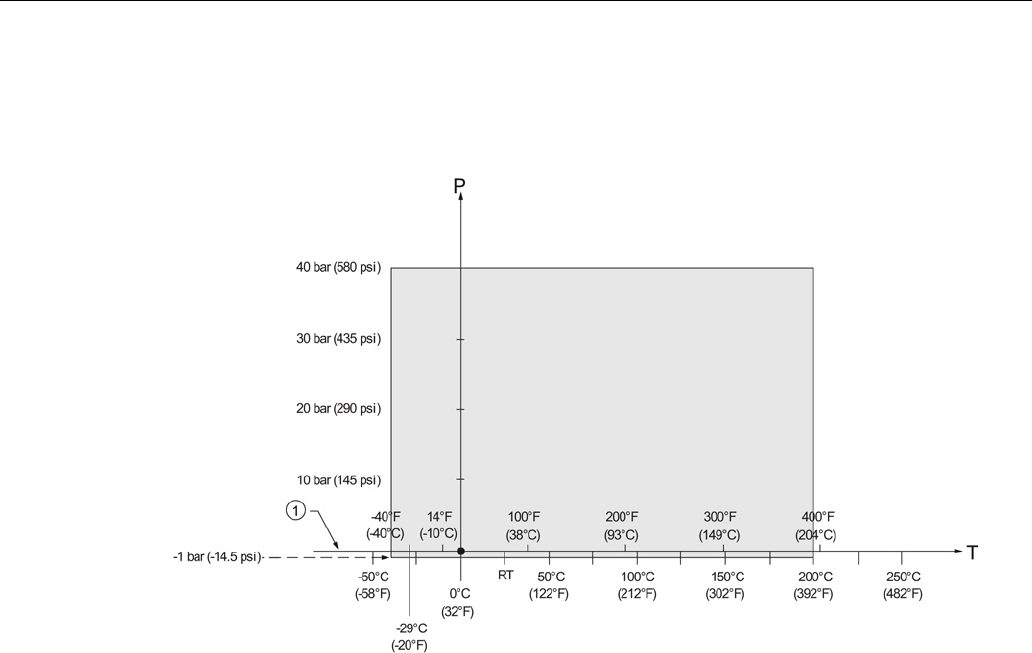
Appendix A: Technical reference
A.5 Process Pressure/Temperature derating curves
SITRANS LR250 (mA/HART)
Operating Instructions, 08/2014, A5E32220602-AC 269
A.5.2
Horn antenna
1.5", 2" and 3" [NPT, G (BSPP), R (BSPT)] Threaded Versions
①
Atmospheric
P
Allowable operating pressures
T
Allowable operating temperatures
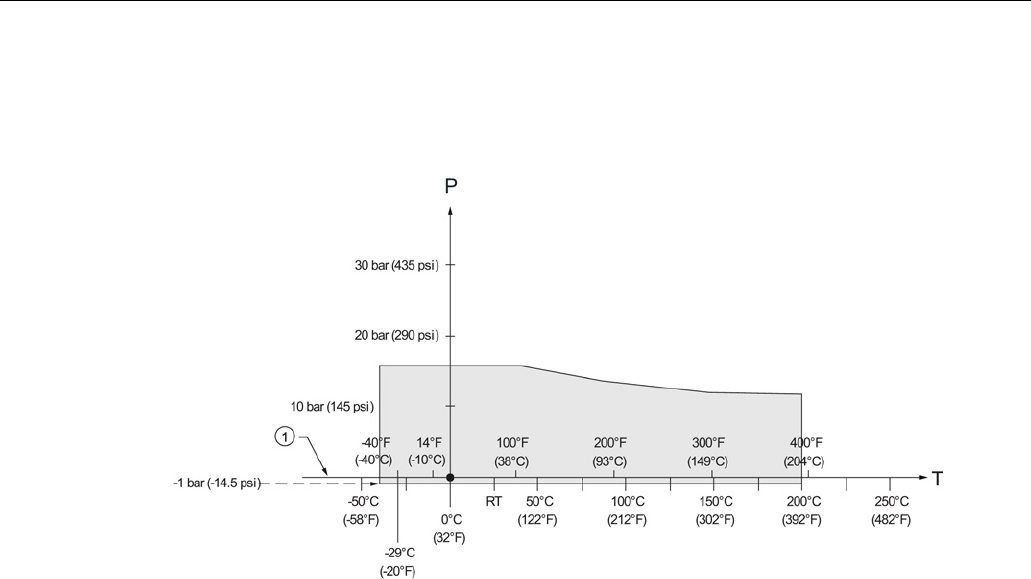
Appendix A: Technical reference
A.5 Process Pressure/Temperature derating curves
SITRANS LR250 (mA/HART)
270 Operating Instructions, 08/2014, A5E32220602-AC
A.5.3
Flanged horn antenna
JIS B 2220, 10K: 50A, 80A, and 100A
①
Atmospheric
P
Allowable operating pressures
T
Allowable operating temperatures
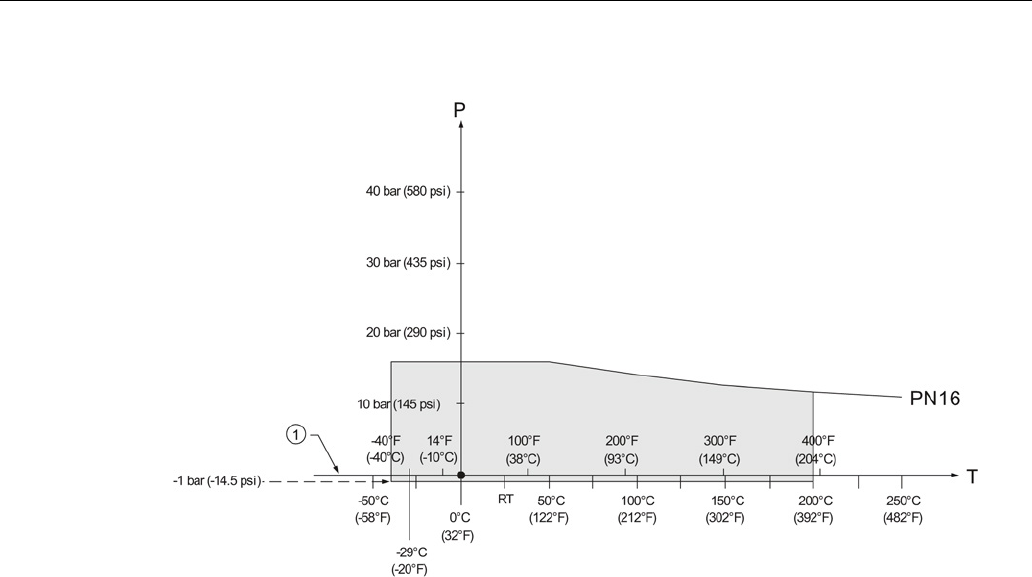
Appendix A: Technical reference
A.5 Process Pressure/Temperature derating curves
SITRANS LR250 (mA/HART)
Operating Instructions, 08/2014, A5E32220602-AC 271
EN1092-1, PN16: DN50, DN80, DN100, and DN150
①
Atmospheric
P
Allowable operating pressures
T
Allowable operating temperatures
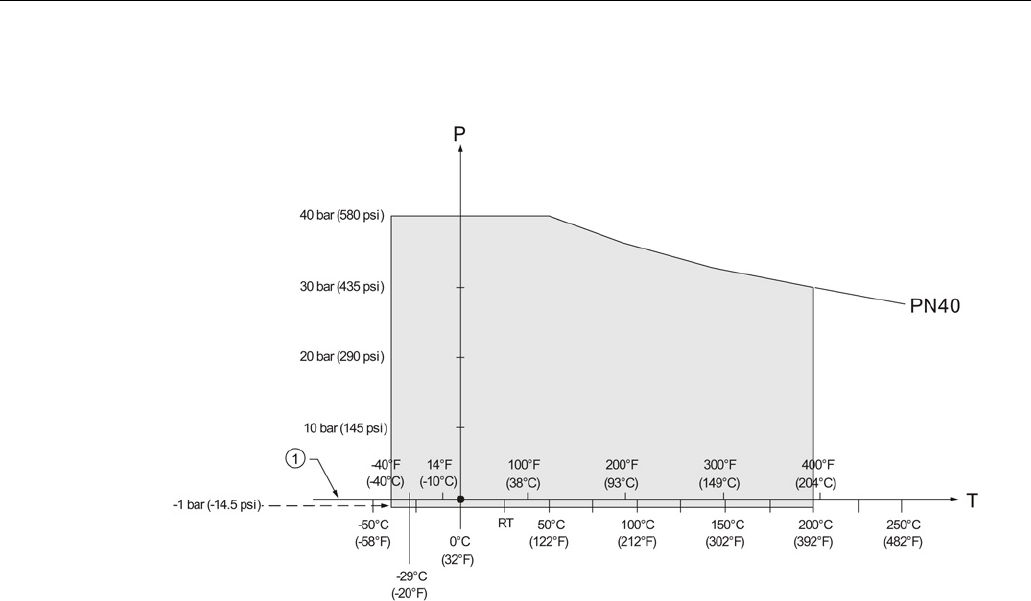
Appendix A: Technical reference
A.5 Process Pressure/Temperature derating curves
SITRANS LR250 (mA/HART)
272 Operating Instructions, 08/2014, A5E32220602-AC
EN1092-1, PN40: DN50, DN80, DN100, and DN150
①
Atmospheric
P
Allowable operating pressures
T
Allowable operating temperatures
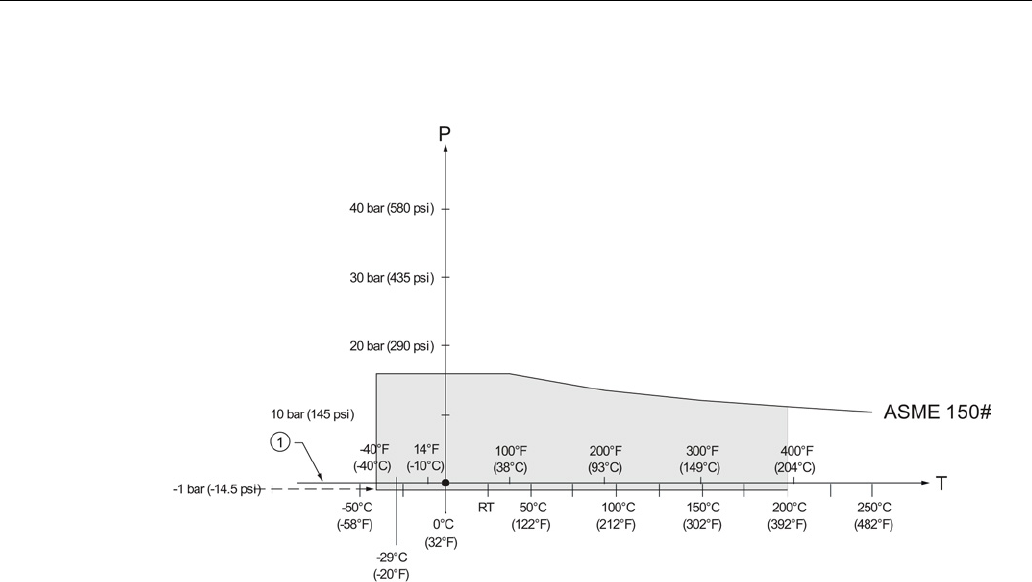
Appendix A: Technical reference
A.5 Process Pressure/Temperature derating curves
SITRANS LR250 (mA/HART)
Operating Instructions, 08/2014, A5E32220602-AC 273
ASME B16.5, Class 150: 2", 3", and 4" NPS
①
Atmospheric
P
Allowable operating pressures
T
Allowable operating temperatures
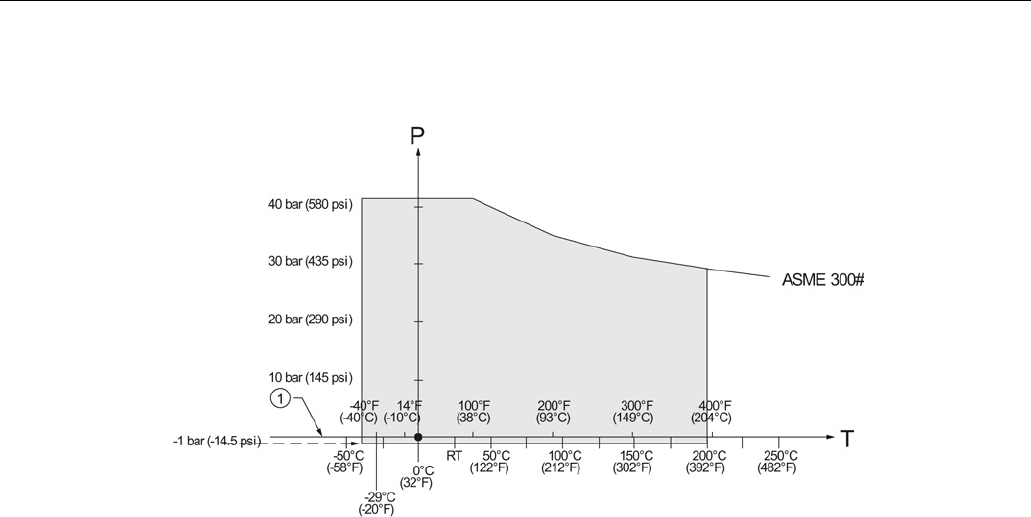
Appendix A: Technical reference
A.5 Process Pressure/Temperature derating curves
SITRANS LR250 (mA/HART)
274 Operating Instructions, 08/2014, A5E32220602-AC
ASME B16.5, Class 300: 2", 3", and 4" NPS
①
Atmospheric
P
Allowable operating pressures
T
Allowable operating temperatures
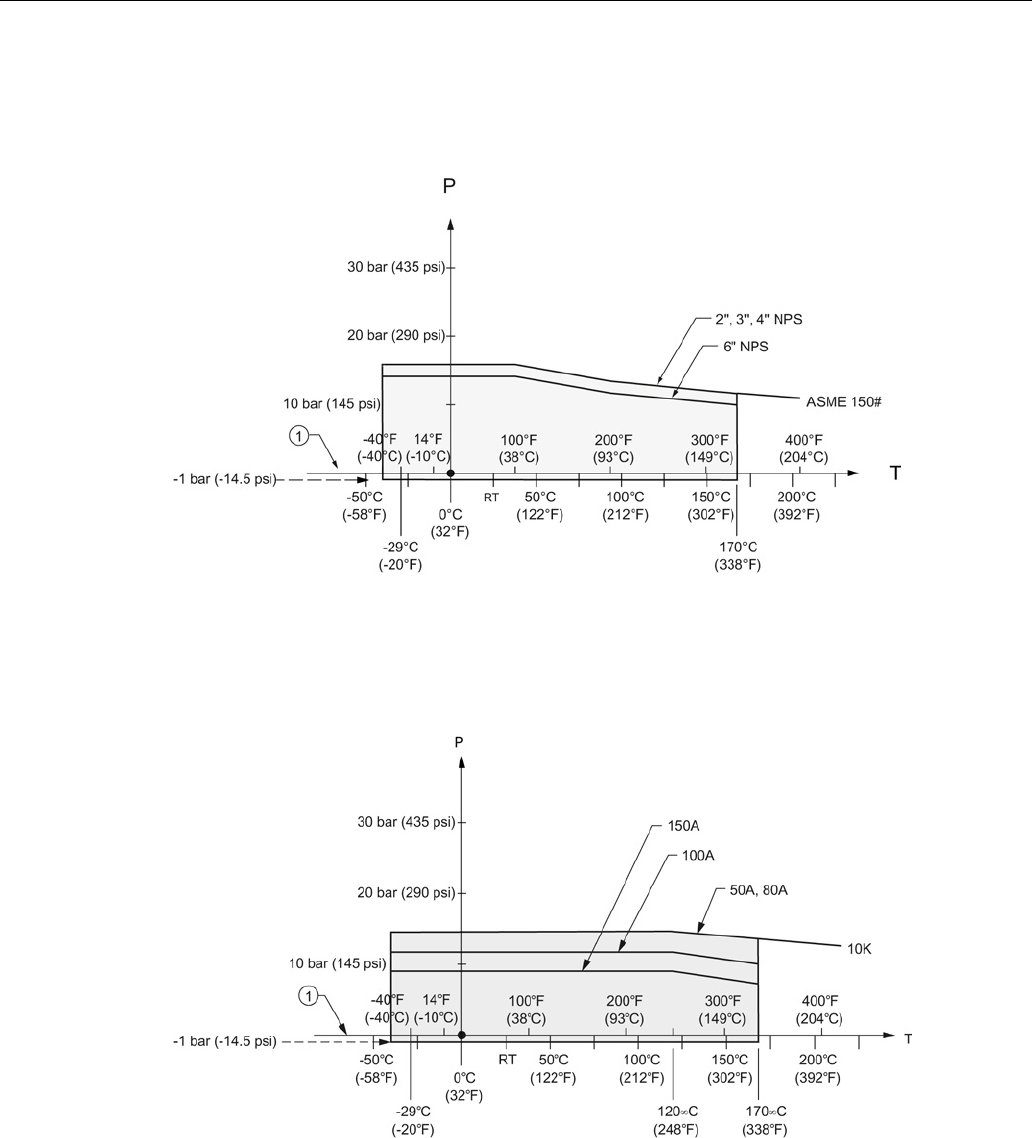
Appendix A: Technical reference
A.5 Process Pressure/Temperature derating curves
SITRANS LR250 (mA/HART)
Operating Instructions, 08/2014, A5E32220602-AC 275
A.5.4
Flanged encapsulated antenna
ASME B16.5, Class 150: 2", 3", 4", and 6" NPS
①
Atmospheric
P
Allowable operating pressures
T
Allowable operating temperatures
JIS B 2220, 10K: 50A, 80A, 100A, and 150A
①
Atmospheric
P
Allowable operating pressures
T
Allowable operating temperatures
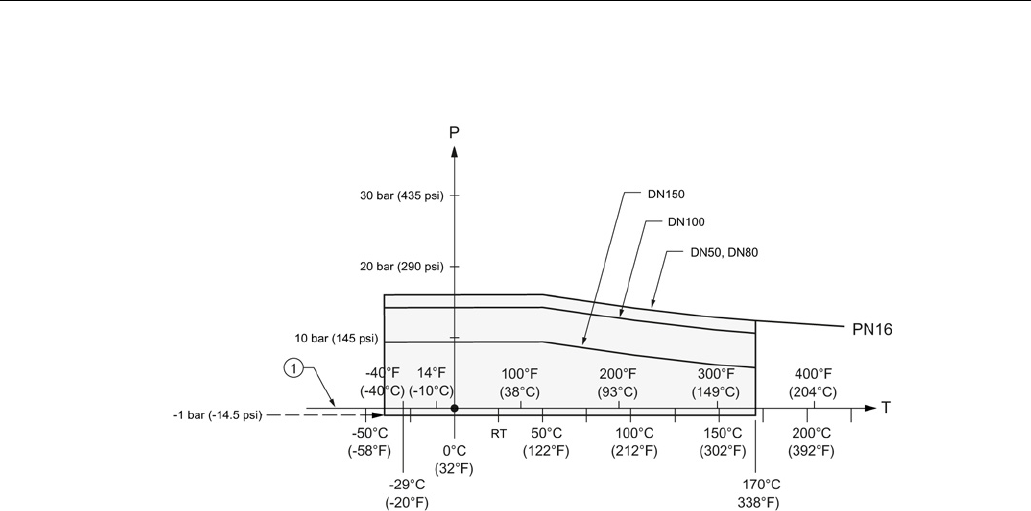
Appendix A: Technical reference
A.5 Process Pressure/Temperature derating curves
SITRANS LR250 (mA/HART)
276 Operating Instructions, 08/2014, A5E32220602-AC
EN1092-1, PN10/16: DN50, DN80, DN100, and DN150
①
Atmospheric
P
Allowable operating pressures
T
Allowable operating temperatures
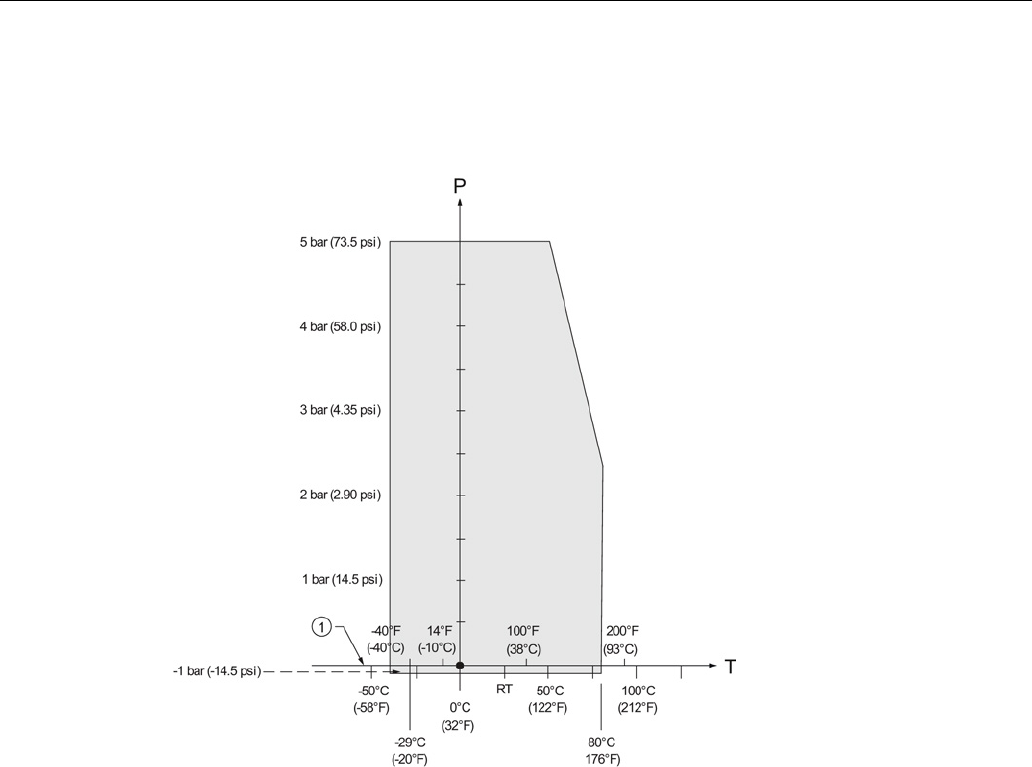
Appendix A: Technical reference
A.5 Process Pressure/Temperature derating curves
SITRANS LR250 (mA/HART)
Operating Instructions, 08/2014, A5E32220602-AC 277
A.5.5
PVDF antenna
ASME B1.20.1 2" NPT, EN ISO 228-1 2" G (BSPP), EN 10226-1 2" R (BSPT)
①
Atmospheric
P
Allowable operating pressures
T
Allowable operating temperatures
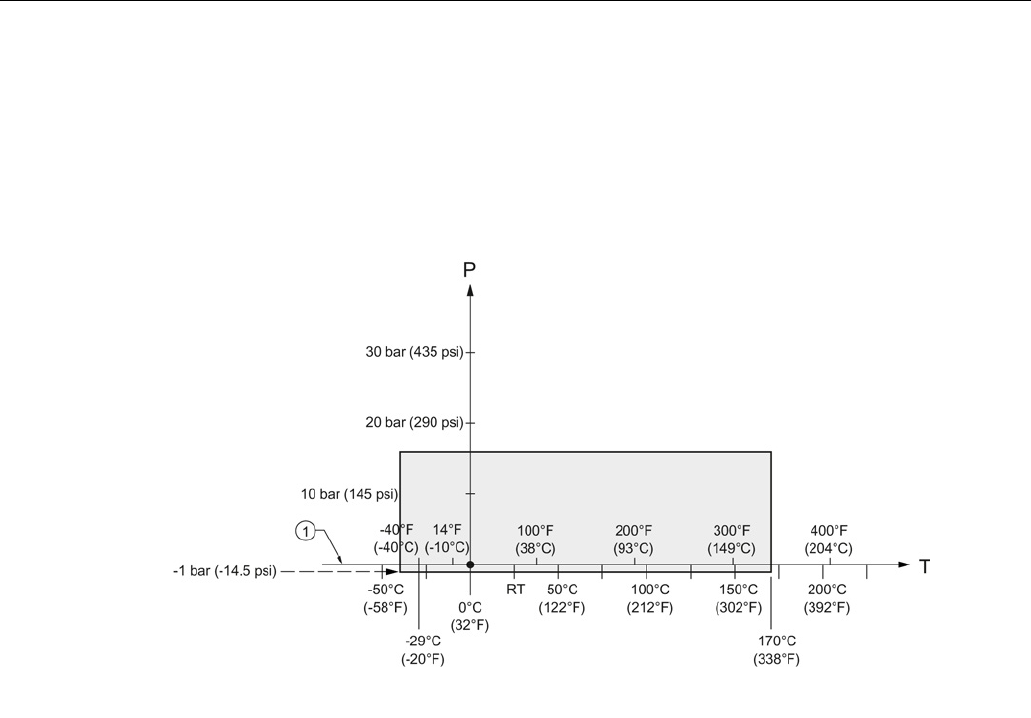
Appendix A: Technical reference
A.5 Process Pressure/Temperature derating curves
SITRANS LR250 (mA/HART)
278 Operating Instructions, 08/2014, A5E32220602-AC
A.5.6
Hygienic encapsulated antenna
DIN 11851 Sanitary/Hygienic nozzle/slotted nut: DN50, DN80, and DN100
DIN 11864-1 Aseptic/Hygienic nozzle/slotted nut: DN50, DN80, and DN100
①
Atmospheric
P
Allowable operating pressures
T
Allowable operating temperatures
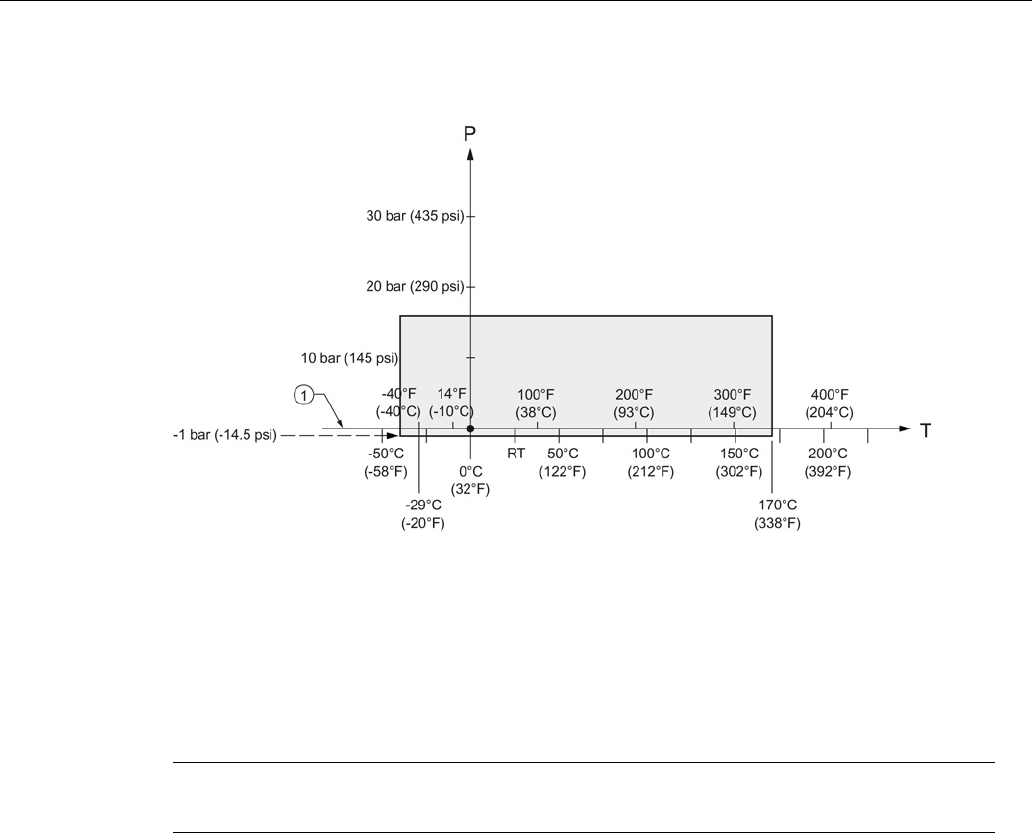
Appendix A: Technical reference
A.5 Process Pressure/Temperature derating curves
SITRANS LR250 (mA/HART)
Operating Instructions, 08/2014, A5E32220602-AC 279
DIN 11864-2 Aseptic/Hygienic flanged: DN50, DN80, and DN100
①
Atmospheric
P
Allowable operating pressures
T
Allowable operating temperatures
Note
For pressure applications, all attachment hardware must be suitably rated.
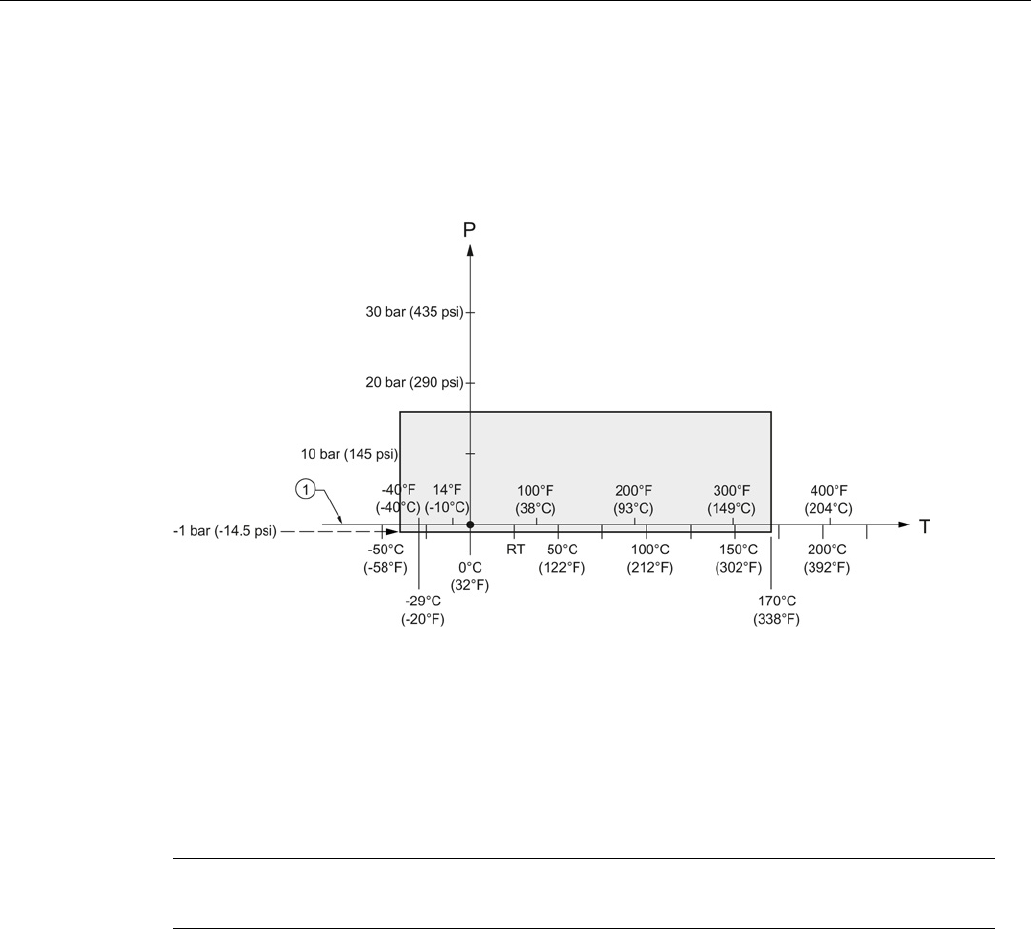
Appendix A: Technical reference
A.5 Process Pressure/Temperature derating curves
SITRANS LR250 (mA/HART)
280 Operating Instructions, 08/2014, A5E32220602-AC
DIN 11864-3 Aseptic/Hygienic clamp: DN50, DN80, and DN100
IS0 2852 Sanitary/Hygienic clamp: 2", 3", and 4"
Tuchenhagen Varivent face seal clamp: Type N (68 mm) and Type F (50 mm)
①
Atmospheric
P
Allowable operating pressures
T
Allowable operating temperatures
Note
For pressure applications, all clamps must be rated accordingly.
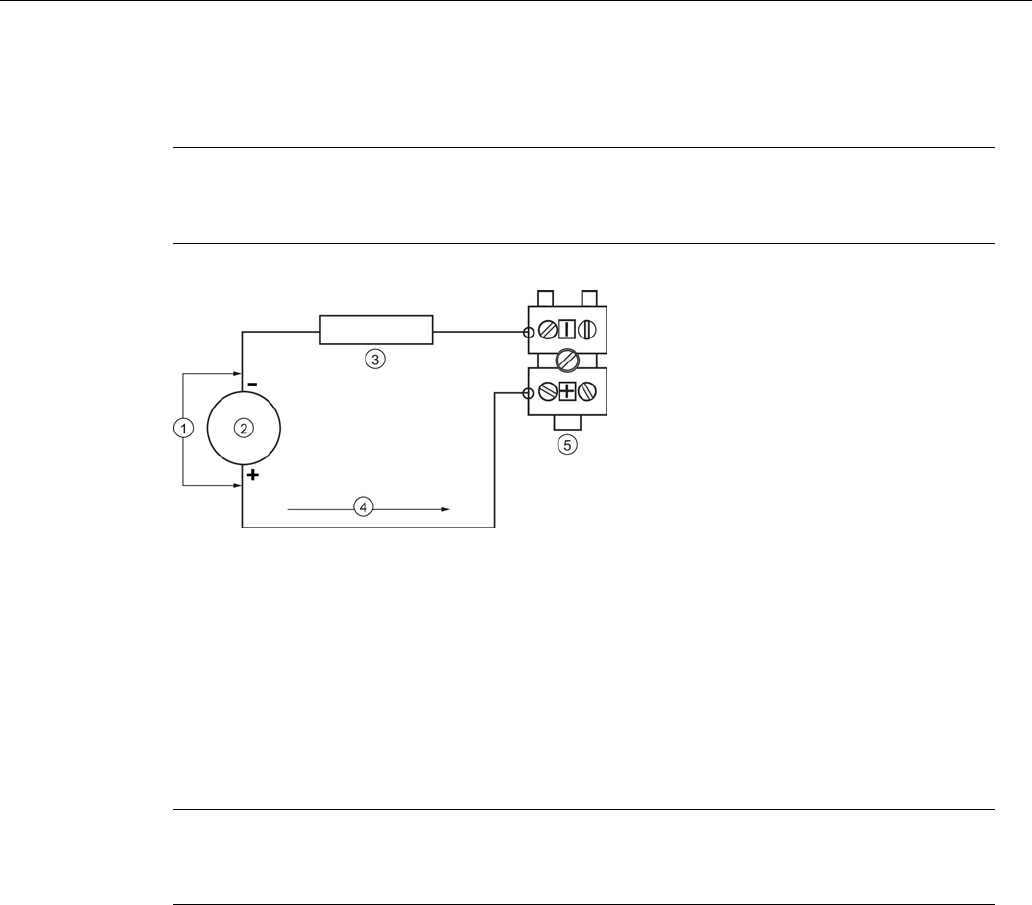
Appendix A: Technical reference
A.6 Loop power
SITRANS LR250 (mA/HART)
Operating Instructions, 08/2014, A5E32220602-AC 281
A.6
Loop power
Note
Loop voltage is the voltage at the terminals of the power supply (not the vo
ltage at the
terminals of the device).
①
Loop voltage VL
②
Power supply
③
Loop resistance RL
④
Loop current IL
⑤
LR250
A.6.1
Allowable operating area of SITRANS LR250
Note
The curves below apply to a standalone device, configured via the Siemens handheld
programmer.

Appendix A: Technical reference
A.6 Loop power
SITRANS LR250 (mA/HART)
282 Operating Instructions, 08/2014, A5E32220602-AC
A.6.2
Curve 1 (General Purpose, Intrinsically Safe, Non-Sparking, Non-incendive)
Loop Voltage versus Loop Resistance
Note
When using HART communications, the minimum voltage with 220 Ohms (RL) is 16.3 V DC.
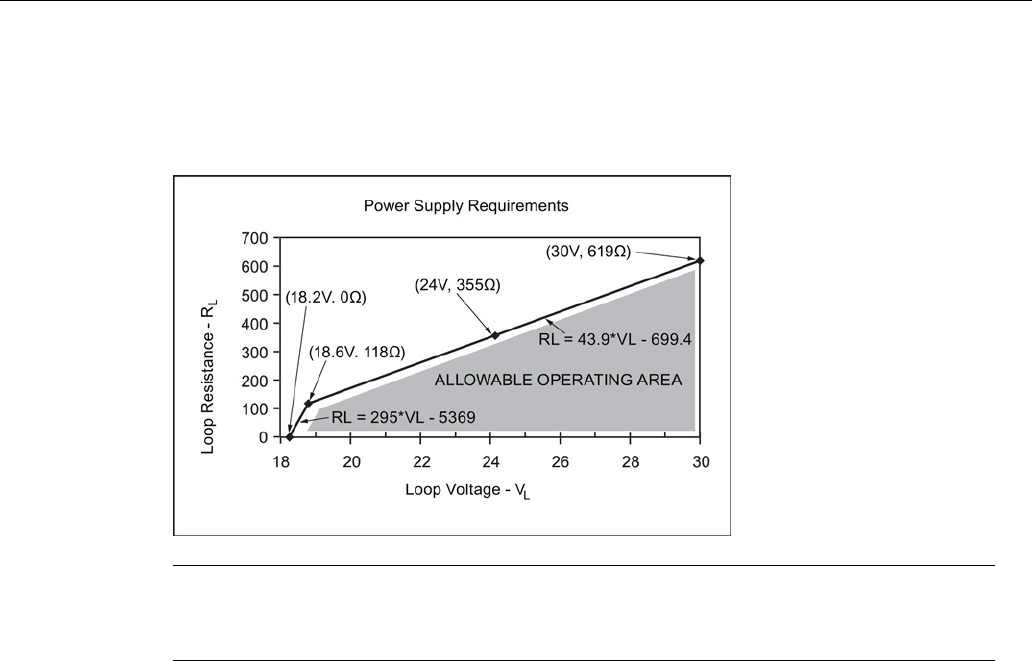
Appendix A: Technical reference
A.7 Startup behavior
SITRANS LR250 (mA/HART)
Operating Instructions, 08/2014, A5E32220602-AC 283
A.6.3
Curve 2 (Flameproof, Increased Safety, Explosion-proof)
Loop Voltage versus Loop Resistance
Note
When using HART
communications, the minimum voltage with 220 Ohms (RL) is 20.94 V
DC.
A.7
Startup behavior
● The device draws less than 3.6 mA at startup.
● Time to first measurement is less than 50 seconds.

Appendix A: Technical reference
A.7 Startup behavior
SITRANS LR250 (mA/HART)
284 Operating Instructions, 08/2014, A5E32220602-AC

SITRANS LR250 (mA/HART)
Operating Instructions, 08/2014, A5E32220602-AC 285
Appendix B: HART communications
B
Highway Addressable Remote Transducer, HART, is an industrial protocol that is superimposed
on the 4-20 mA signal. It is an open standard, and full details about HART can be obtained from
the HART Communication Foundation website:
HART Communication Foundation (http://www.hartcomm.org/)
The radar device can be configured over the HART network using either the HART
Communicator 375 by Fisher-Rosemount, or a software package. The recommended software
package is the SIMATIC Process Device Manager (PDM) by Siemens.
B.1
SIMATIC PDM
This software package is designed to permit easy configuration, monitoring, and troubleshooting
of HART devices. The HART EDD for this device was written with SIMATIC PDM in mind and
has been extensively tested with this software. For more information, see Operating via
SIMATIC PDM (Page 77).
B.2
HART Electronic Device Description (EDD)
In order to configure a HART device, the configuration software requires the HART Electronic
Device Description for the instrument in question.
You can download the HART EDD for this device from our website:
Product page (http://www.siemens.com/LR250)
Click on
Support>Software Downloads.
Older versions of the library will have to be updated in
order to use all the features of this device.
B.3
HART Handheld 375/475
If the SITRANS LR250 HART device revision is higher than revision 2, the FC375 will report that
the Device Description is not installed and will ask whether you wish to proceed in forward
compatibility mode. It is recommended to choose YES in order to use revision 3 with the FC375.
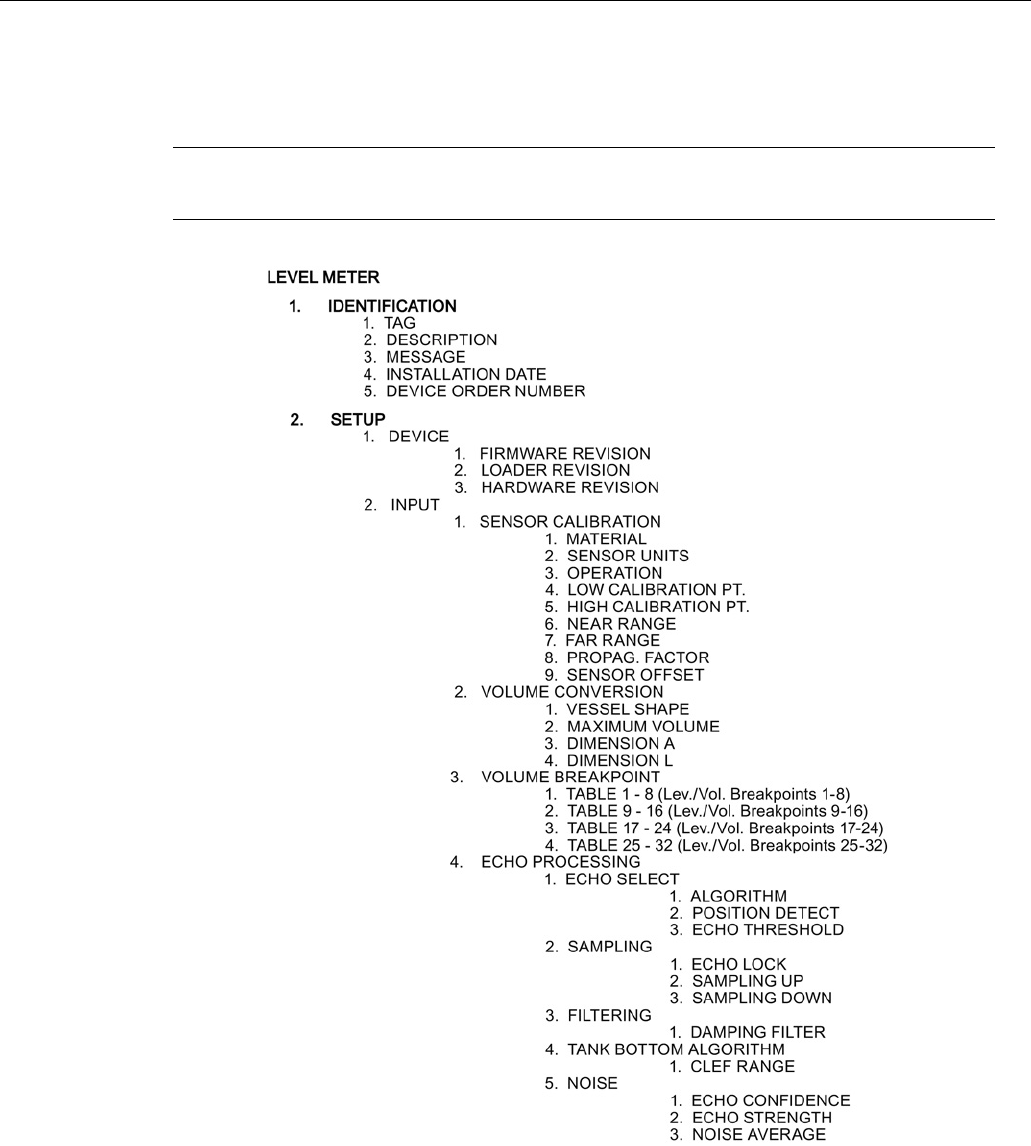
Appendix B: HART communications
B.4 HART Communicator 375 menu structure
SITRANS LR250 (mA/HART)
286 Operating Instructions, 08/2014, A5E32220602-AC
B.4
HART Communicator 375 menu structure
Note
HART Communicator 375 is supported by SITRANS LR250 HART.
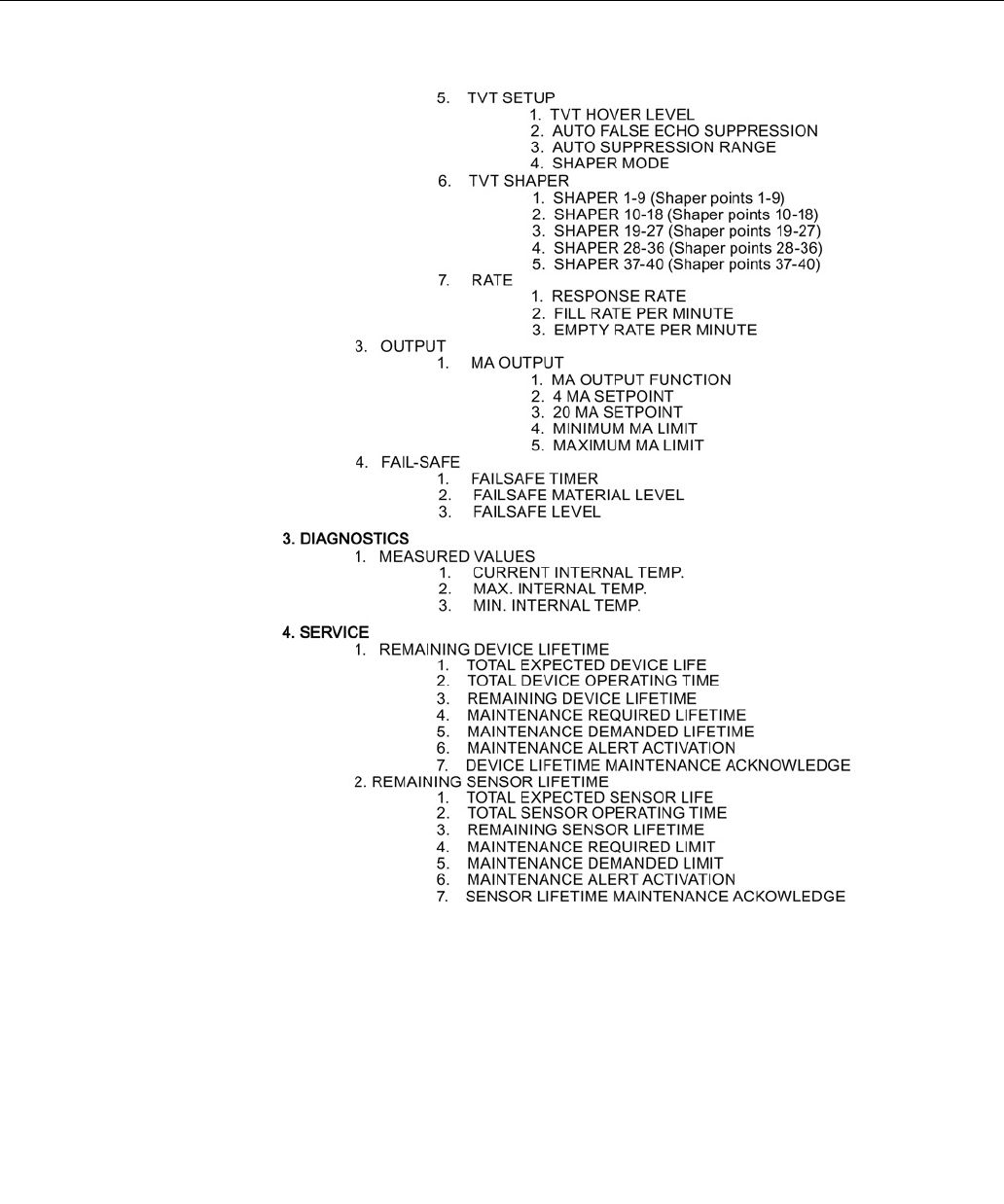
Appendix B: HART communications
B.4 HART Communicator 375 menu structure
SITRANS LR250 (mA/HART)
Operating Instructions, 08/2014, A5E32220602-AC 287
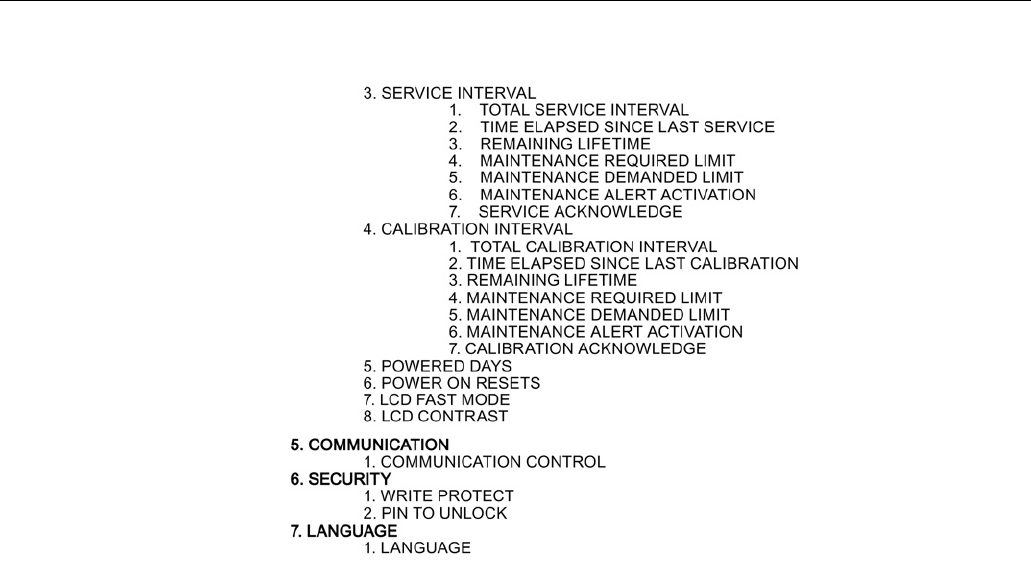
Appendix B: HART communications
B.5 HART version
SITRANS LR250 (mA/HART)
288 Operating Instructions, 08/2014, A5E32220602-AC
B.5
HART version
SITRANS LR250 conforms to HART rev. 5.
B.5.1
Burst Mode
SITRANS LR250 does not support burst mode.
B.5.2
HART Multidrop Mode
We do not recommend the use of HART Multidrop Mode.

SITRANS LR250 (mA/HART)
Operating Instructions, 08/2014, A5E32220602-AC 289
Appendix C: Certificates and support
C
C.1
Certificates
Certificates can be downloaded from our website at:
Product page (http://www.siemens.com/LR250).
C.2
Technical support
If you have any technical questions about the device described in these Operating Instructions
and do not find the right answers, you can contact Customer Support:
● Via the Internet using the
Support Request:
Support request (http://www.siemens.com/automation/support-request)
● Via Phone:
– Europe: +49 (0)911 895 7222
– America: +1 423 262 5710
– Asia-Pacific: +86 10 6475 7575
Further information about our technical support is available on the Internet at
Technical support (http://support.automation.siemens.com/WW/view/en/16604318)
Service & Support on the Internet
In addition to our documentation, we offer a comprehensive knowledge base online on the
Internet at:
Service & Support (http://www.siemens.com/automation/service&support)
There you will find:
● The latest product information, FAQs, downloads, tips and tricks.
● Our newsletter, providing you with the latest information about your products.
● Our bulletin board, where users and specialists share their knowledge worldwide.
● You can find your local contact partner for Industry Automation and Drives Technologies in
our partner database.
● Information about field service, repairs, spare parts and lots more under "Services."

Appendix C: Certificates and support
C.2 Technical support
SITRANS LR250 (mA/HART)
290 Operating Instructions, 08/2014, A5E32220602-AC
Additional Support
Please contact your local Siemens representative and offices if you have additional questions
about the device
Find your contact partner at:
Local contact person (http://www.siemens.com/automation/partner)

SITRANS LR250 (mA/HART)
Operating Instructions, 08/2014, A5E32220602-AC 291
List of abbreviations
13
Short form
Long form
Description
Units
3-A
3-A Sanitary Standards, Inc.
CE / FM / CSA Conformité Européene / Factory Mutual
/ Canadian Standards Association
safety approval
Ci
Internal capacitance
F
D/A
Dialog to analog
DCS
Distributed Control System
control room apparatus
dK
dielectric constant
EDD
Electronic Device Description
EHEDG European Hygienic Engineering Design
Group
FEA
Flanged encapsulated antenna
FDA
Food and Drug Administration
HEA
Hygienic Encapsulated Antenna
HART Highway Addressable Remote
Transducer
I
i
Input current
mA
Io Output current mA
IS
Intrinsically Safe
safety approval
Li
Internal inductance
mH
mH
milliHenry
10
-3
H
μF
microFarad
10
-6
F
μs
microsecond
10
-6
s
NPS
Nominal Pipe Size
PED
Pressure Equipment Directive
safety approval
pF
pico Farads
10
-12
F
ppm
parts per million
PV
Primary Variable
measured value
PVDF
Polyvinylidene fluoride
SV
Secondary Variable
equivalent value
TB
Transducer Block
TVT
Time Varying Threshold
sensitivity threshold
TFM1600 PTFE Modified PTFE polytetrafluoroethylene
with perfluoropropyl
vinyl ether (PPVE)
modifier
U
i
Input voltage
V
Uo Output voltage V

List of abbreviations
SITRANS LR250 (mA/HART)
292 Operating Instructions, 08/2014, A5E32220602-AC

SITRANS LR250 (mA/HART)
Operating Instructions, 08/2014, A5E32220602-AC 293
LCD menu structure
14
14.1
LCD menu structure
Note
•
In Navigation mode,
ARROW keys (
)
navigate the menu in the direction of
the arrow. See Parameter Reference (Page 127) for detailed information and
instructions.
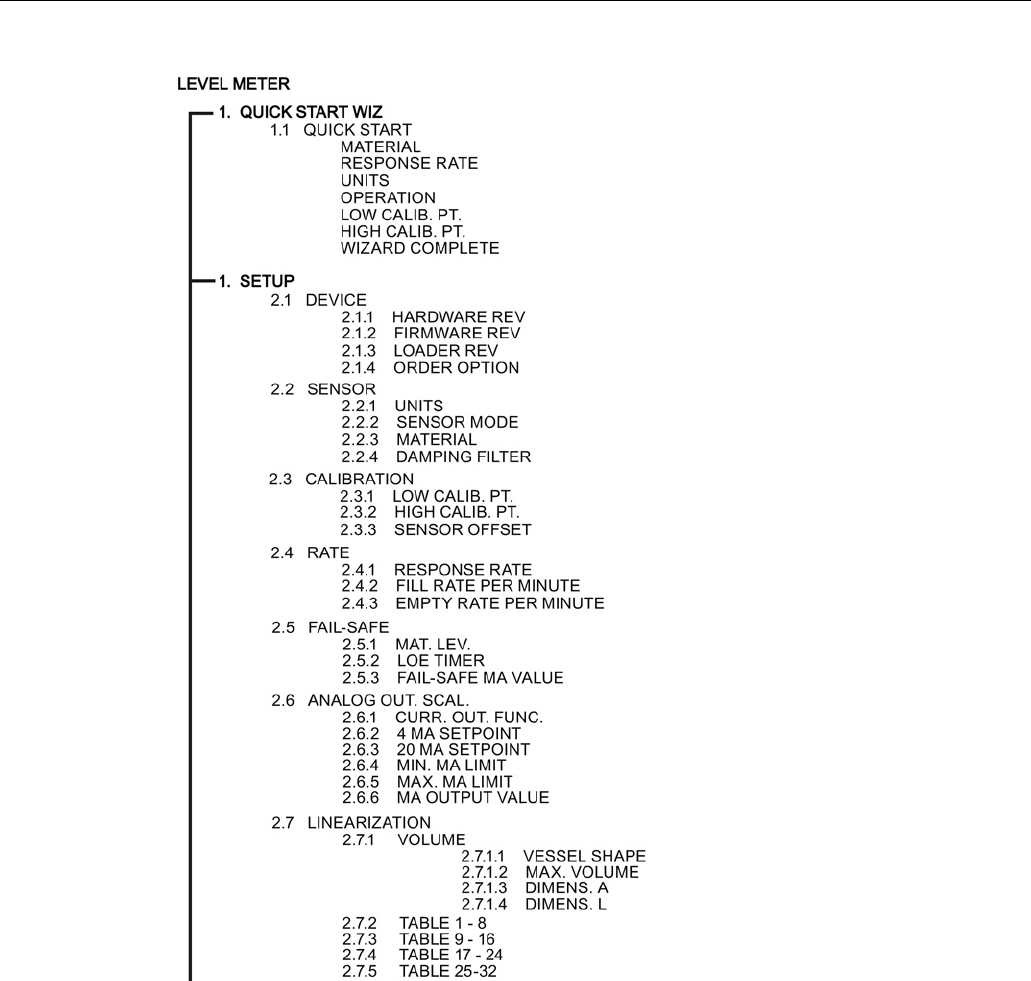
LCD menu structure
14.1 LCD menu structure
SITRANS LR250 (mA/HART)
294 Operating Instructions, 08/2014, A5E32220602-AC
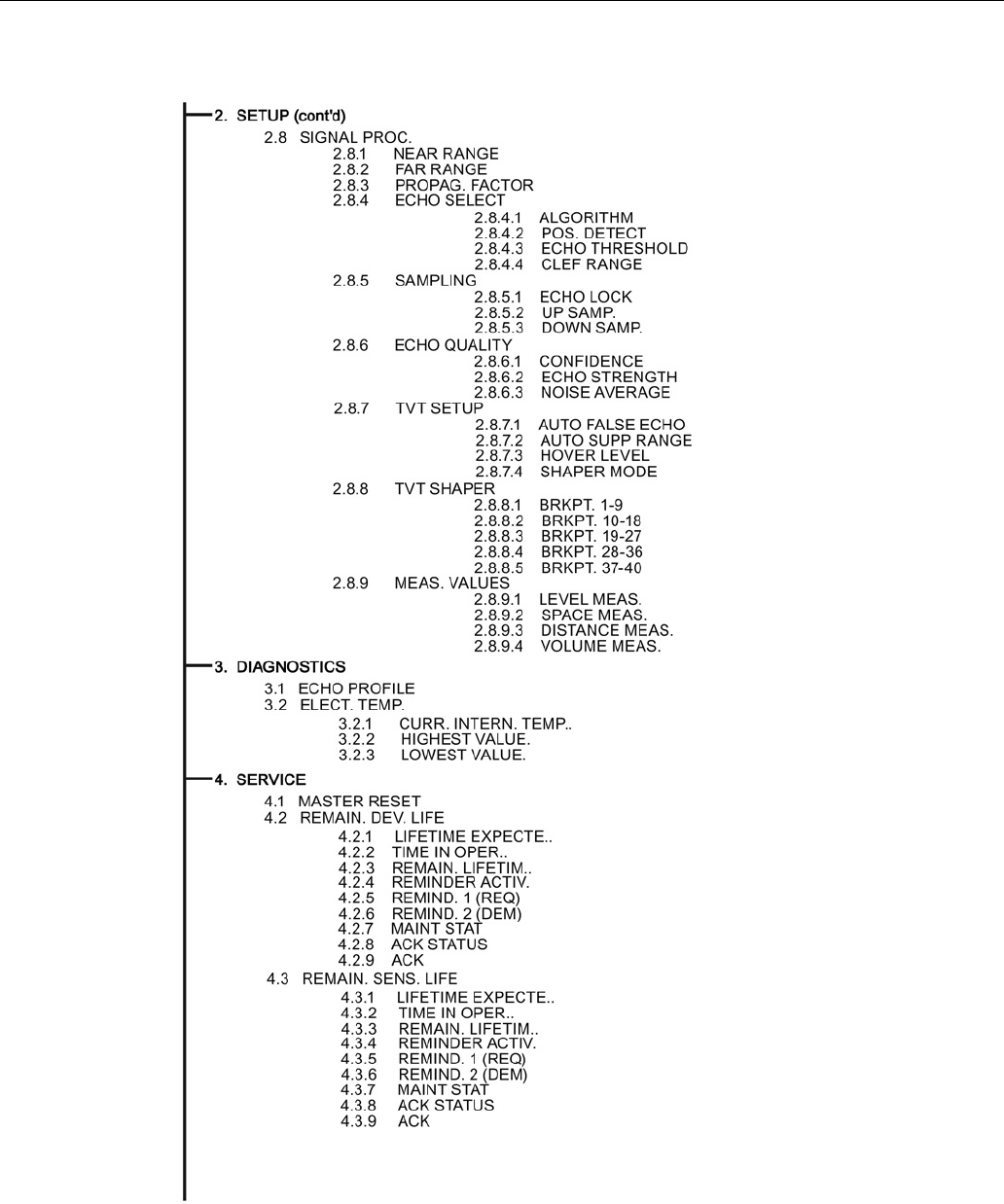
LCD menu structure
14.1 LCD menu structure
SITRANS LR250 (mA/HART)
Operating Instructions, 08/2014, A5E32220602-AC 295
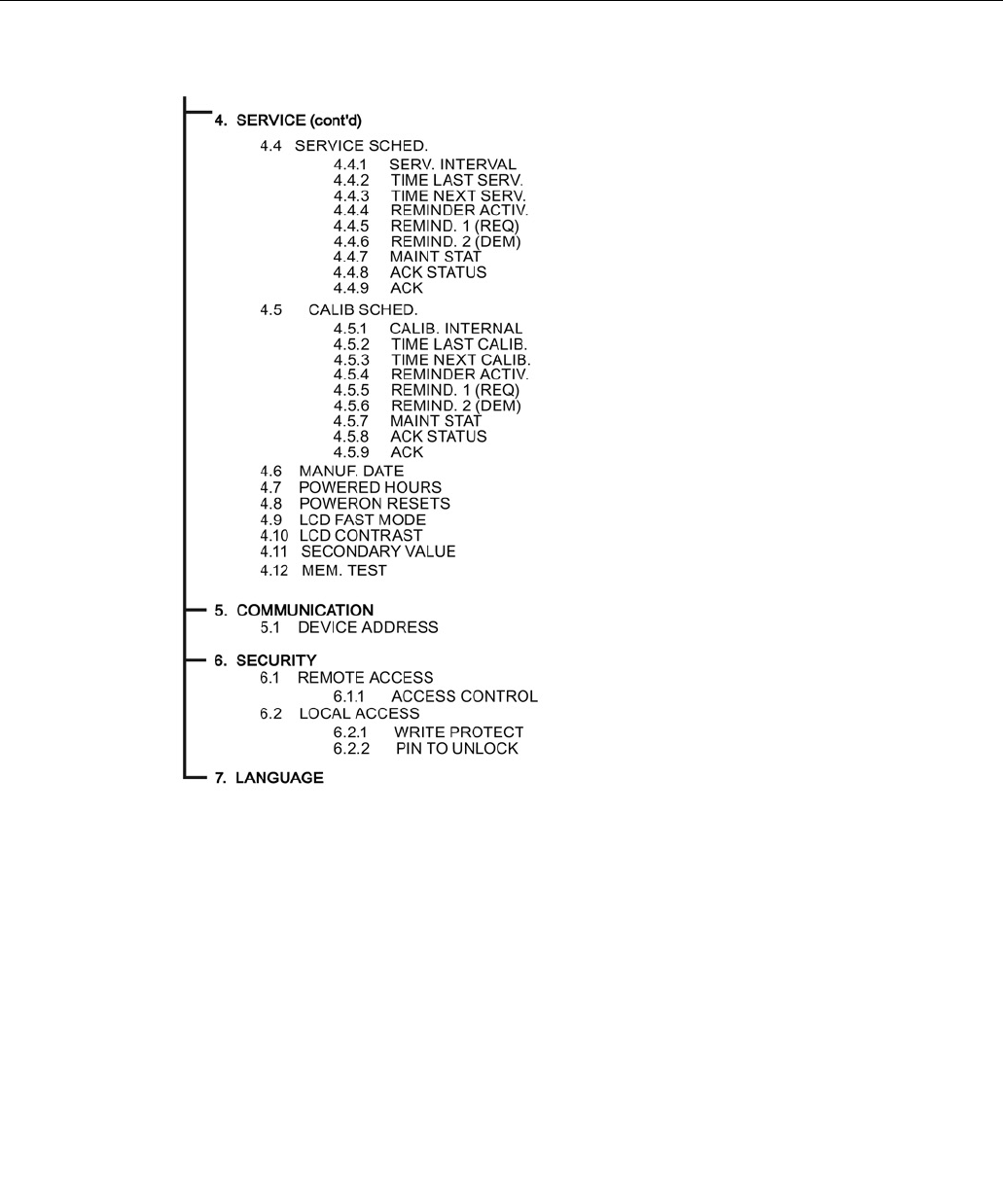
LCD menu structure
14.1 LCD menu structure
SITRANS LR250 (mA/HART)
296 Operating Instructions, 08/2014, A5E32220602-AC
SITRANS LR250 (mA/HART)
Operating Instructions, 08/2014, A5E32220602-AC 297
Glossary
accuracy
degree of conformity of a measure to a standard or a true value.
algorithm
a prescribed set of well-defined rules or processes for the solution of a problem in a finite
number of steps.
ambient temperature
the temperature of the surrounding air that comes in contact with the enclosure of the device.
antenna
an aerial which sends out and receives a signal in a specific direction. There are four basic types
of antenna in radar level measurement, horn, parabolic, rod, and waveguide.
attenuation
a term used to denote a decrease in signal magnitude in transmission from one point to another.
Attenuation may be expressed as a scalar ratio of the input magnitude to the output magnitude
or in decibels.
Auto False-Echo Suppression
a technique used to adjust the level of a TVT to avoid the reading of false echoes. (See TVT.)
Auto-False Echo Suppression Distance
defines the endpoint of the TVT distance. (See TVT.) This is used in conjunction with auto false
echo suppression.
beam spreading
the divergence of a beam as it travels through a medium.

Glossary
SITRANS LR250 (mA/HART)
298 Operating Instructions, 08/2014, A5E32220602-AC
beam width
the angle diametrically subtended by the one-half power limits (-3 dB) of the microwave beam.
blanking
a blind zone extending away from the reference point plus any additional shield length.The
device is programmed to ignore this zone.
capacitance
the property of a system of conductors and dielectrics that permits the storage of electricity when
potential differences exist between the conductors. Its value is expressed as the ratio of a
quantity of electricity to a potential difference, and the unit is a Farad.
confidence
see Echo Confidence.
damping
term applied to the performance of a device to denote the manner in which the measurement
settles to its steady indication after a change in the value of the level.
dB (decibel)
a unit used to measure the amplitude of signals.
derating
to decrease a rating suitable for normal conditions according to guidelines specified for different
conditions.
dielectric
a nonconductor of direct electric current. Many conductive liquids/electrolytes exhibit dielectric
properties; the relative dielectric constant of water is 80.
dielectric constant (dK)
the ability of a dielectric to store electrical potential energy under the influence of an electric field.
Also known as Relative Permittivity. An increase in the
dielectric constant is directly proportional to an increase in signal amplitude. The value is usually
given relative to a vacuum /dry air: the dielectric constant of air is 1.

Glossary
SITRANS LR250 (mA/HART)
Operating Instructions, 08/2014, A5E32220602-AC 299
echo
a signal that has been reflected with sufficient magnitude and delay to be perceived in some
manner as a signal distinct from that directly transmitted. Echoes are frequently measured in
decibels relative to the directly transmitted signal.
Echo Confidence
describes the quality of an echo. Higher values represent higher quality. Echo Threshold defines
the minimum value required for an echo to be accepted as valid and evaluated.
Echo Lock Window
a window centered on an echo in order to locate and display the echo’s position and true
reading. Echoes outside the window are not immediately processed.
Echo Marker
a marker that points to the processed echo.
Echo Processing
the process by which the radar unit determines echoes.
Echo Profile
a graphical display of a processed echo.
Echo Strength
describes the strength of the selected echo in dB referred to 1 μV rms.
false Echo
any echo which is not the echo from the desired target. Generally, false echoes are created by
vessel obstructions.
frequency
the number of periods occurring per unit time. Frequency may be stated in cycles per second.

Glossary
SITRANS LR250 (mA/HART)
300 Operating Instructions, 08/2014, A5E32220602-AC
HART
H
ighway
A
ddressable
R
emote
T
ransducer. An open communication protocol used to address
field instruments.
Hertz (Hz):
unit of frequency, one cycle per second. 1 Gigahertz (GHz) is equal to 109 Hz.
horn antenna
a conical, horn-shaped antenna which focuses microwave signals. The larger the horn diameter,
the more focused the radar beam.
inductance
the property of an electric circuit by virtue of which a varying current induces an electromotive
force in that circuit or in a neighboring circuit. The unit is a Henry.
microwaves
the term for the electromagnetic frequencies occupying the portion of the radio frequency
spectrum from 1 GHz to 300 GHz.
multiple echoes
secondary echoes that appear as double, triple, or quadruple echoes in the distance from the
target echo.
Near Blanking
see Blanking.
nozzle
a length of pipe mounted onto a vessel that supports the flange.
parameters
in programming, variables that are given constant values for specific purposes or processes.

Glossary
SITRANS LR250 (mA/HART)
Operating Instructions, 08/2014, A5E32220602-AC 301
polarization
the property of a radiated electromagnetic wave describing the time-varying direction and
amplitude of the electric field vector.
polarization error
the error arising from the transmission or reception of an electromagnetic wave having a
polarization other than that intended for the system.
propagation factor (pf)
where the maximum velocity is 1.0, pf is a value that represents a reduction in propagation
velocity as a result of the wave travelling through a pipe or
medium.
pulse radar
a radar type that directly measures distance using short microwave pulses. Distance is
determined by the return transit time.
radar
radar is an acronym for
RA
dio
D
etection
A
nd
R
anging. A device that radiates electromagnetic
waves and utilizes the reflection of such waves from distant objects to determine their existence
or position.
range
distance between a transmitter and a target.
range extension
the distance below the zero percent or empty point in a vessel.
relative humidity
the ratio of the actual amount of moisture in the atmosphere to the maximum amount of moisture
the atmosphere could hold (which varies depending on the air temperature).
relative permittivity
see dielectric constant.

Glossary
SITRANS LR250 (mA/HART)
302 Operating Instructions, 08/2014, A5E32220602-AC
repeatability
the closeness of agreement among repeated measurements of the same variable under the
same conditions.
sensor value
the value produced by the echo processing which represents the distance from sensor reference
point to the target. (see
Sensor Mode (2.2.2.)
for an illustration).
shot
one transmit pulse or measurement.
speed of light
the speed of electromagnetic waves (including microwave and light) in free space. Light speed is
a constant 299, 792, 458 meters per second.
stilling-well
see stillpipe.
stillpipe
a pipe that is mounted inside a vessel parallel to the vessel wall, and is open to the vessel at the
bottom.
TVT (Time Varying Threshold)
a time-varying curve that determines the threshold level above which echoes are determined to
be valid.
two wire radar
a low-energy radar. Can be loop powered, analog, intrinsically safe 4 to 20 mA, or a digital
(BUS) transmitter.
waveguide antenna
a hollow, metallic tube that transmits a microwave signal to the product target.
SITRANS LR250 (mA/HART)
Operating Instructions, 08/2014, A5E32220602-AC 303
Index
A
Abbreviations and identifications list, 291
access control
remote access, 177
activating, 54
agitator blade detection
avoiding, 149
AMS Device Manager
features, 104
analog output
explanation, 262
fail signal, 201
select, 97
signal range, 201
simulate via PDM, 97
analog output scale
setup, 136
antenna
replacement, 185
antenna types
flanged encapsulated antenna, 219, 221
flanged horn antenna, 215
flanged horn antenna with extension, 217
threaded horn, 209
threaded PVDF antenna, 240
Auto False Echo Suppression
explanation, 259
setup, 151
TVT Shaper adjustment, 91
via PDM, 89, 92
B
beam angle
flanged encapsulated antenna, 219, 221
flanged horn, 215, 217
threaded horn, 211
threaded PVDF antenna, 240
blanking (see Near Range), 261
bolting instructions, 37
bypass pipe
see stillpipe, 32
C
cables
requirements, 42
Calibration Interval, 172
calibration schedules via PDM, 95
cleaning
instructions, 183
CLEF (Constrained Leading Edge Fit)
explanation, 256
CLEF range
setup, 148
communication
load, 201
maximum line length, 201
conduits
requirements, 42
configuration
new device via AMS, 104
Quick Start via LUI, 64
configuration flag reset, 97
Correct usage (see Improper device modifications)
D
Damping
explanation, 262
Damping filter
setup, 131
data logging
time-based echo profile storage, 90
Device Address, 176
Device Description (DD)
see EDD, 80
Device Reset
see Master Reset, 158
device status
view via PDM, 101
Diagnostics, 156

Index
SITRANS LR250 (mA/HART)
304 Operating Instructions, 08/2014, A5E32220602-AC
dimensions
flanged encapsulated antenna, 219, 221
flanged horn, 215, 217
flat face flange, 247
raised face flange, 242, 244
threaded horn with extension, 211
threaded PVDF antenna, 240
E
echo confidence
parameter setup, 150
echo processing
Process Intelligence, 254
Echo Profile
data logging, 90
view via LUI, 69
view via PDM, 89
Echo Profile Utilities
Auto False Echo Suppression, 88
Echo Profile, 88
TVT Shaper, 88
echo selection
Algorithm, 255
CLEF (Constrained Leading Edge Fit), 256
Position algorithm, 256
time varying threshold (TVT), 255
Echo Setup
quick access via PDM, 95
EDD
updating, 80
edit mode
handheld programmer, 60
key functions, 63
Electronic Device Description (EDD), 78
required for PROFIBUS PA, 80
updating, 80
enclosure
opening, 43
F
factory defaults
Master Reset, 158
Fail-safe
settings, 134
Fail-safe Mode
explanation, 265
Fail-safe Timer
explanation, 265
false echo
see Auto False Echo Suppression, 259
Far Range
explanation, 261
setup, 145
flange
bolting instructions, 37
flange markings
flat face, 247
raised face, 242, 245
flange sizes
flat face, 247
raised face, 242, 244
flanged encapsulated antenna
dimensions, 221
flanged horn
dimensions, 215, 217
H
handheld programmer
edit mode, 61
navigation, 60
HART
multidrop mode, 288
HART Communication
set preambles, 98
HART Communications
details, 285
HART version, 288
hazardous area installations
wiring requirements, 45
I
Identifications and abbreviations
list, 291
Improper device modifications, 16
installation
hazardous area requirements, 45
requirements, 34
warnings and notes, 34

Index
SITRANS LR250 (mA/HART)
Operating Instructions, 08/2014, A5E32220602-AC 305
internal temperature
monitoring, 266
K
key functions
edit mode, 63
navigation mode, 60
L
Language, 178
LCD display
contrast adjustment, 175
echo profile viewing, 69
fast mode, 175
measurement mode, 55
lens
replacement, 185
lid-lock set screw, 43
linearization via AMS, 109
Lithium batteries
Safety, 53
Local User Interface (LUI), 55
LOE
Fail-safe Mode, 265
loop test
simulate analog output, 97
loop voltage vs. loop resistance
power supply requirements, 45
loss of echo (LOE)
explanation, 264
LUI (Local User Interface)
contrast adjustment, 55
M
mA output
select analog output, 97
maintenance
calibration schedules, 96
repairs, 183
replacing antenna, 185
replacing lens, 185
service schedules, 96
Maintenance, 184
maintenance settings, 157
Calibration Interval, 172
see Remaining Sensor Lifetime, 165
Service Interval, 168
Master Reset
factory defaults, 158
factory defaults via AMS, 105
measurement range
blanking via Near Range, 261
extension via Far Range, 261
Measurement Response
explanation, 261
mounting
bypass requirements, 32
handheld programmer access, 30
housing construction, 24, 31
nozzle design, 27
nozzle location, 28
on vessel with obstructions, 31
sunshield recommended, 31
multidrop mode, 288
N
Namur NE43, 135, 265
Near Range
explanation, 261
setup, 145
O
operating principles
cleaning, 253
overview, 19
P
password protection
via AMS, 121
via PDM, 102
PDM
see SIMATIC PDM, 77
PED (Pressure Equipment Directive), 23, 268
performance
specifications, 199

Index
SITRANS LR250 (mA/HART)
306 Operating Instructions, 08/2014, A5E32220602-AC
PIN to unlock
local access, 178
pipe sizes
flange mounting, 242, 244
polarization reference point, 31
power, 199
power source
requirements, 41
power supply requirements
loop voltage vs. loop resistance, 45
pressure applications, 23
Pressure Equipment Directive, 23, 268
Process Intelligence, 254
process temperature
maximum, 266
programmer
handheld, 57
programming
adjust parameters via PDM, 86
via the handheld programmer, 59
propogation factor
values, 146
Q
Qualified personnel, 17
Quick Start Wizard
via LUI, 64
via SIMATIC PDM, 81
R
raised face flange markings, 241, 243
reading erratic
troubleshooting, 197
reading incorrect
troubleshooting, 197
repair
cautions, 185
excluded liability, 185
reset
see Master Reset, 158
Response Rate
explanation, 261
S
Scan device
synchronize parameters via AMS, 106
Scope of delivery, 11
security
local access, 178
local access control via AMS, 118
local access unlock value, 178
password protection via AMS, 121
remote access control, 177
remote access control via AMS, 118
self-test
device self-test via PDM, 97
sensor reference point
flanged encapsulated antenna, 219, 221
flanged horn, 215, 217
flat faced flange, 247
raised face flange, 241, 243
threaded horn, 211
threaded PVDF horn, 240
service schedules via PDM, 95
settings
adjust parameters via PDM, 86
sidepipe
see bypass pipe, 32
SIMATIC PDM
functions and features, 77
Rev 5.2, SP1 features, 78
Rev 6.0, SP4 features, 78
simulate analog output
loop test, 97
SITRANS LR250
operating principles, 253
startup
transition screen, 54
stillpipe
mounting requirements, 32
Support
contact information, 289
synchronize parameters
scan device via AMS, 106
T
technical data, 199
ambient temperature, 205
antenna, 203

Index
SITRANS LR250 (mA/HART)
Operating Instructions, 08/2014, A5E32220602-AC 307
enclosure, 203
environmental, 205
performance, 199
power, 199
pressure, 205
process connections, 202
process temperature, 205
weight, 203
technical support
contact information, 289
test
loop test, 97
threaded connection markings, 240
threaded horn antenna
dimensions, 211
threaded PVDF antenna
dimensions, 240
trend
view trend line, 100
troubleshooting
communication, 189
operation, 196
TVT (time varying threshold)
explanation, 255
TVT Shaper
manual adjustment via PDM, 91
via PDM, 88
U
unlock value
local access, 178
V
vessel shape
selection, 140
W
Wear
powered hours, 98
poweron resets, 98
view via PDM, 98
wiring
cables, 42
connecting HART, 44
hazardous areas, 45
write protect
local access, 178

Index
SITRANS LR250 (mA/HART)
308 Operating Instructions, 08/2014, A5E32220602-AC

www.siemens.com/processautomation
Printed in Canada
www.siemens.com/weighing
www.siemens.com/level
For more information
www.siemens.com/processautomation
Siemens AG
Industry Sector
1954 Technology Drive
P.O. Box 4225
Peterborough, ON
Canada K9J 7B1
Subject to change without prior notice
A5E32220602 Rev. AC
email: techpubs.smpi@siemens.com
© Siemens AG 2014
*A5E32220602*